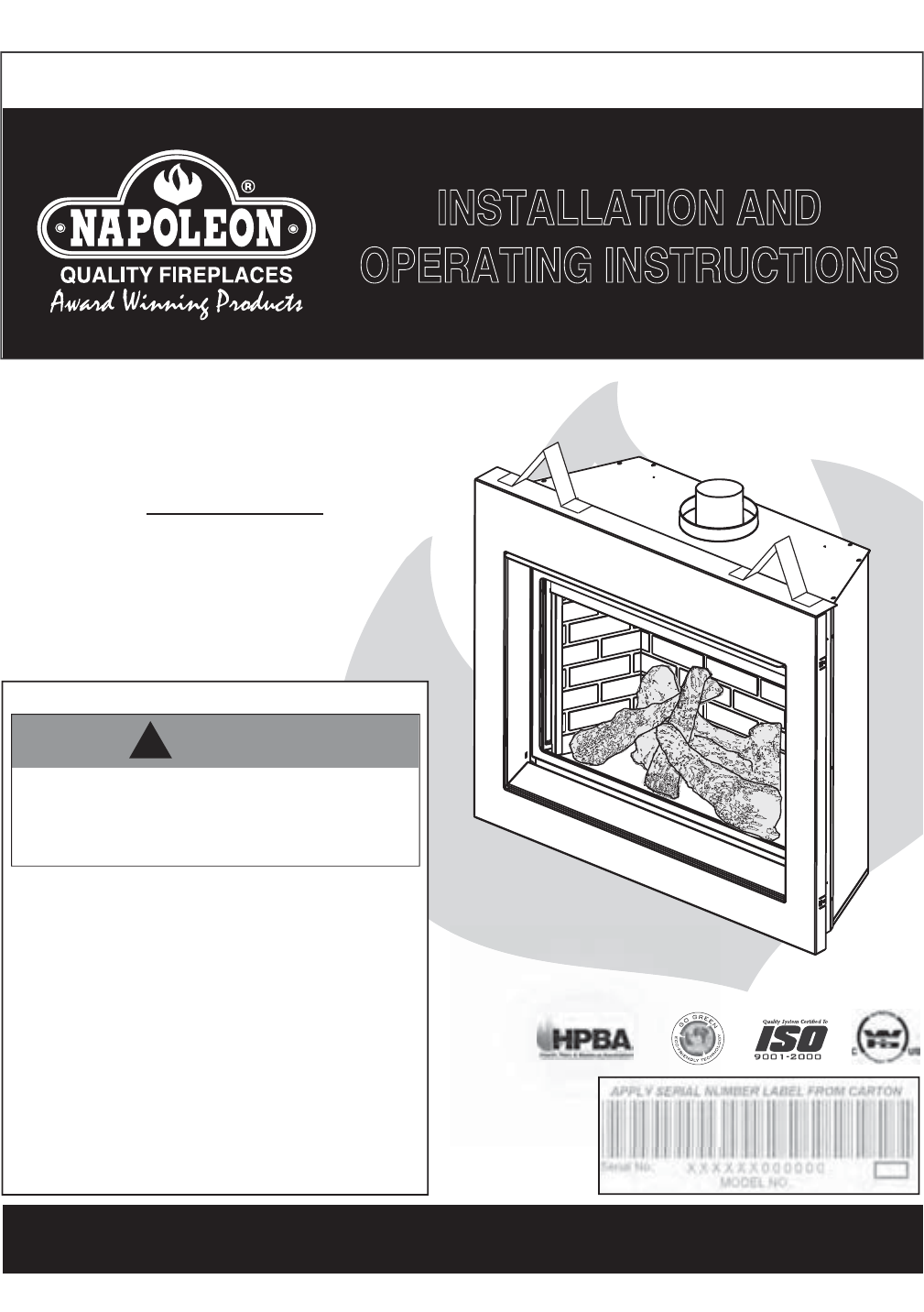
1
W415-0661 / C / 02.20.08
$10.00
SAFETY INFORMATION
- Do not store or use gasoline or other flammable
vapors and liquids in the vicinity of this or any
other appliance.
- WHAT TO DO IF YOU SMELL GAS:
- Do not try to light any appliance
- Do not touch any electrical switch; do
not use any phone in your building.
- Immediately call your gas supplier from
a neighbor's phone. Follow the gas
supplier’s instructions.
- If you cannot reach your gas supplier,
call the fire department.
- Installation and service must be performed by a
qualified installer, service agency or the supplier.
INSTALLER: LEAVE THIS MANUAL WITH THE APPLIANCE
CONSUMER: RETAIN THIS MANUAL FOR FUTURE REFERENCE
If the information in these instructions are
not followed exactly, a fire or explosion may
result causing property damage, personal
injury or loss of life.
!
WARNING
INSTALLATION AND
OPERATING INSTRUCTIONS
Wolf Steel Ltd., 24 Napoleon Rd., Barrie, ON, L4M 4Y8 Canada / 103 Miller Drive, Crittenden, Kentucky, USA, 41030
CERTIFIED UNDER CANADIAN AND AMERICAN NATIONAL STANDARDS: CSA 2.33, ANSI Z21.88 FOR VENTED GAS FIREPLACE HEATERS.
BGD36CFGN,
BGD36CFNTR & BGD42CFN
NATURAL GAS
BGD36CFGP,
BGD36CFPTR & BGD42CFP
PROPANE
BGD36CF Illustrated
CERTIFIED FOR CANADA AND UNITED STATES USING ANSI/CSA METHODS.
W415-0661 / C / 02.20.08
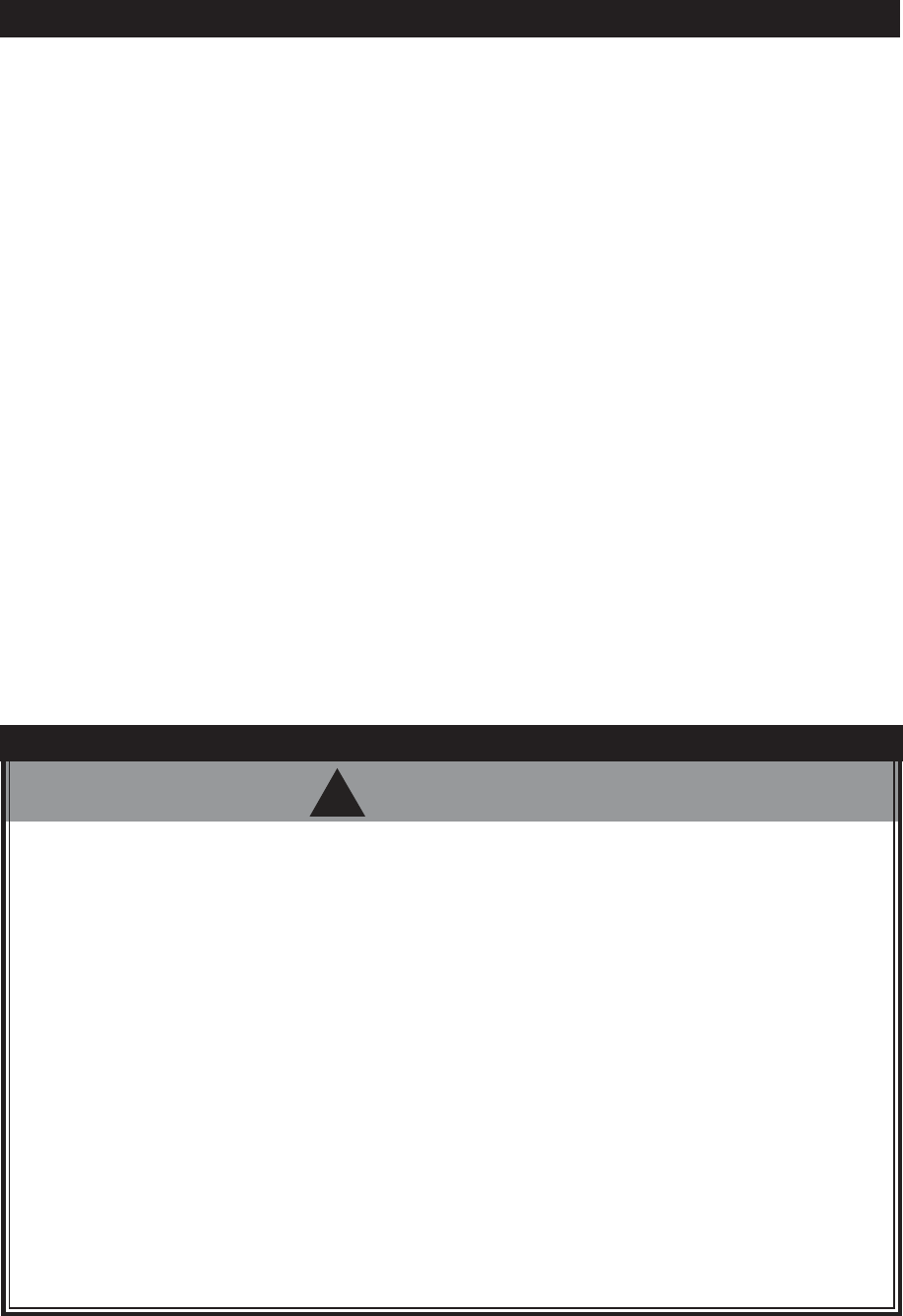
2
W415-0661 / C / 02.20.08
30-31 BGD42CF FINISHING
Door Installation / Removal
Removing Valve Access Door
Glass/Door Replacement
Door Trim
Grate Installation
Log Placement
32 COMMON FINISHING
Glowing Embers
Charcoal Embers
Vermiculite
Charcoal Lumps (BGD42CF Only)
Logo Placement
32 BGD36CFG FINISHING
Glass Burner Installation
BGD36CFG bulb replacement
BGD36CFG lens assembly replacement
33
OPTIONAL BLOWER INSTALLATION
BGD36CF Accessing the Blower
BGD42CF Accessing the Blower
Installing the Blower
34 OPTIONAL FAN INSTALLATION
GD36
THERMOSTATIC SENSOR CONTROL
35 BGD36CFG BURNER SWITCH/WIRING DIAGRAM
36 BGD36CFG LIGHT SWITCH/WIRING DIAGRAM
37 RECEPTACLE WIRING DIAGRAM
38 OPERATION BGD36CF AND BGD42CF
Operating Instructions
Maintenance
39 OPERATION / MAINTENANCE BGD36CFG
40-41 ADJUSTMENTS
Pilot Burner Adjustment
Venturi Adjustment
BGD36CFG Venturi Adjustment
Flame Adjustment
42-44 COMMON REPLACEMENTS
BGD36CF(G) REPLACEMENTS
BGD42CF REPLACEMENTS
45-48 TROUBLE SHOO
TING GUIDE
47 SERVICE HISTORY
48 NOTES
PG 4-5 INTRODUCTION
Warranty
General Instructions
General Information
Care of Glass & Plated Parts
Unit Dimensions
Installation Overview
6-19 VENTING
Venting Lengths
Minimum Air Terminal Location Clearances
T
ypical Minimum and Maximum Vent Lengths
Special Vent Installations
Venting Application Flow Chart
Venting Specifi cations
BGD36CF(G) Pre-Installation Preparation
Removing the Valve Access Door
Door Operation
Rear Exit
Top Exit
19-29 INSTALLATION
Wall and Ceiling Protection
Horizontal Installation
Adjustable Firestop Installation
Vertical Installation
Using Flexible Vent Components
Using Rigid Vent Components
Restricting Vertical Vents (BGD42CF ONLY)
Gas Installation
Optional wall switch installation excluding BGD36CFG
Mobile Home Installation
Framing
Installing Standoffs
BGD36CF(G) Minimum Mantel and Enclosure Clearances
Clean Face Surround Minimum Enclosure Clearances
Optional Clean Face Surround Installation BGD36CF(G) only
Finished Floor Installation
Hearth Installation
Optional Clean Face Trim Kit Installation
BGD42CF Minimum Mantel and Enclosure Clearances
30 BGD36CF FINISHING
Log Placement
Glass/Door Replacement
NOTE: CHANGES, OTHER THAN EDITORIAL, ARE DENOTED BY A VERTICAL LINE IN THE MARGIN.
PLEASE RETAIN THIS MANUAL FOR FUTURE REFERENCE
TABLE OF CONTENTS
• Do not burn wood or other materials in this fireplace.
• Adults and especially children should be alerted to the hazards of high surface temperatures and should stay away to avoid
burns or clothing ignition. Supervise young children when they are in the same room as the fireplace.
• Clothing or other flammable material should not be placed on or near the fireplace.
• Due to high temperatures, the fireplace should be located out of traffic and away from furniture and draperies.
• Ensure you have incorporated adequate safety measure to protect infants/toddlers from touching hot surfaces.
• Even after the fireplace is out, the glass and/or screen will remain hot for an extended period of time.
• Check with your local hearth specialty dealer for safety screens and hearth guards to protect children from hot surfaces. These
screens and guards must be fastened to the floor.
• Any safety screen or guard removed for servicing must be replaced prior to operating the fireplace.
• It is imperative that the control compartments, burners and circulating blower and its passageway in the fireplace and venting
system are kept clean. The fireplace and its venting system should be inspected before use and at least annually by a qualified
service person. More frequent cleaning may be required due to excessive lint from carpeting, bedding material, etc. The fireplace
area must be kept clear and free from combustible materials, gasoline and other flammable vapours and liquids.
• Under no circumstances should this fireplace be modified.
• This fireplace must not be connected to a chimney flue pipe serving a separate solid fuel burning appliance.
• Do not use this fireplace if any part has been under water. Immediately call a qualified service technician to inspect the fireplace
and to replace any part of the control system and any gas control which has been under water.
• Do not operate the fireplace with the glass door removed, cracked or broken. Replacement of the glass should be done by a
licensed or qualified service person.
• Do not strike or slam shut the fireplace glass door.
• This fireplace uses and requires a fast acting thermocouple. Replace only with a fast acting thermocouple supplied by Wolf
Steel Ltd.
• Pressure relief doors must be kept closed while the fireplace is operating to prevent exhaust fumes containing carbon monox-
ide, from entering into the home. Temperatures of the exhaust escaping through these openings can also cause the surrounding
combustible materials to overheat and catch fire.
• Only doors / optional fronts certified with the unit are to be installed on the appliance.
!
WARNING
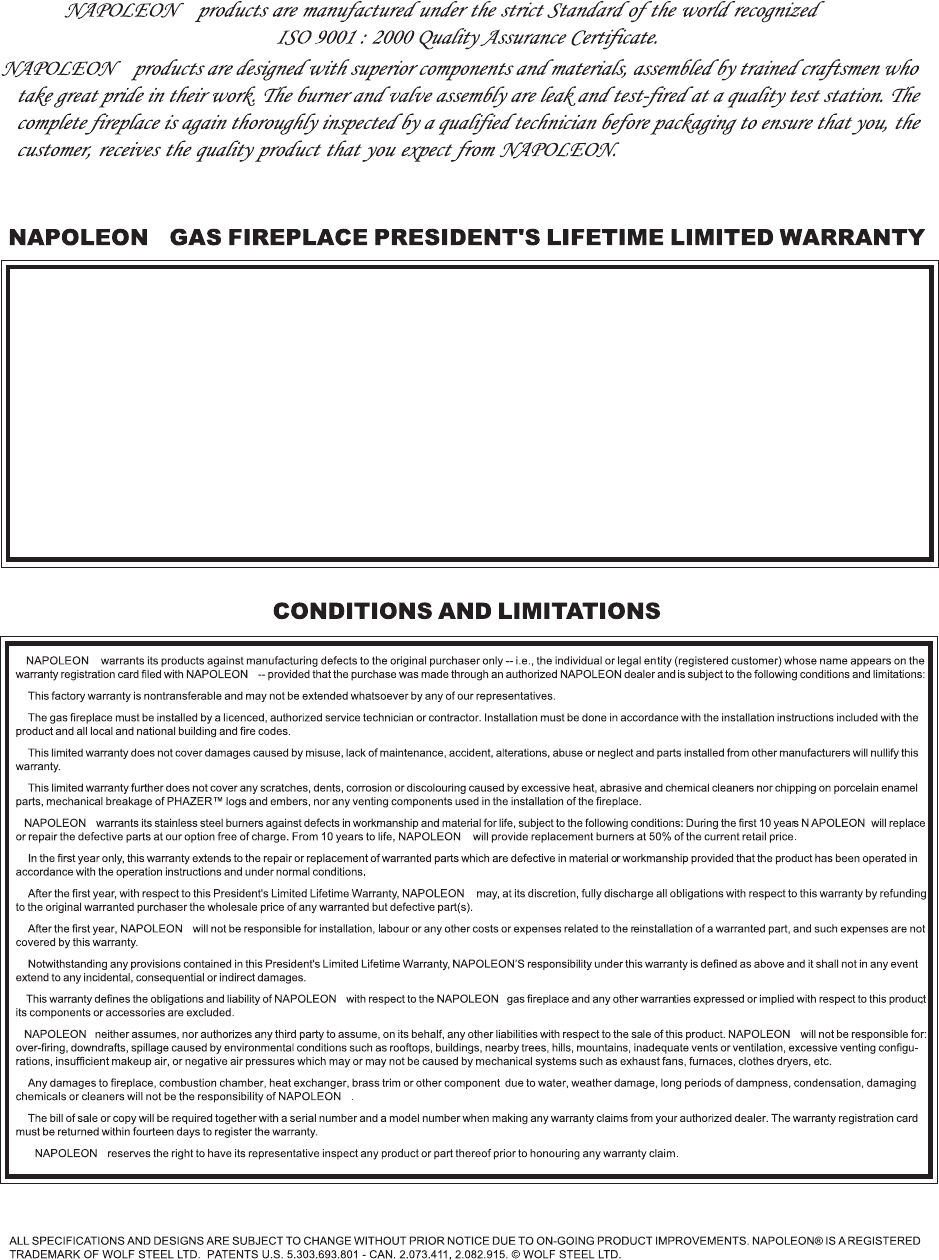
3
W415-0661 / C / 02.20.08
®
®
®
®
®
®
®
®
®
®
®
®®
®
®
®
®
The following materials and workmanship in your new NAPOLEON® gas fireplace are warranted against
defects for as long as you own the fireplace. This covers: combustion chamber, heat exchanger, stainless steel
burner, phazer™ logs and embers, gold plated parts against tarnishing, porcelainized enameled components and
aluminum extrusion trims.
Electrical (110V and millivolt) components and wearable parts such as blowers, gas valves, thermal switch,
switches, wiring, remote controls, ignitor, gasketing, and pilot assembly are covered and NAPOLEON® will
provide replacement parts free of charge during the first year of the limited warranty.
Labour related to warranty repair is covered free of charge during the first year. Repair work, however, requires
the prior approval of an authorized company official. Labour costs to the account of NAPOLEON® are based on
a predetermined rate schedule and any repair work must be done through an authorized NAPOLEON® dealer.
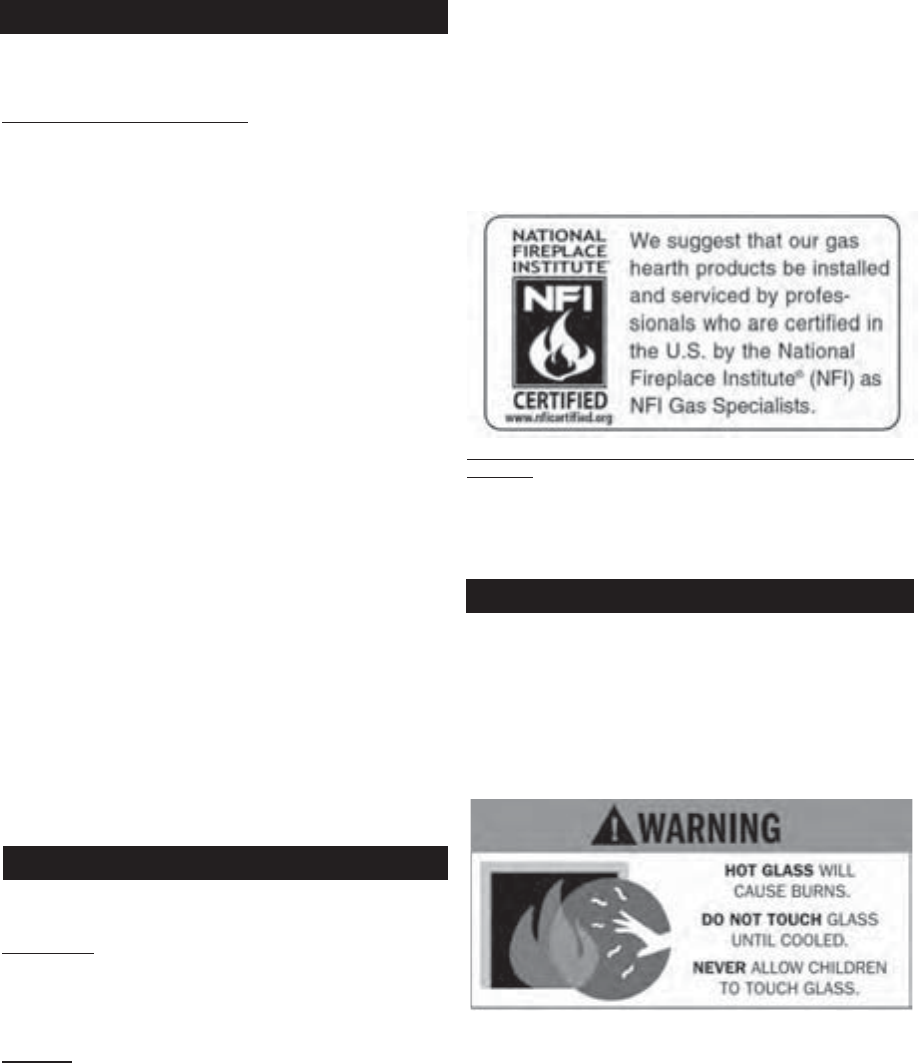
4
W415-0661 / C / 02.20.08
Maximum inlet gas pressure is 7" water column for natural gas and
13" water column for propane. Manifold pressure under fl ow condi-
tions is 3.5" water column for natural gas and 10" water column for
propane.
This fi replace is approved for bathroom, bedroom and bed-sitting
room installations and is suitable for mobile home installation.
No external electricity (110 volts or 24 volts) is required for the
gas system operation.
Expansion / contraction noises during heating up and
cooling down cycles are normal and are to be expected.
Use only accessories designed for and listed with your specifi c
fi replace.
Provide adequate ventilation air. Provide adequate accessibil-
ity clearance for servicing and operating the fi replace. Never
obstruct the front opening of the fi replace.
Objects placed in front of the fi replace must be kept a minimum
of 48" away from the front face of the unit.
Do not use abrasive cleaners to clean plated parts. Buff lightly with
a clean dry cloth. The BGD36CF(G) and BGD42CF are factory
equipped with tempered glass. The glass thickness is 3/16" for both
models. Use only replacement glass available from your Napoleon®
dealer. DO NOT SUBSTITUTE MATERIALS. Clean the glass after
the fi rst 10 hours of operation with a recommended gas fi replace
glass cleaner. Thereafter clean as required. DO NOT CLEAN GLASS
WHEN HOT! If the glass is not kept clean permanent discoloration
and / or blemishes may result.
THIS GAS FIREPLACE SHOULD BE INSTALLED AND SERVICED BY
A QUALIFIED INSTALLER to conform with local codes. Installation
practices vary from region to region and it is important to know the
specifi cs that apply to your area,
for example: in Massachusetts State:
• The fi replace damper must be removed or welded in the open
position prior to installation of a fi replace insert or gas log.
• A carbon monoxide detector is required in all rooms containing
gas fi red appliances
• The appliance off valve must be a “T” handle gas cock.
• The fl exible connector must not be longer than 36".
• The appliance is not approved for installation in a bedroom or
bathroom unless the unit is a direct vent sealed combustion
product.
• WARNING: This product must be installed by a licensed plumber
or gas fi tter when installed within the commonwealth of
Massachusetts.
In absence of local codes, install the BGD36CF(G) and BGD42CF
to the current National Fuel Gas Code, ANSI Z223.1, or the current
CAN/CGA B149, Installation Codes. Mobile home installation must
conform with local codes or in the absence of local codes, install
to the current standard for gas equipped mobile housing CAN/CSA
ZA240 MH Series in Canada or the Manufactured Home Construc-
tion and Safety Standard, Title 24 CFR, Part 3280, or the Fire Safety
Criteria for Manufactured Home Installations, Sites and Communities
Standard ANSI/NFPA 501A in the United States.
The fi replace and its individual shut off valve must be disconnected
from the gas supply piping system during any pressure testing of that
system at test pressures in excess of 1/2 psig (3.5 kPa). The fi replace
must be isolated from the gas supply piping system by closing its
individual manual shut off valve during any pressure testing of the
gas supply piping system at test pressures equal to or less than 1/2
psig (3.5 kPa).
When the fi replace is installed directly on carpeting, vinyl tile or
other combustible material other than wood fl ooring, the fi replace
shall be installed on a metal or wood panel extending the full width
and depth.
If the optional fan or blower is installed, the junction box must be
electrically connected and grounded in accordance with local codes.
In the absence of local codes, use the current CSA C22.1 CANADIAN
ELECTRICAL CODE in Canada or the ANSI/NFPA 70 NATIONAL
ELECTRICAL CODE in the United States.
All sections with BGD36CF(G) are common to both the BGD36CF
and the BGD36CFG.
FOR YOUR SATISFACTION, THIS FIREPLACE HAS BEEN TEST-
FIRED TO ASSURE ITS OPERATION AND QUALITY!
BGD36CF(G)
Maximum input for the BGD36CF(G) is 17,000 BTU/h for natural
gas and propane. Maximum output for natural gas and propane is
10,900 BTU/hr at an effi
ciency of 64% with the fan on. The A.F.U.E.
(annual fuel utilization effi ciency) rating is 53% for natural gas and
propane.
BGD42CF
Maximum input for the BGD42CF is 24,000 BTU/hr for natural gas
and propane. Maximum output for natural gas and propane is
16,000 BTU/hr at an effi ciency of 67% with the fan on. The A.F.U.E.
(annual fuel utilization effi ciency) rating is 61.5% for natural gas and
propane.
When the fi replace is installed at elevations above 4,500ft, and in the
absence of specifi c recommendations from the local authority having
jurisdiction, the certifi ed high altitude input rating shall be reduced at
the rate of 4% for each additional 1,000ft.
Minimum inlet gas supply pressure is 4.5" water column for natural
gas and 11" water column for propane.
GENERAL INSTRUCTIONS
GENERAL INFORMATION
CARE OF GLASS AND PLATED PARTS
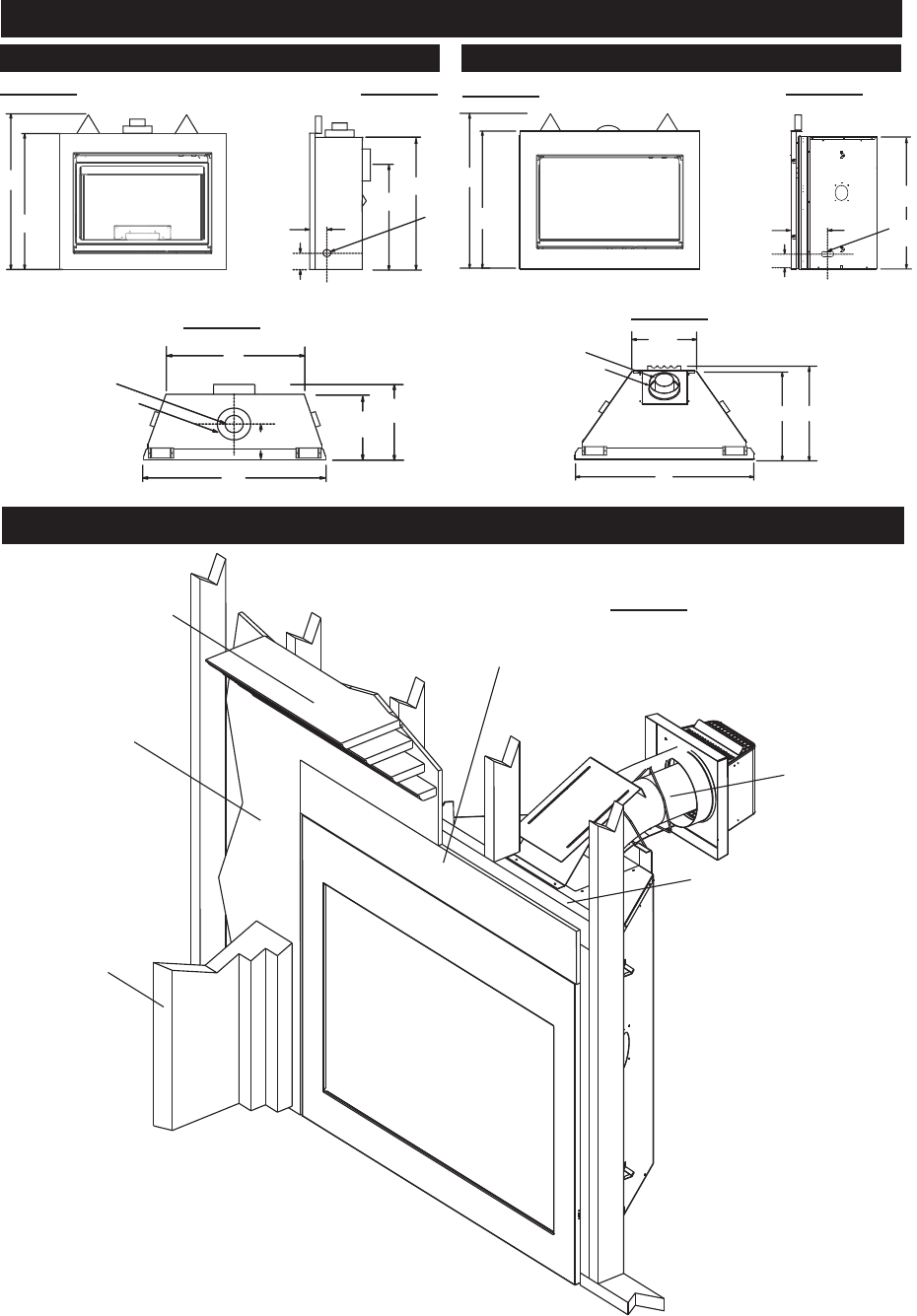
5
W415-0661 / C / 02.20.08
BGD36CF(G) BGD42CF
FIGURE 1
20
1
/
2
"
25"
46"
23"
5" DIA.
8" DIA.
3"
5
1
/
2
"
GAS
INLET
ELECTRICAL INLET
LEFT SIDE
24
1
/
4
"
38
1
/
2
"
34"
33"
17"
15"
T
40"
27"
10"
4" DIA.
7" DIA.
FIGURE 2
FIGURE 3
FIGURE 4
FIGURE 6
UNIT DIMENSIONS
3"
5
1
/2"
ELECTRICAL INLET
LEFT SIDE
41
1
/2"
37"
35 1/2"
GAS
INLET
FIGURE 5
INSTALLATION OVERVIEW
FIGURE 7
See the section “MINIMUM
MANTEL AND ENCLOSURE
CLEARANCES”
Side Wall
See the section
“INSTALLATION-FRAMING”
See the section
“VENTING” and
“INSTALLATION”
See the section
“FRAMING”
See the sections “MINI-
MUM ENCLOSURE
CLEARANCES” for drywall
(or other combustible
material)
See the sections “MINIMUM
ENCLOSURE CLEAR-
ANCES” for non-
combustible material
BGD42CF Illustrated
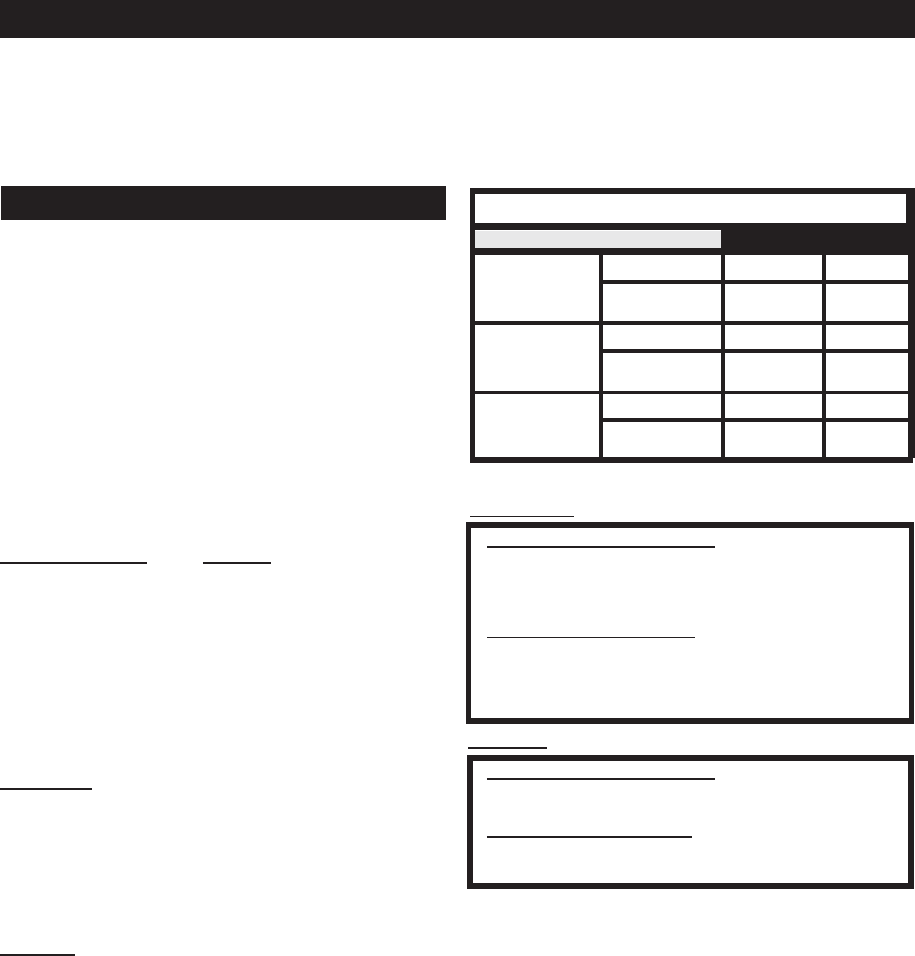
6
W415-0661 / C / 02.20.08
These vent kits allow for either horizontal or vertical venting of the
fi replace. The maximum allowable horizontal run is 20 feet. The
maximum allowable vertical vent length is 40 feet. The maximum
number of vent connections is two horizontally or three vertically
(excluding the fi replace and the air terminal connections) when us-
ing fl exible venting.
For optimum fl ame appearance and fi replace performance, keep
the vent length and number of elbows to a minimum.
REAR VENT
TOP VENT
CORNER
RIGID VENTING
FLEXIBLE
VENTING
RIGID VENTING
FLEXIBLE
VENTING
RIGID VENTING
FLEXIBLE
VENTING
REQUIRED RISE ON HORIZONTAL VENTING
BGD36CF(G)
BGD42CF
0" / FT
0" / FT
0" / FT
0" / FT
0" / FT
0" / FT
0" / FT
0" / FT
0"
6"
0"
0"
HORIZONTAL VENT SECTIONS: - A minimum clearance
of 1" at the bottom and sides of the vent and 2" at the top on
all horizontal runs to combustibles is required. The fi restop
spacer (W010-1774) supplied with the unit must be used to
maintain this clearance.
VERTICAL VENT SECTIONS: - A minimum of 1" all around
the vent pipe on all vertical runs to combustibles is required
except for clearances in fi replace enclosures. See "MINIMUM
ENCLOSURE CLEARANCES" section. Use fi restop spacer
W500-0096 (not supplied).
BGD36CF(G)
BGD42CF
Use only Wolf Steel, Simpson Dura-Vent, Selkirk Direct Temp or
American Metal Amerivent venting components. Minimum and maxi-
mum vent lengths, for both horizontal and vertical installations, and
air terminal locations for either system are set out in this manual and
must be adhered to. For Simpson Dura-Vent, Selkirk Direct Temp and
American Metal Amerivent, follow the installation procedure provided
with the venting components.
A starter adaptor must be used with the following vent systems and
may be purchased from the corresponding supplier:
PART
4"/7" 5"/8" SUPPLIER
Duravent W175-0053 W175-0170 Wolf Steel
Amerivent 4DSC-N2 5DSC-N American Metal
Direct Temp 4DT-AAN 5DT-AA Selkirk
For Simpson Dura-Vent, Selkirk Direct Temp and American Metal
Amerivent, follow the installation procedure found on the website for
your venting supplier.
VENTING SUPPLIER WEBSITE
Simpson Dura-V
ent www.duravent.com
Selkirk Direct Temp www.selkirkcorp.com
American Metal Amerivent www.americanmetalproducts.com
For vent systems that provide seals on the inner exhaust fl ue, only the
outer air intake joints must be sealed using a red high temperature
silicone (RTV). This same sealant may be used on both the inner
exhaust and outer intake vent pipe joints of all other approved vent
systems except for the exhaust vent pipe connection to the fi replace
fl ue collar which must be sealed using the black high temperature
sealant Mill Pac.
BGD36CF(G)
When using Wolf Steel venting components, use only approved Wolf
Steel rigid / fl exible components with the following termination kits:
W
ALL TERMINAL KIT GD222, or 1/12 to 7/12 PITCH ROOF TERMI-
NAL KIT GD110, 8/12 to 12/12 ROOF TERMINAL KIT GD111, FLAT
ROOF TERMINAL KIT GD112 or PERISCOPE KIT GD201 (for wall
penetration below grade). With fl exible venting, in conjunction with
the various terminations, use either the 5 FOOT VENT KIT GD220
or the 10 FOOT VENT KIT GD330.
BGD42CF
When using Wolf Steel venting components, use only approved Wolf
Steel fl exible components with the following termination kits: W
ALL
TERMINAL KIT GD422, or 1/12 to 7/12 PITCH ROOF TERMINAL
KIT GD410, 8/12 to 12/12 ROOF TERMINAL KIT GD411, FLAT
ROOF TERMINAL KIT GD412 or PERISCOPE KIT GD401 (for wall
penetration below grade). With fl exible venting, in conjunction with
the various terminations, use either the 5 FOOT VENT KIT GD420
or the 10 FOOT VENT KIT GD430.
Wolf Steel, Simpson Dura-Vent, Selkirk Direct Temp or Ameri-
can Metal Amerivent venting systems must not be combined.
Wolf Steel rigid and flexible venting systems must not be
combined.
MODEL BGD36CF MA
Y BE VENTED EITHER
AS A TOP VENT OR A REAR VENT.
REFER TO THE SECTION APPLICABLE TO YOUR INSTALLATION.
VENTING LENGTHS
THE BGD36CF(G) USES: 4" EXHAUST / 7" AIR INTAKE VENT PIPE
THE BGD42CF USES: 5" EXHAUST / 8" AIR INTAKE VENT PIPE
For safe and proper operation of the fi replace follow the venting instruction exactly. Deviation from the minimum vertical vent length
can create diffi culty in burner start-up and/or carboning. Provide a means for visually checking the vent connection to the fi replace
after the fi replace is installed. Vent lengths that pass through unheated spaces (attics, garages, crawl spaces) should be insulated
with the insulation wrapped in a protective sleeve to minimize condensation.
VENTING
HORIZONTAL VENT SECTIONS: A minimum clearance of 2"
all around the vent pipe on all horizontal runs to combustibles
is required. Use fi restop spacer W010-1778 (supplied).
VERTICAL VENT SECTIONS: A minimum of 1" all around the
vent pipe on all vertical runs to combustibles is required. Use
fi restop spacer W500-0028 (not supplied).
For optimum performance, it is recommended that all horizontal
runs have a 1" rise per foot.
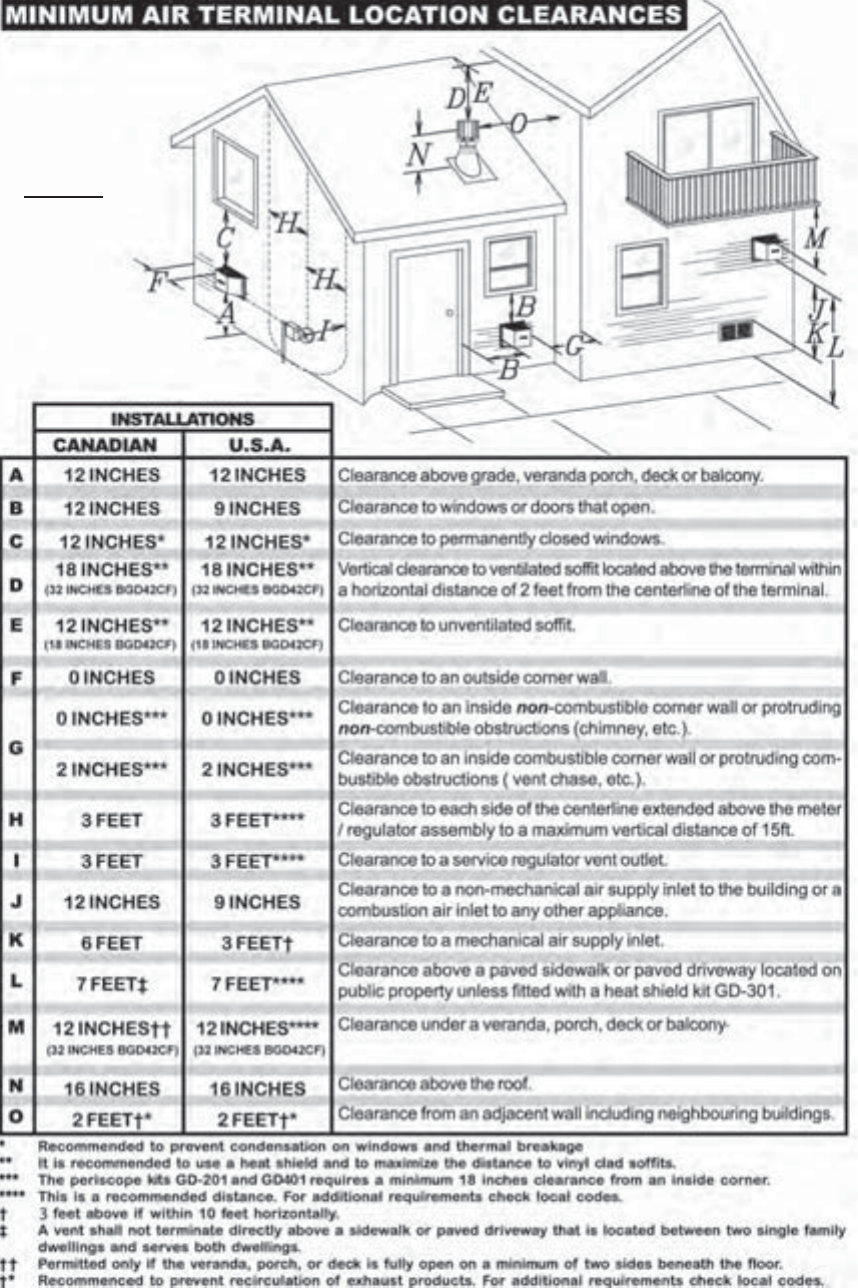
7
W415-0661 / C / 02.20.08
FIGURE 8
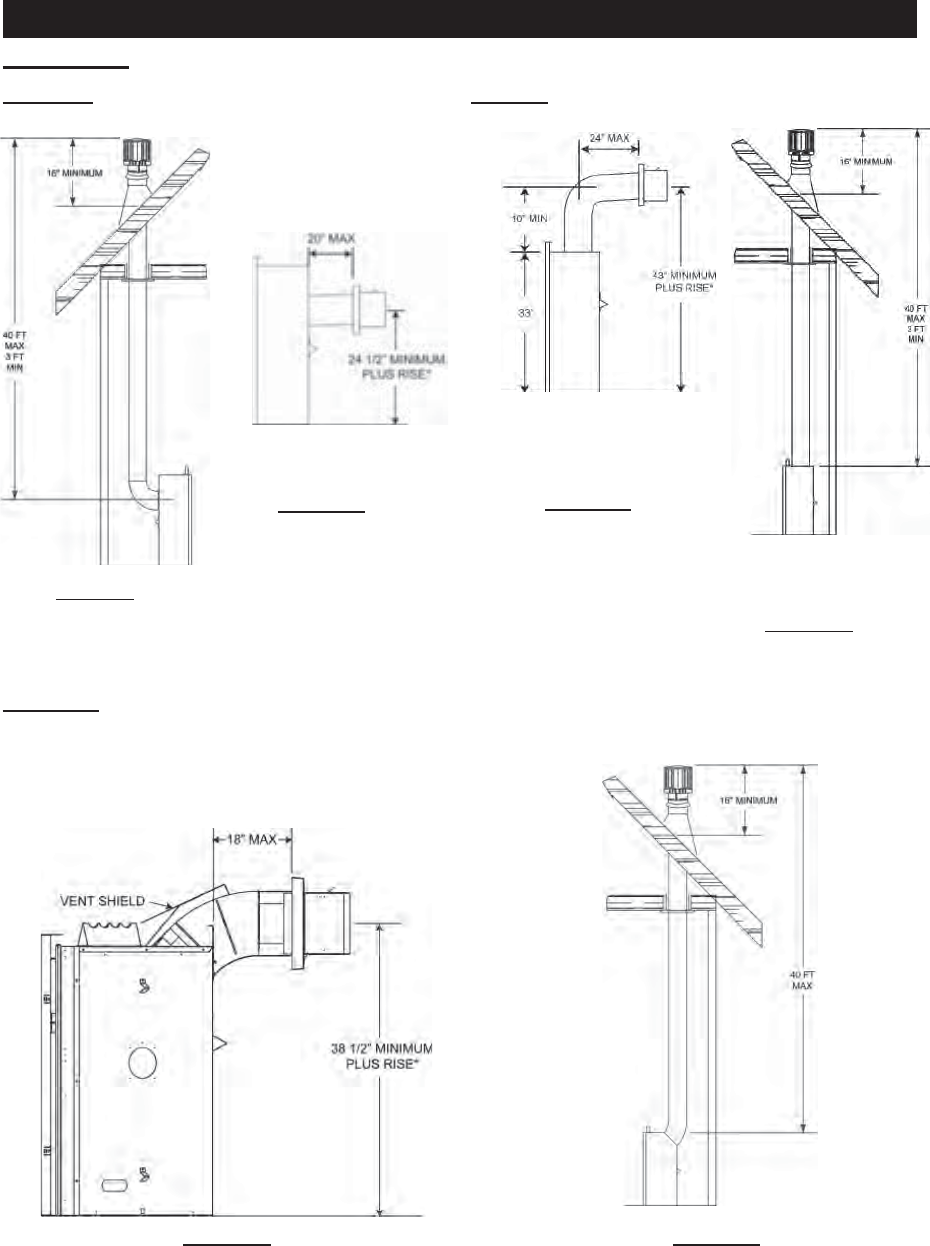
8
W415-0661 / C / 02.20.08
TYPICAL MINIMUM AND MAXIMUM VENT LENGTHS
For optimum performance, it is recommended that all horizontal runs
have a 1" rise per foot.
When terminating vertically, the vertical rise is a minimum 3 feet and
a maximum 40 feet from the centre of the fi replace fl ue outlet.
NOTE: When terminating vertically, the restrictor plate W500-0205 must be installed. Refer to
Restricting Vertical Vents.
REAR EXIT
TOP EXIT
BGD36CF(G)
BGD42CF
FIGURE 10
FIGURE 9
FIGURE 11
FIGURE 12
FIGURE 13
FIGURE 14
* See Venting Section
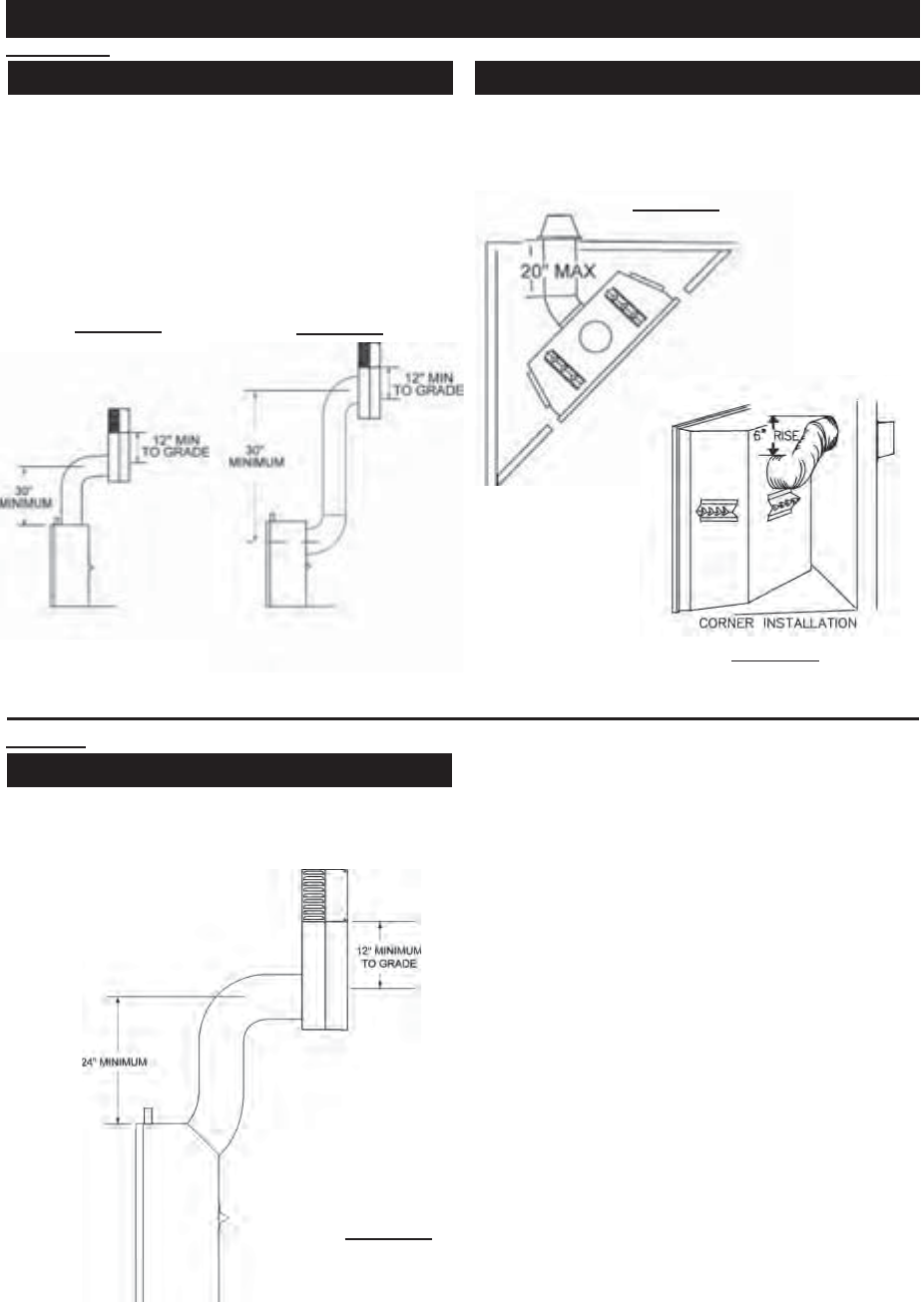
9
W415-0661 / C / 02.20.08
SPECIAL VENT INSTALLATIONS
Use the GD201 periscope kit to locate the air termination above
grade. The periscope must be installed so that when fi nal grading
is completed, the bottom air slot is located a minimum of 12" above
grade. The maximum allowable vent length is 10'.
REAR EXIT INSTALLATION
TOP EXIT INSTALLATION
The maximum vent length for a corner installation is 20" of horizontal
run, in addition to the 45° offset. In this case zero rise is acceptable
when using rigid. See FIGURE 18. Flexible venting must maintain a
6" rise. See FIGURE 19.
PERISCOPE TERMINATION CORNER TERMINATION
BGD36CF(G)
BGD42CF
PERISCOPE TERMINATION
Use the GD401 periscope kit to locate the air termination above
grade. The periscope must be installed so that when fi nal grading
is completed, the bottom air slot is located a minimum of 12" above
grade. The maximum allowable vent length is 10'.
FIGURE 15
FIGURE 16
FIGURE 18
FIGURE 19
FIGURE 17
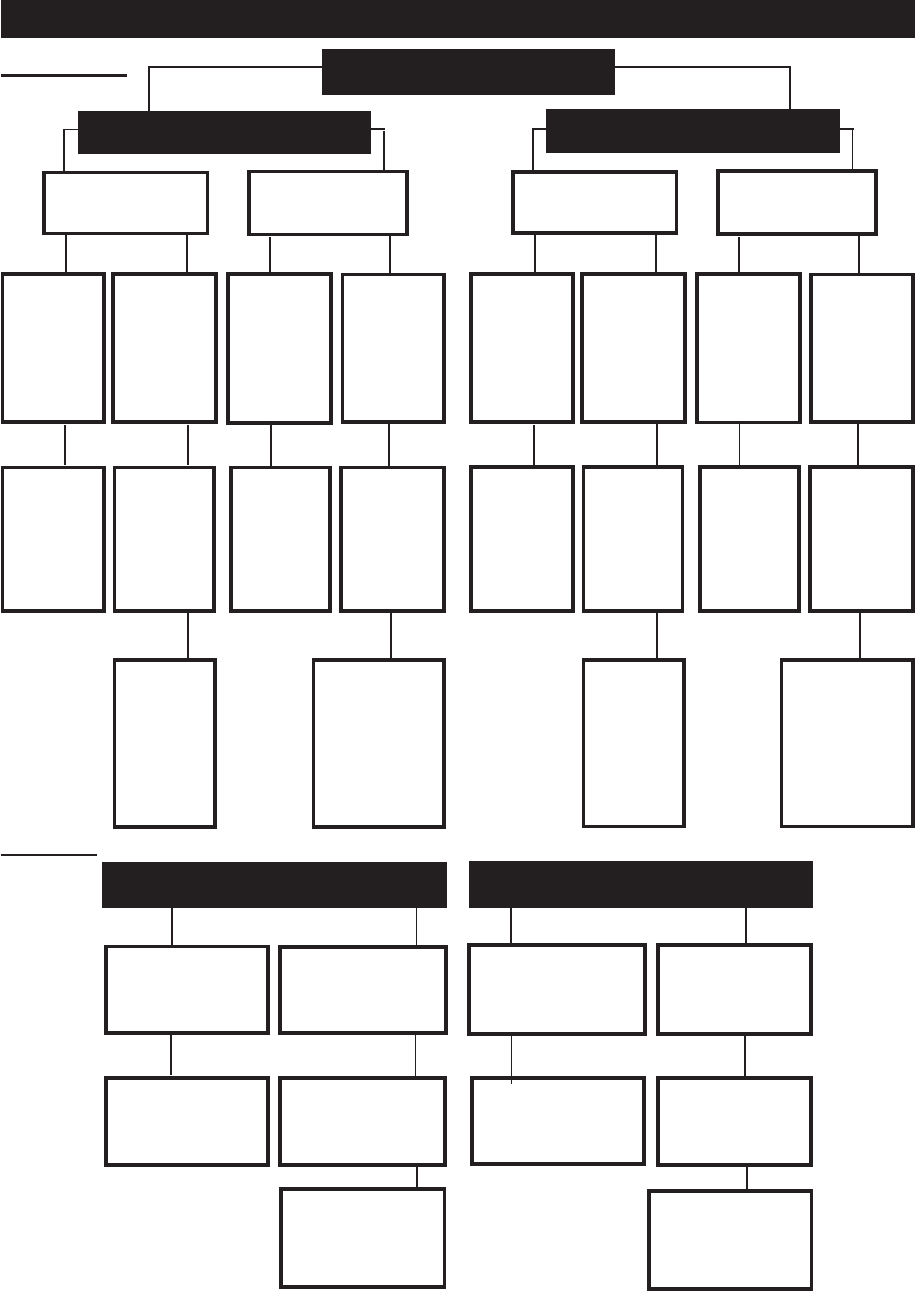
10
W415-0661 / C / 02.20.08
FIREPLACE VENT EXIT
REAR EXIT
TOP EXIT
Horizontal
Termination
Vertical
Termination
Vertical
rise is
equal to
or greater
than the
horizontal
run
Vertical
rise is
less than
horizontal
run
Horizon-
tal run +
vertical
rise to
maximum
of 40 feet
Horizontal
run + verti-
cal rise to
maximum
of 24.75
feet
3.5 times
the verti-
cal rise
equal to
or greater
than the
horizontal
run
Vertical
rise is
equal to
or greater
than the
horizontal
run
Horizon-
tal run +
vertical
rise to
maximum
of 40 feet
Vertical
rise is
less than
horizontal
run
Horizon-
tal run +
vertical
rise to
maximum
of 40 feet
3 times
The
vertical rise
equal to or
greater than
the horizontal
run
VENTING APPLICATION FLOW CHART
BGD36CF(G)
BGD42CF
Horizontal
Termination
Vertical
Termination
Vertical
rise is
equal to
or greater
than the
horizontal
run
Vertical
rise is
less than
horizontal
run
Horizon-
tal run +
vertical
rise to
maximum
of 40 feet
Horizontal
run + verti-
cal rise to
maximum
of 24.75
feet
4.2 times
the verti-
cal rise
equal to
or greater
than the
horizontal
run
Vertical
rise is
equal to
or greater
than the
horizontal
run
Horizon-
tal run +
vertical
rise to
maximum
of 40 feet
Vertical
rise is
less than
horizontal
run
Horizon-
tal run +
vertical
rise to
maximum
of 40 feet
3 times The
vertical rise
equal to or
greater than
the horizontal
run
HORIZONTAL TERMINATION
VERTICAL TERMINATION
Vertical rise is
equal to or greater
than the horizontal
run
Vertical rise is less
than horizontal run
Horizontal run
+ vertical rise to
maximum of 40
feet
Horizontal run +
vertical rise to maxi-
mum of 24.75 feet
4.2 times the verti-
cal rise equal to or
greater than the
horizontal run
Vertical rise is equal
to or greater than
the horizontal run
Horizontal run
+ vertical rise to
maximum of 40
feet
Vertical rise is
less than hori-
zontal run
Horizontal run
+ vertical rise to
maximum of 40
feet
3 times The
vertical rise equal
to or greater than
the horizontal run
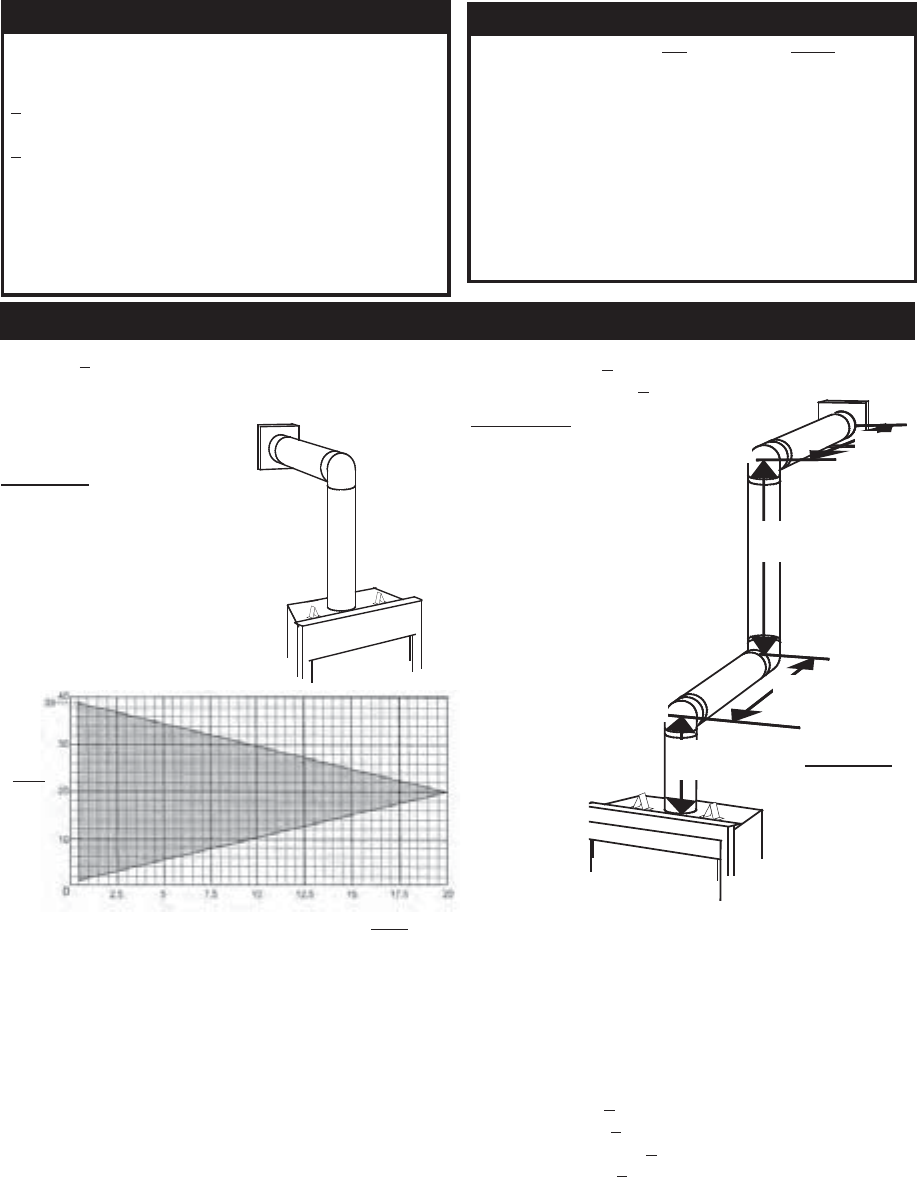
11
W415-0661 / C / 02.20.08
90°
90°
90°
H
1
V
2
H
2
V
1
when (H
T
) < (V
T
)
Simple venting confi guration (only one 90° elbow)
See graph to determine the required vertical rise V
T
for the required
horizontal run H
T
.
VERTICAL
RISE IN FEET
V
T
For vent configurations requiring more
than one 90° elbow, the following formulas
apply:
Formula 1: H
T
< V
T
Formula 2: H
T
+ V
T
< 40 feet
Example 1:
V
1
= 3 ft
V
2
= 8 ft
V
T
=
V
1
+
V
2
=
3 + 8 = 11 ft
H
1
= 2.5 ft
H
2
= 2 ft
H
R
= H
1
+ H
2
= 2.5 + 2 = 4.5 ft
H
O
= .
03 (three 90° elbows - 90°) = .03(270° - 90°) = 5.4 ft
H
T
= H
R
+ H
O
= 4.5 + 5.4 = 9.9 ft
H
T
+ V
T
= 9.9 + 11 = 20.9 ft
Formula 1: H
T
< V
T
9.9 < 11
Formula 2: H
T
+ V
T
< 40 feet
20.9 < 40
Since both formulas are met, this vent confi guration is ac-
ceptable.
HORIZONTAL VENT RUN PLUS OFFSET IN FEET H
T
The shaded area within the lines represents acceptable values
for H
T
and V
T
.
for the following symbols used in the venting calculations and
examples are:
> - greater than
> - equal to or greater than
< - less than
< - equal to or less than
H
T
- total of both horizontal vent lengths (H
R
) and offsets
(H
O
) in feet
H
R
- combined horizontal vent lengths in feet
H
O
- offset factor: .03 (total degrees of offset - 90°*) in
feet
V
T
- combined vertical vent lengths in feet
feet inches
1° 0.03 0.5
15° 0.45 6.0
30° 0.9 11.0
45°* 1.35 16.0
90°* 2.7 32.0
* BGD36CF the fi rst 90° offset has a zero value and is shown in
the formula as - 90°
* BGD42CF the fi rst 45° and 90° offset has a zero value and
is shown in the formula as -45° and - 90° respectively or -135°
combined.
DEFINITIONS
ELBOW VENT LENGTH VALUES
BGD36CF(G) TOP EXIT / HORIZONTAL TERMINATION
FIGURE 20
FIGURE 21
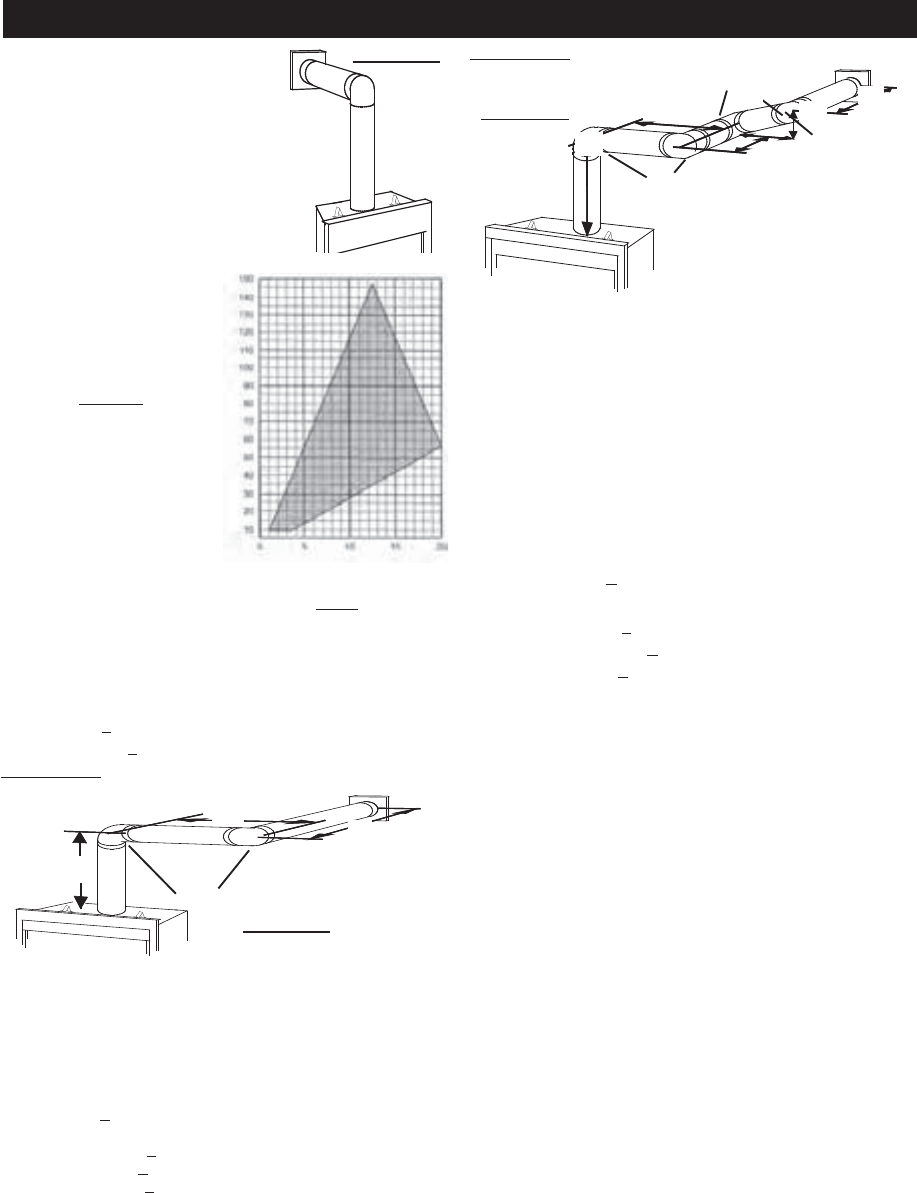
12
W415-0661 / C / 02.20.08
For vent confi gurations requiring more than one 90° elbow the fol-
lowing formulas apply:
Formula 1: H
T
< 4.2 V
T
Formula 2: H
T
+ V
T
< 24.75 feet
Example 2:
See graph to determine the required vertical
rise V
T
for the required horizontal run H
T
.
V
1
=V
T
= 6 ft
H
1
=3 ft
H
2
=5 ft
H
R
=H
1
+ H
2
= 3 + 5 = 8 ft
H
O
=.03 (two 90° elbows - 90°) = .03(180° - 90°) = 2.7 ft
H
T
=H
R
+ H
O
= 8 + 2.7 = 10.7 ft
H
T
+ V
T
=
10.7 + 6 =16.7
Formula 1: H
T
< 4.2 V
T
4.2 V
T
= 4.2 x 6 = 25.2 ft
10.7 < 25.2
Formula 2: H
T
+ V
T
< 24.75 feet
16.7 < 24.75
Since both formulas are met, this vent confi guration is acceptable.
REQUIRED VERTICAL RISE
IN INCHES V
T
HORIZONTAL VENT
RUN PLUS OFFSET IN
FEET H
T
The shaded area within the lines represents acceptable values
for H
T
and V
T
.
when (H
T
) > (V
T
)
Simple venting confi guration (only one 90°
elbow)
BGD36CF(G) TOP EXIT / HORIZONTAL TERMINATION
H
2
H
1
V
1
90°
FIGURE 23
H
2
H
4
V
2
90°
H
3
H
1
V
1
90°
FIGURE 24
FIGURE 22
Example 3:
V
1
= 4 ft
V
2
= 1.5 ft
V
T
= V
1
+ V
2
= 4 + 1.5 = 5.5 ft
H
1
= 2 ft
H
2
= 1 ft
H
3
= 1 ft
H
4
= 1.5 ft
H
R
= H
1
+ H
2
+ H
3
+ H
4
= 2 + 1 + 1 + 1. 5 = 5.5 ft
H
O
= .03 (four 90° elbows - 90°) = .03(360° - 90°) = 8.1 ft
H
T
= H
R
+ H
O
= 5.5 + 8.1 = 13.6 ft
H
T
+ V
T
= 13.6 + 5.5 = 19.1 ft
Formula 1: H
T
< 4.2 V
T
4.2 V
T
= 4.2 x 5.5 = 23.1 ft
13.6 < 23.1
Formula 2: H
T
+ V
T
< 24.75 feet
19.1 < 24.75
Since both formulas are met, this vent confi guration is ac-
ceptable.
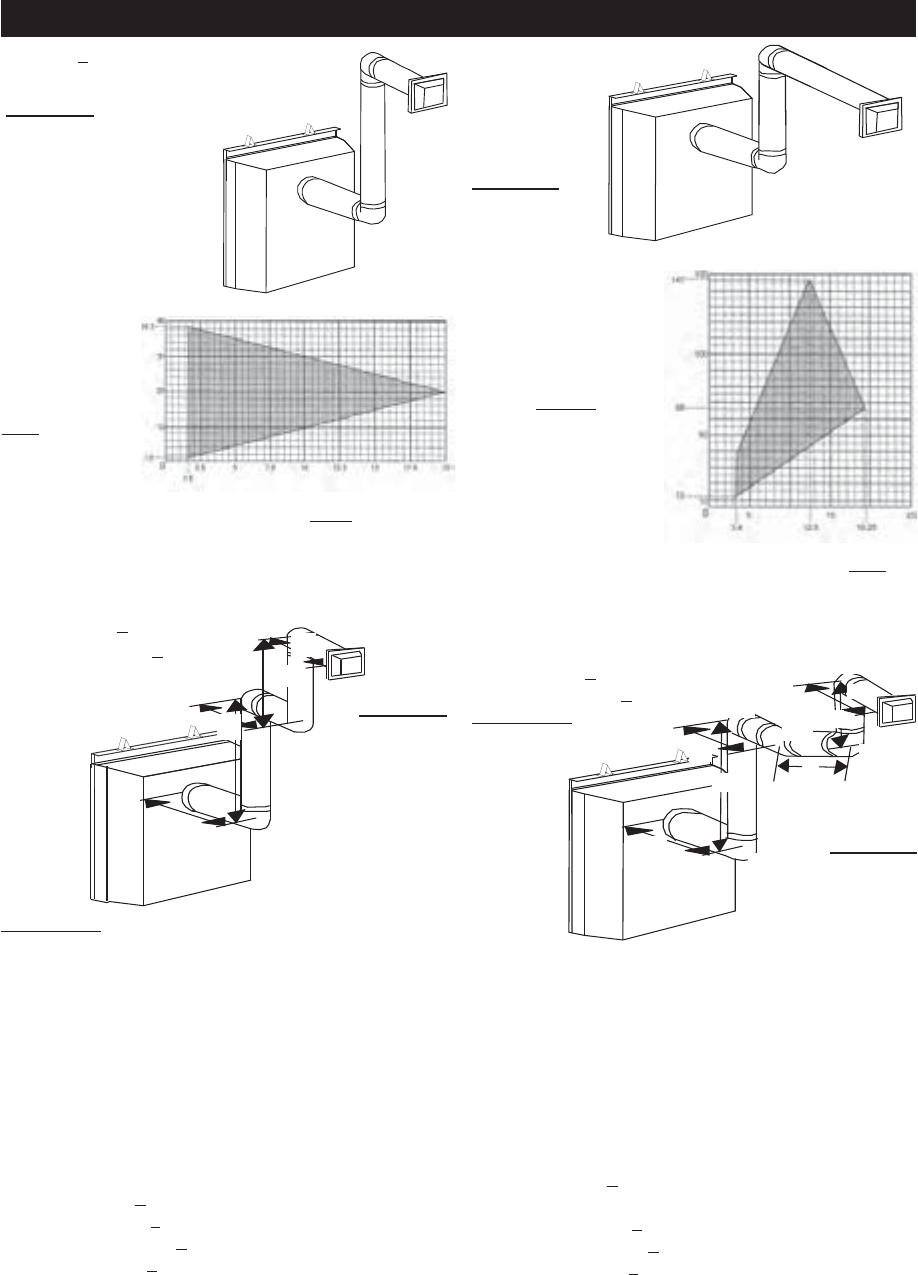
13
W415-0661 / C / 02.20.08
See graph to determine the required vertical rise V
T
for the required
horizontal run H
T
For vent confi gurations requiring more than two 90° elbows the fol-
lowing formulas apply:
Formula 1: H
T
< V
T
REQUIRED VER-
TICAL RISE IN
FEET
V
T
HORIZONTAL VENT RUN PLUS OFF-
SETS IN FEET H
T
Formula 2: H
T
+ V
T
< 40 feet
Example 4:
V
1
= 9 ft
V
2
= 6 ft
V
T
=
V
1
+
V
2
=
9 + 6 = 15 ft
H
1
= 3 ft
H
2
= 2 ft
H
3
= 1.5 ft
H
R
= H
1
+ H
2
+ H
3
= 3 + 2 + 1.5 = 6.5 ft
H
O
= .03 (four 90° elbows - 90°)
= .03(90 + 90 + 90 + 90 - 90) = 8.1 ft
H
T
= H
R
+ H
O
= 6.5 + 8.1 = 14.6 ft
H
T
+ V
T
= 14.6 + 15 = 29.6 ft
Formula 1: H
T
< V
T
14.6 < 15
Formula 2: H
T
+ V
T
< 40 feet
29.6 < 40
Since both formulas are met, this vent confi guration is ac-
ceptable.
The shaded area within the lines represents acceptable values
for H
T
and V
T
.
BGD36CF(G) REAR EXIT / HORIZONTAL TERMINATION
when (H
T
) < (V
T
)
Simple venting confi guration (only two 90° elbows)
FIGURE 25
H
2
V
1
V
2
H
3
90°
90°
90°
90°
H
1
FIGURE 26
Example 5:
V
1
=4 ft
V
2
=1.5 ft
V
T
=
V
1
+
V
2
=
4 + 1.5 = 5.5 ft
H
1
=2 ft
H
2
=1 ft
H
3
=1 ft
H
4
=1.5 ft
H
R
=H
1
+ H
2
+ H
3
+ H
4
= 2 + 1 + 1 + 1.5 = 5.5 ft
H
O
=.03 (four 90° elbows + one 45° elbow - 90°)
=.03(90 + 90 + 90 + 90 + 45 - 90) = 9.45 ft
H
T
=H
R
+ H
O
= 5.5 + 9.45 = 14.95 ft
H
T
+ V
T
= 14.95 + 5.5 = 20.45 ft
Formula 1: H
T
< 3.5V
T
3.5V
T
=
3.5 x
5.5 = 19.25 ft
14.95 < 19.25
Formula 2: H
T
+ V
T
< 24.75 feet
20.45 < 24.75
Since both formulas are met, this vent confi guration is ac-
ceptable.
For vent confi gurations requiring more than two 90° elbows the fol-
lowing formulas apply:
Formula 1: H
T
< 3.5V
T
Formula 2: H
T
+ V
T
< 24.75 feet
REQUIRED VERTICAL
RISE IN INCHES
HORIZONTAL VENT RUN
PLUS OFFSETS IN FEET
H
T
See graph to determine the required vertical rise V
T
for the required
horizontal run H
T
V
T
The shaded area within the lines represents acceptable
values for H
T
and V
T
.
FIGURE 27
H
1
H
2
H
3
H
4
V
1
V
2
90°
90°
45°
90°
90°
FIGURE 28
when (H
T
) > (V
T
)
Simple venting
confi guration (only
two 90° elbows)
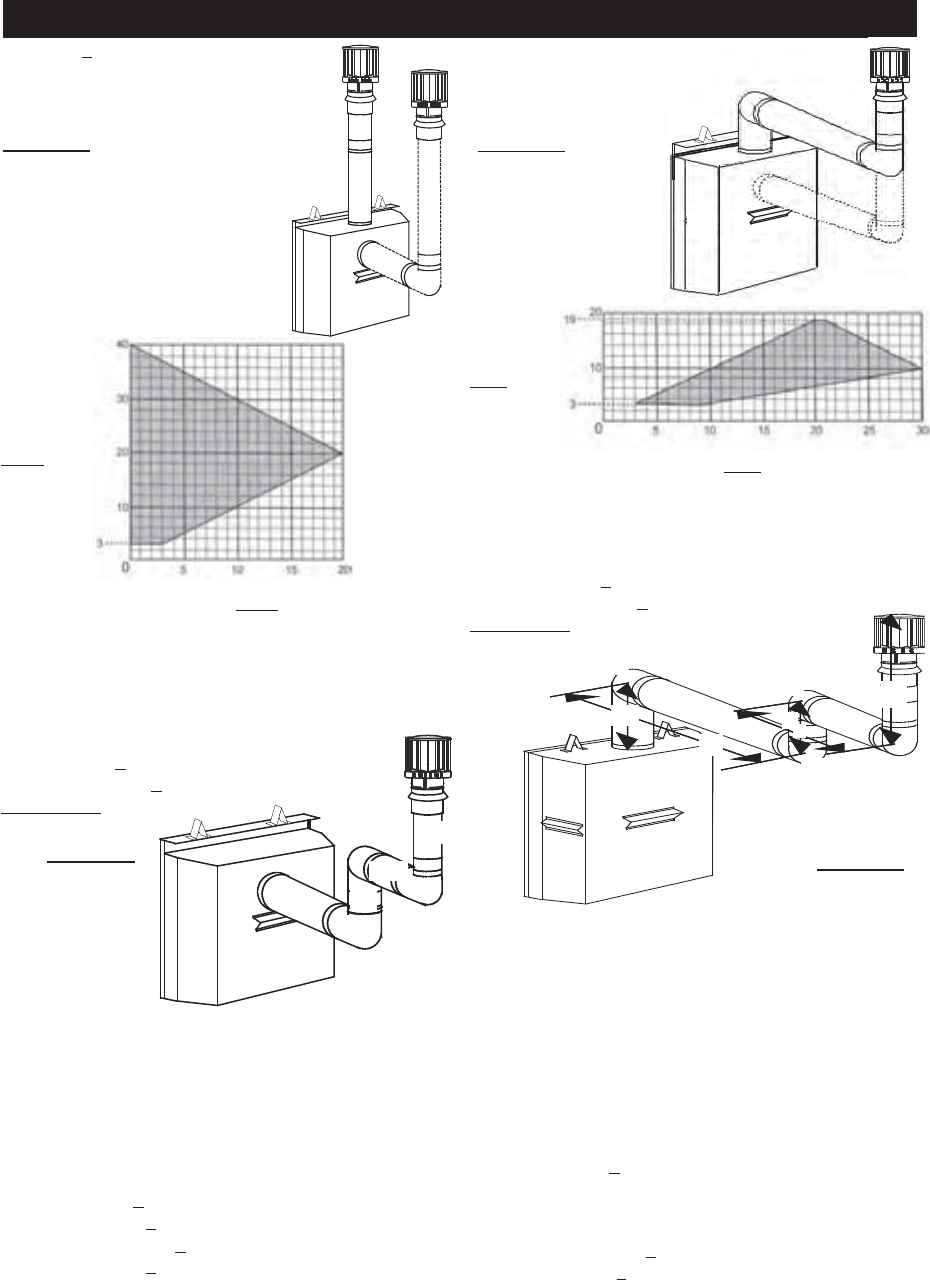
14
W415-0661 / C / 02.20.08
REQUIRED
VERTICAL
RISE IN
FEET
V
T
HORIZONTAL VENT RUN PLUS
OFFSET IN FEET
H
T
The shaded area within the lines represents acceptable values
for H
T
and V
T
.
V
1
=5 ft
V
2
=10 ft
V
T
=
V
1
+
V
2
=
5 + 10 = 15 ft
H
1
=3 ft
H
2
=2.5 ft
H
R
=H
1
+ H
2
= 3 + 2.5 = 5.5 ft
H
O
=.03 (three 90° elbows - 90°)
=.03(90 + 90 + 90 - 90) = 5.4 ft
H
T
=H
R
+ H
O
= 5.5 + 5.4 = 10.9 ft
H
T
+ V
T
= 10.9 + 15 = 25.9 ft
Formula 1: H
T
< V
T
10.9 < 15
Formula 2: H
T
+ V
T
< 40 feet
25.9 < 40
Since both formulas are met, this vent confi guration is ac-
ceptable.
when (H
T
) < (V
T
)
Simple venting confi guration (only two
90° elbows)
See graph to determine the required vertical rise V
T
for the required
horizontal run H
T
For vent confi gurations requiring more than zero 90° elbow (top exit)
or one 90° elbow (rear exit), the following formulas apply:
Formula 1: H
T
< V
T
Formula 2: H
T
+ V
T
< 40 feet
Example 6:
90°
90°
90°
H
1
H
2
V
1
V
2
BGD36CF(G) TOP OR REAR EXIT VERTICAL TERMINATION
FIGURE 29
FIGURE 30
MAXIMUM
VERTICAL
RISE IN
FEET
V
T
HORIZONTAL VENT RUN PLUS OFFSET IN
FEET
H
T
The shaded area within the lines represents acceptable values
for H
T
and V
T
.
For vent confi gurations requiring more than two 90° elbows (top exit)
or one 90° elbow (rear exit), the following formulas apply:
Formula 1: H
T
< 3V
T
Formula 2: H
T
+ V
T
< 40 feet
Example 7:
See graph to determine
the required vertical rise V
T
for the required horizontal
run H
T
.
V
1
= 2 ft
V
2
= 1 ft
V
3
= 1.5 ft
V
T
=
V
1
+
V
2
+
V
3
=
2 + 1 + 1.5 = 4.5 ft
H
1
= 6 ft
H
2
= 2 ft
H
R
= H
1
+ H
2
= 6 + 2 = 8 ft
H
O
= .03 (four 90° elbows - 90°)
= .03(90 + 90 + 90 + 90 - 90) = 8.1 ft
H
T
= H
R
+ H
O
= 8 + 8.1 = 16.1 ft
H
T
+ V
T
= 16.1 + 4.5 = 20.6 ft
Formula 1: H
T
< 3V
T
3V
T
= 3 x 4.5 = 13.5 ft
Since this formula is not met, this vent confi guration is unac-
ceptable.
Formula 2: H
T
+ V
T
< 40 feet
20.6 < 40
H
1
H
2
V
3
V
1
90°
90°
90°
V
2
90°
when (H
T
) > (V
T
)
Simple venting confi gurations
FIGURE 31
FIGURE 32
Since only formula 2 is met, this vent confi guration is unacceptable
and a new fi replace location or vent confi guration will need to be
established to satisfy both formulas.
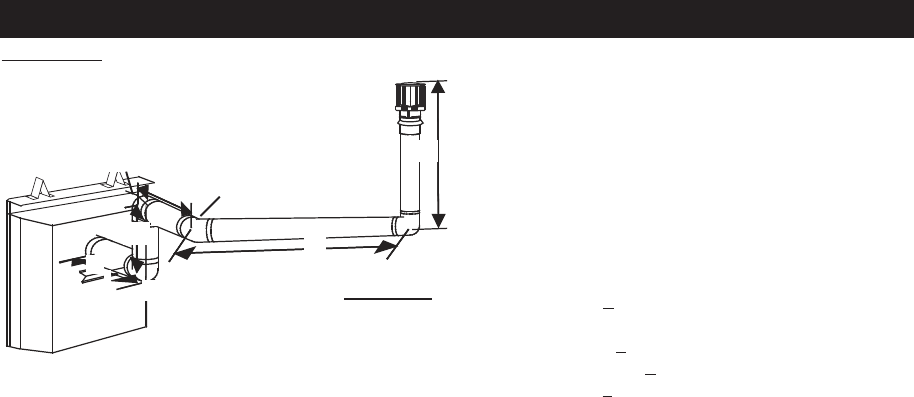
15
W415-0661 / C / 02.20.08
V
1
= 1.5 ft
V
2
= 5 ft
V
T
=
V
1
+
V
2
=
1.5 + 5 = 6.5 ft
H
1
= 1 ft
H
2
= 1 ft
H
3
= 10.75 ft
H
R
= H
1
+ H
2
+ H
3
= 1 + 1 + 10.75 = 12.75 ft
H
O
= .03 (three 90° elbows + one 45° elbow - 90°)
= .03(90 + 90 + 90 + 45 - 90) = 6.75 ft
H
T
= H
R
+ H
O
= 12.75 + 6.75 = 19.5 ft
H
T
+ V
T
= 19.5 + 6.5 = 26 ft
Formula 1: H
T
< 3V
T
3V
T
=
3 x
6.5 = 19.5 ft
19.5 < 19.5
Formula 2: H
T
+ V
T
< 40 feet
26 < 40
Since both formulas are met, this vent confi guration is accept-
able.
H
2
H
3
V
1
V
2
90°
45°
90°
H
1
90°
BGD36CF(G) TOP OR REAR EXIT VERTICAL TERMINATION
FIGURE 33
Example 8:
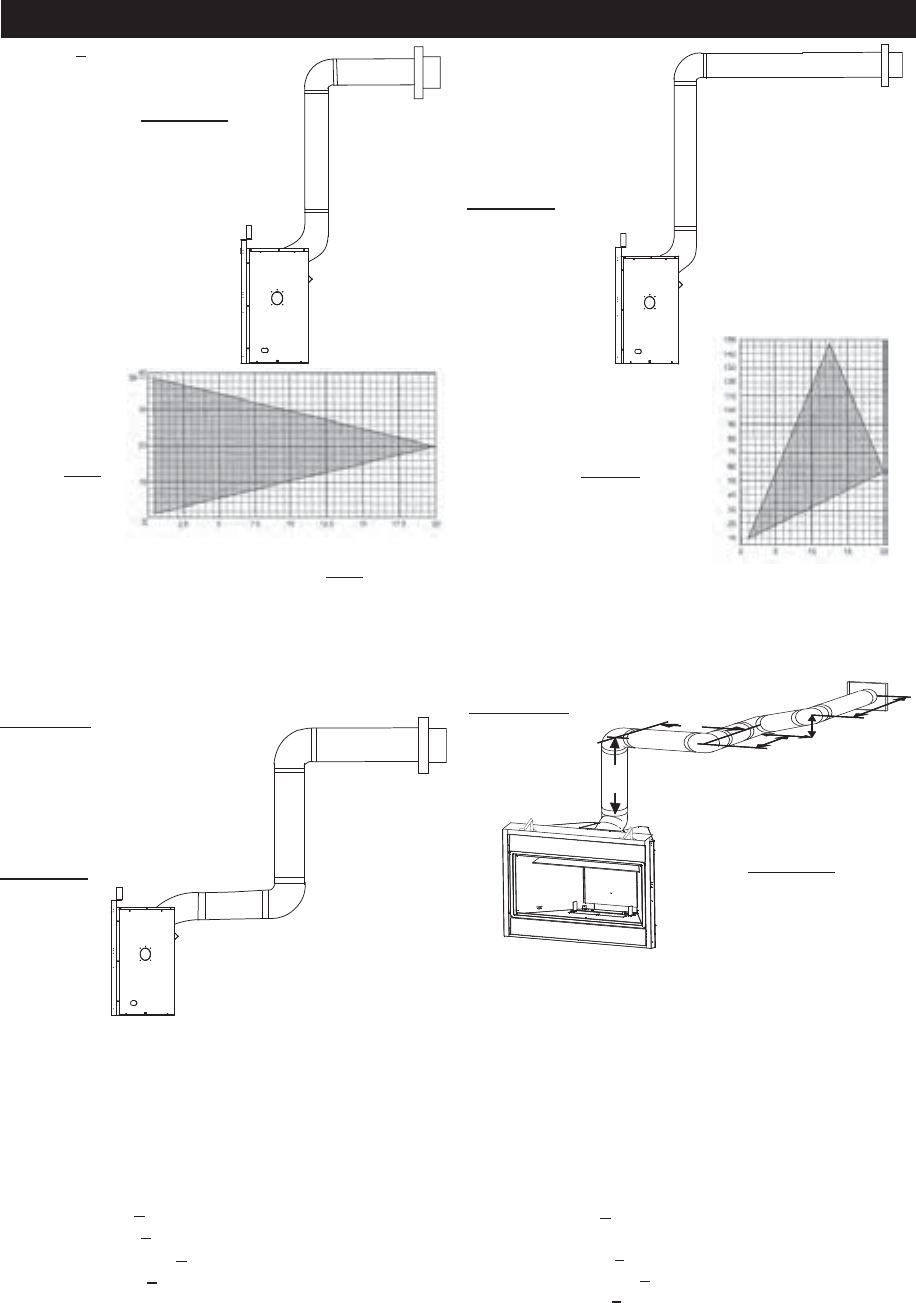
16
W415-0661 / C / 02.20.08
BGD42CF HORIZONTAL TERMINATION
when (H
T
) < (V
T
)
Simple venting confi guration (only
one 45º and 90° elbow)
45°
90°
For vent confi gurations requiring more than one 45º and 90°
elbow, the following formulas apply:
Formula 1: HT < VT
Formula 2: HT + VT < 40 feet
Example 1:
45°
90°
H
1
H
2
V
1
REQUIRED
VERTICAL
RISE IN FEET
(V
T
)
CALCULATED HORIZONTAL VENT RUN
PLUS OFFSETS IN FEET (H
T
)
The shaded area within the lines represents acceptable values for
H
T
and V
T
.
V
1
= 8 ft
V
T
V
1
= 8 ft
H
1
= 2.5 ft
H
2
= 2 ft
H
R
= H
1
+ H
2
= 2.5 + 2 = 4.5 ft
H
O
= .03 (one 45° elbows + two 90° elbows - 135°)
= .03(225 - 135°) = 2.7 ft
H
T
= H
R
+ H
O
= 4.5 + 2.7 = 7.2 ft
H
T
+ V
T
= 7.2 + 8 = 15.2 ft
Formula 1: H
T
< V
T
7.2 < 8
Formula 2: H
T
+ V
T
< 40 feet
15.2 < 40
Since both formulas are met, this vent confi guration is acceptable.
FIGURE 34
FIGURE 35
when (H
T
) > (V
T
)
Simple venting con-
fi guration (only one
45º and 90° elbow)
See graph to deter-
mine the required
vertical rise V
T
for the
required horizontal
run H
T
.
REQUIRED VER-
TICAL RISE IN
INCHES
V
T
HORIZONTAL VENT
RUN PLUS OFFSETS
IN FEET (H
T
)
The shaded area within the lines
represents acceptable values for H
T
and V
T
.
For vent confi gurations requiring more than one 45º and one 90°
elbow the following formulas apply:
Formula 1: HT < 4.2 VT
Formula 2: HT + VT < 24.75 feet
Example 2:
V
1
= 4 ft
V
2
= 1.5 ft
V
T
=
V
1
+
V
2
=
4 + 1.5 = 5.5 ft
H
1
= 2 ft
H
2
= 1 ft
H
3
= 1 ft
H
4
= 1.5 ft
H
R
= H
1
+ H
2
+ H
3
+ H
4
= 2 + 1 + 1 + 1.5 = 5.5 ft
H
O
= .03 (one 45° elbow + four 90° elbows - 135°)
= .03(405 - 135) = 8.1 ft
H
T
= H
R
+ H
O
= 5.5 + 8.1 = 13.6 ft
H
T
+ V
T
= 13.6 + 5.5 = 19.1 ft
Formula 1: H
T
< 4.2V
T
4.2V
T
= 4
.2 x
5.5 = 23.1 ft
13.6 < 16.8
Formula 2: H
T
+ V
T
< 24.75 feet
19.1 < 24.75
Since both formulas are met, this vent confi guration is accept-
able.
FIGURE 36
FIGURE 37
H
1
H
2
H
3
H
4
V
1
V
2
90°
45°
90°
90°
90°
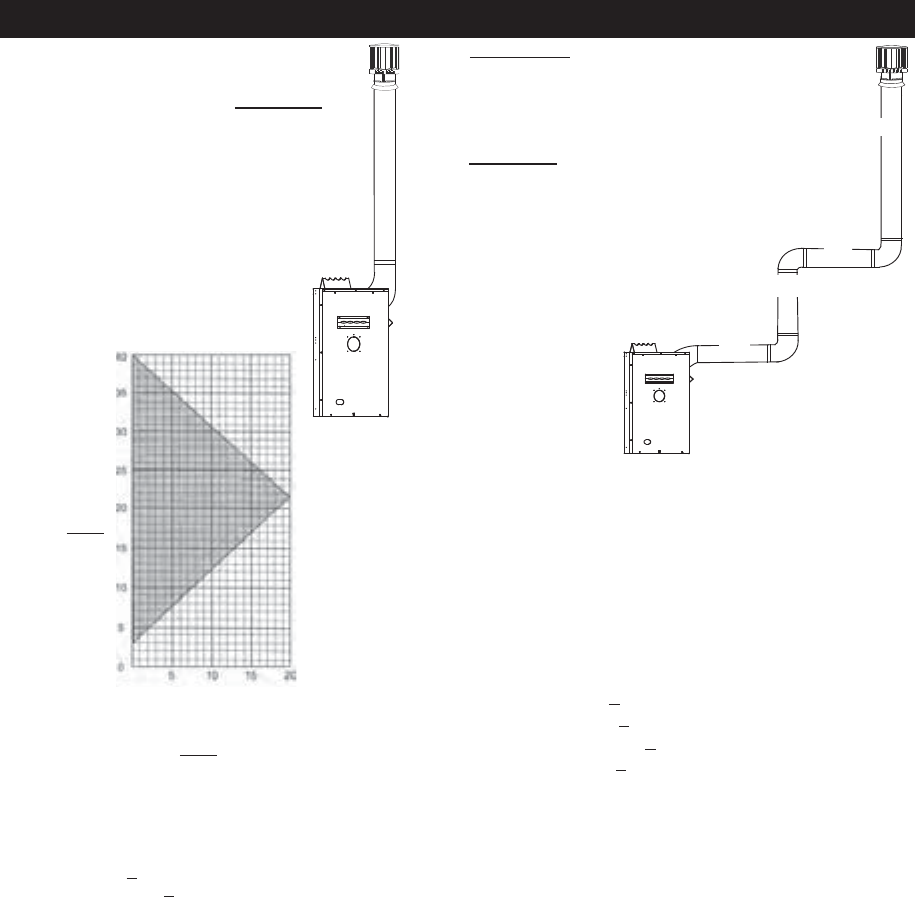
17
W415-0661 / C / 02.20.08
BGD42CF VERTICAL TERMINATION
when (H
T
) < (V
T
)
Simple venting confi gurations
45°
MAXIMUM
VERTICAL
RISE IN FEET
V
T
HORIZONTAL VENT
RUN PLUS OFFSET IN
FEET
H
T
The shaded area within the lines represents acceptable values
for H
T
and V
T
.
For vent confi gurations requiring more than one 45º and one 90°
elbow the following formulas apply:
Formula 1: HT < VT
Formula 2: HT + VT < 40 feet
Example 3:
90°
90°
90°
H
1
V
1
V
2
45°
H
2
V
1
= 5 ft
V
2
= 10 ft
V
T
=
V
1
+
V
2
=
5 + 10 = 15 ft
H
1
= 3 ft
H
2
= 2.5 ft
H
R
= H
1
+ H
2
= 3 + 2.5 = 5.5 ft
H
O
= .03 (one 45° elbow + three 90° elbows - 135°)
= .03 (45 + 90 + 90 +90 - 135) = 5.4 ft
H
T
= H
R
+ H
O
= 5.5 + 5.4 = 10.9 ft
H
T
+ V
T
= 10.9 + 15 = 25.9 ft
Formula 1: H
T
< V
T
10.9 < 15
Formula 2: H
T
+ V
T
< 40 feet
25.9 < 40
Since both formulas are met, this vent confi guration is ac-
ceptable.
See graph to determine the required vertical
rise V
T
for the required horizontal run H
T
.
FIGURE 38
FIGURE 39
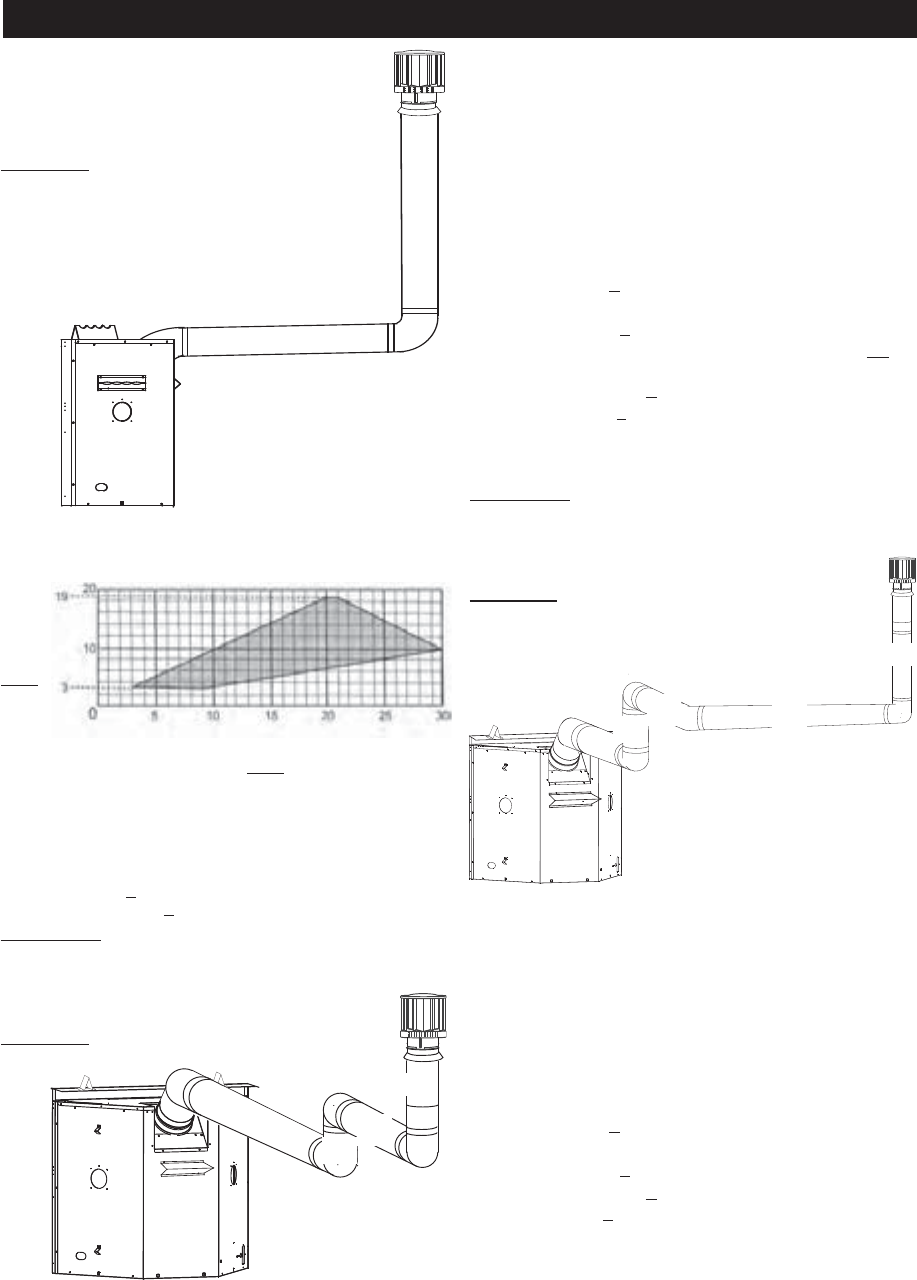
18
W415-0661 / C / 02.20.08
BGD42CF VERTICAL TERMINATION
when (H
T
) > (V
T
)
Simple venting confi gurations
HORIZONTAL VENT RUN PLUS OFFSET
IN FEET
H
T
The shaded area within the lines represents acceptable values
for H
T
and V
T
.
For vent confi gurations requiring more than one 45º and one 90°
elbow the following formulas apply:
Formula 1: HT < 3VT
Formula 2: HT + VT < 40 feet
Example 4:
V
1
= 1 ft
V
2
= 1.5 ft
V
T
=
V
1
+
V
2
=
1 + 1.5 = 2.5 ft
H
1
= 6 ft
H
2
= 2 ft
H
R
= H
1
+ H
2
= 6 + 2 = 8 ft
H
O
= .03 (one 45° elbow + three 90° elbows - 135°)
= .03 (45 + 90 + 90 +90 - 135) = 5.4 ft
H
T
= H
R
+ H
O
= 8 + 5.4 = 13.4 ft
H
T
+ V
T
= 13.4 + 2.5 = 15.9 ft
Formula 1: H
T
< V
T
3V
T
= 3 x 2.5 = 7.5 ft
13.4 < 7.5
Since this formula is not met, this vent confi guration is unac-
ceptable.
Formula 2: H
T
+ V
T
< 40 feet
15.9 < 40
Since only formula 2 is met, this vent confi guration is unac-
ceptable and a new fi replace location or vent confi guration will
need to be established to satisfy both formulas.
Example 5:
See graph to determine the required vertical rise V
T
for the required
horizontal run H
T
.
90°
90°
90°
H
1
V
1
V
2
45°
H
2
90°
90°
90°
H
1
V
1
V
2
45°
H
2
H
3
V
1
= 1.5 ft
V
2
= 8 ft
V
T
=
V
1
+
V
2
=
1.5 + 8 = 9.5 ft
H
1
= 1 ft
H
2
= 1 ft
H
R
= H
1
+ H
2
+ H
3
= 1 + 1 + 10.75 = 12.75 ft
H
O
= .03 (two 45° elbows + three 90° elbows - 135°)
= .03 (45 + 45 + 90 + 90 +90 - 135) = 6.75 ft
H
T
= H
R
+ H
O
= 12.75 + 6.75 = 19.5 ft
H
T
+ V
T
= 19.5 + 4.5 = 24 ft
Formula 1: H
T
< V
T
3V
T
= 3 x 2.5 = 7.5 ft
13.4 < 7.5
Formula 2: H
T
+ V
T
< 40 feet
24 < 40
Since both formulas are met, this vent confi guration is ac-
ceptable.
FIGURE 40
FIGURE 41
FIGURE 42
45°
MAXIMUM
VERTICAL
RISE IN
FEET
V
T
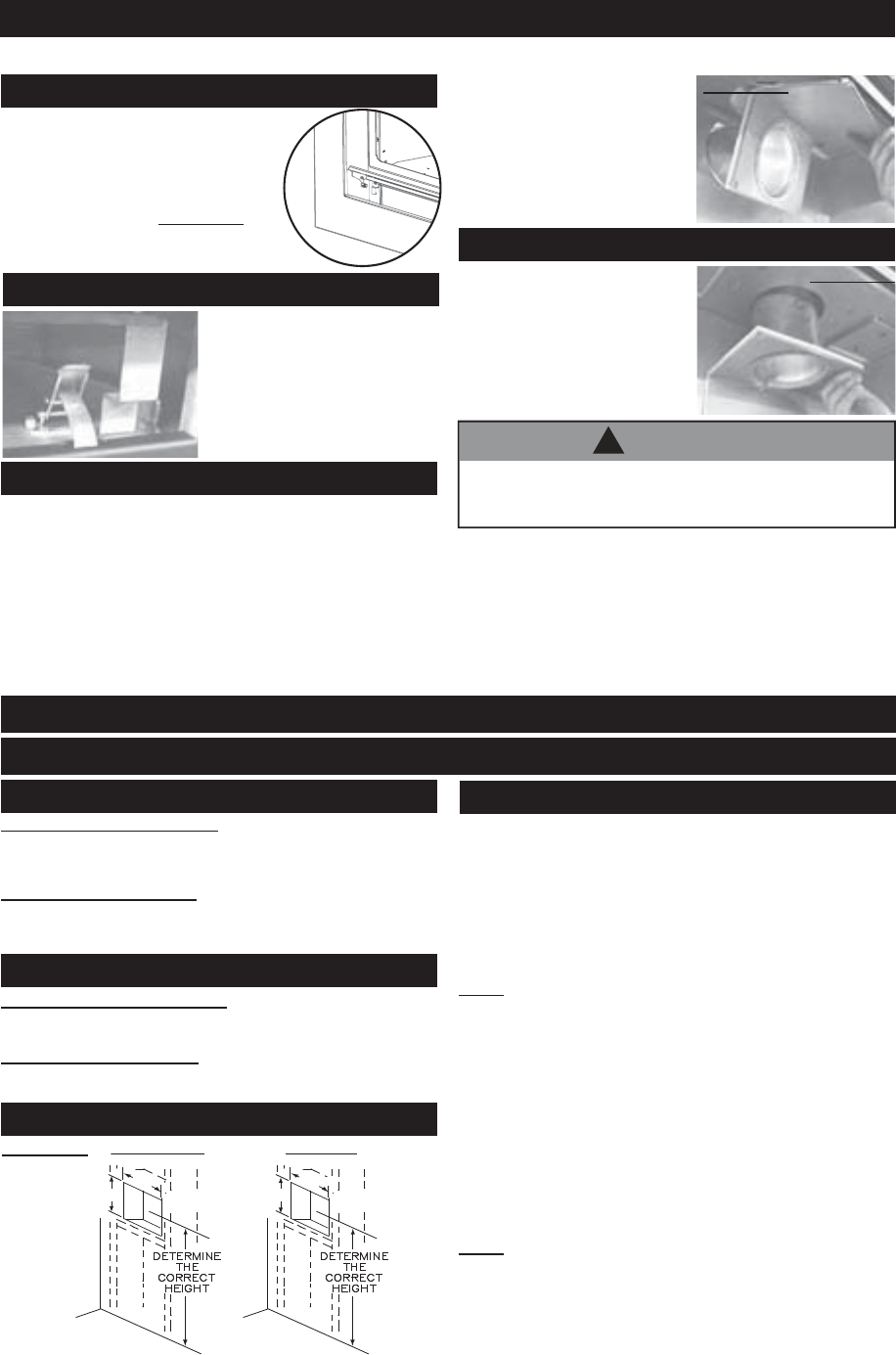
19
W415-0661 / C / 02.20.08
Do not over tighten. The gasket
needs only to be snug against the
fi rebox. FIGURE 45.
1. Remove the 7" diameter cap
from the top of the fi replace and re-
secure it over the 7" collar located
at the rear of the unit. Press fi rmly
on the cap while securing to ensure
an airtight seal. Do not damage the
gasket.
FAILURE TO INSTALL THE CAP WILL CAUSE THE FIRE-
PLACE TO FUNCTION IMPROPERLY AND CAN CAUSE
INJURY OR PROPERTY DAMAGE.
2. Remove the plate covering the 4" diameter fl ue opening (seen
inside the top of the 7" diameter collar) and discard. Try not to disturb
the retaining ring or the gasket beneath. Re-secure the ring and gasket
using the screws removed from the plate.
3. From inside the fi rebox, insert the 4" fl ue pipe assembly through
the heat shield and out through the retaining ring. Secure the assembly
to the rear and top of the unit using 4 #8 x ¾" Hex Head Wildrill screws
supplied. Do not over tighten. The gasket needs only to be snug against
the fi rebox. FIGURE 46.
BGD36CF(G) PRE-INSTALLATION PREPARATION
REAR EXIT:
TOP EXIT:
(THIS PROCEDURE IS NOT REQUIRED FOR THE BGD42CF)
REMOVING THE VALVE ACCESS DOOR
1. The valve access door rotates on the
pins attached to the side frame. Lift the
valve access door off the pins to operate
the main glass door.
FIGURE 43
FIGURE 45
FIGURE 46
For optimum performance, it is recommended that all horizontal runs have a 1" rise per foot.
HORIZONTAL VENT SECTIONS: - A minimum clearance of 1" at
the bottom and sides of the vent and 2" at the top on all horizontal
runs to combustibles is required. The fi restop spacer (W010-1774)
supplied with the unit must be used to maintain this clearance.
VERTICAL VENT SECTIONS: - A minimum of 1" all around the vent
pipe on all vertical runs to combustibles is required except for clear-
ances in fi replace enclosures. See "MINIMUM ENCLOSURE CLEAR-
ANCES" section. Use fi restop spacer W500-0096 (not supplied).
HORIZONTAL VENT SECTIONS: A minimum clearance of 2" all
around the vent pipe on all horizontal runs to combustibles is required.
Use fi restop spacer W010-1778 (supplied).
VERTICAL VENT SECTIONS: A minimum of 1" all around the vent
pipe on all vertical runs to combustibles is required. Use fi restop spacer
W500-0028 (not supplied).
INSTALLATION
WALL AND CEILING PROTECTION
HORIZONTAL INSTALLATION
RECTANGULAR
HOLE
11 3/8”
9 7/8”
BGD36CF(G)
RECTANGULAR
HOLE
16 1/4”
BGD42CF
14 7/16”
FIGURE 47
BGD36CF(G) ONLY
This application occurs when venting through an exterior wall.
Having determined the correct height for the air terminal location,
cut and frame a hole in the exterior wall 9 7/8" wide by 11 3/8" high
to accommodate the fi restop assembly
. Dry fi t the fi restop assembly
before proceeding to ensure the brackets on the rear surface fi t within
the horizontal framing.
As an alternative to framing, the vent pipe can be enclosed in the wall
using Napoleon® vent sleeve VS47KT.
NOTE: THE FIRESTOP ASSEMBLY MUST BE INSTALLED WITH
THE VENT SHIELD TO THE TOP.
The length of the vent shield may be cut shorter for combustible walls
that are less than 8 1/2" thick but the vent shield must extend the full
depth of the combustible wall.
1. Apply a bead of caulking (not supplied) around the outer edge of
the inside surface of the fi restop assembly, fi t the fi restop assembly
to the hole and secure using the 4 screws (W415-0026) supplied in
your manual baggy.
2. Once the vent pipe is installed in its fi nal position, apply high
temperature sealant W573-0002 (not supplied) between the pipe,
and the fi restop.
NOTE: DO NOT FILL THE CAVITY BETWEEN THE VENT PIPE
AND THE FIRESTOP SLEEVE WITH ANY TYPE OF MATERIAL.
BGD36CF(G)
BGD42CF
DOOR OPERATION
To access the lower door latch,
open the Valve Access
Door as illustrated. Release the top
and bottom door latches, located at
the right side of the door.
FIGURE 44
FIGURE 44
Before attaching elbows to the collars on the back of the fi replace,
1½" will need to be trimmed off the 4" collar.
From inside the fi rebox, insert the 4" fl ue pipe / gasket assembly
(provided) through the rear of the fi rebox.
Secure the gasket assembly to the rear and top of the unit using
4 #8 x 3/4" Hex Head Wildrill screws supplied.
!
WARNING

20
W415-0661 / C / 02.20.08
Apply a bead of caulking all around the edge of the opening and
place the fi restop top, so that the vent shield covers the top of the
vent within the opening.
The length of the vent shield may be cut shorter for combustible
walls that are less than 8 1/2" thick but the vent shield must extend
the full depth of the combustible wall.
Place the fi restop bottom against the fi restop top and secure the
two together. Adjust the assembly to ensure it is tight to the vent.
Secure fi
restop to wall. Ensure that both spacer and shield main-
tain the required clearance to combustibles. Once the vent pipe is
installed in its fi nal position, apply sealant between the vent pipe
and the fi restop spacer. This restricts cold air from being drawn
into the room or around the fi replace. See Figures 49a-c.
ADJUSTABLE FIRESTOP INSTALLATION
VENT SHIELD
FIRESTOP TOP
FIRESTOP BOTTOM
FIGURE 48
FIGURE 49a
FIGURE 49c
FIGURE 49b
BGD42CF ONLY
DO NOT FILL THIS SPACE WITH ANY TYPE OF MATERIAL.
A vent pipe shield will prevent
any materials such as insula-
tion, from fi lling up the 1" air
space around the pipe. Nail
headers between the joist for
extra support.
2. Apply a bead of caulking
(not supplied) to the frame-
work or to the Wolf Steel vent
pipe shield plate or equivalent
(in the case of a fi nished
ceiling), and secure over
the opening in the ceiling. A
fi restop must be placed on the
bottom of each framed opening in
a roof or ceiling that the venting
system passes through.
VERTICAL INSTALLATION
BGD36CF(G) = 9 3/4”
BGD42CF = 10 3/4”
FIGURE 50
FIGURE 51
1. Determine the air terminal location, cut and frame 9 3/4" for
the BGD36CF(G), or 10 3/4" for the BGD42CF square opening in
the ceiling and an opening in the roof to provide the minimum 1"
clearance between the fi replace vent pipe and any combustible
material. Try to center the exhaust pipe location midway between
two joists to prevent having to cut them. Use a plumb bob to line
up the center of the openings.
Apply a bead of caulking all
around and place a fi restop
spacer over the vent shield to
restrict cold air from being drawn
into the room or around the fi replace. Ensure that both spacer and
shield maintain the required clearance to combustibles. Once the
vent pipe is installed in its fi nal
position, apply high temperature
sealant W573-0002 (not sup-
plied) between the vent pipe and
the fi restop spacer.
3. In the attic, slide the vent pipe
collar down to cover up the open
end of the shield and tighten.
This will prevent any materials,
such as insulation, from fi lling up
the 1" air space around the pipe.
Where the opening in the outside wall has been cut 13" tall to
provide 2" clearance from the vent pipe, terminal extension plate
W500-0206 must be used to cover the opening.
FIGURE 52
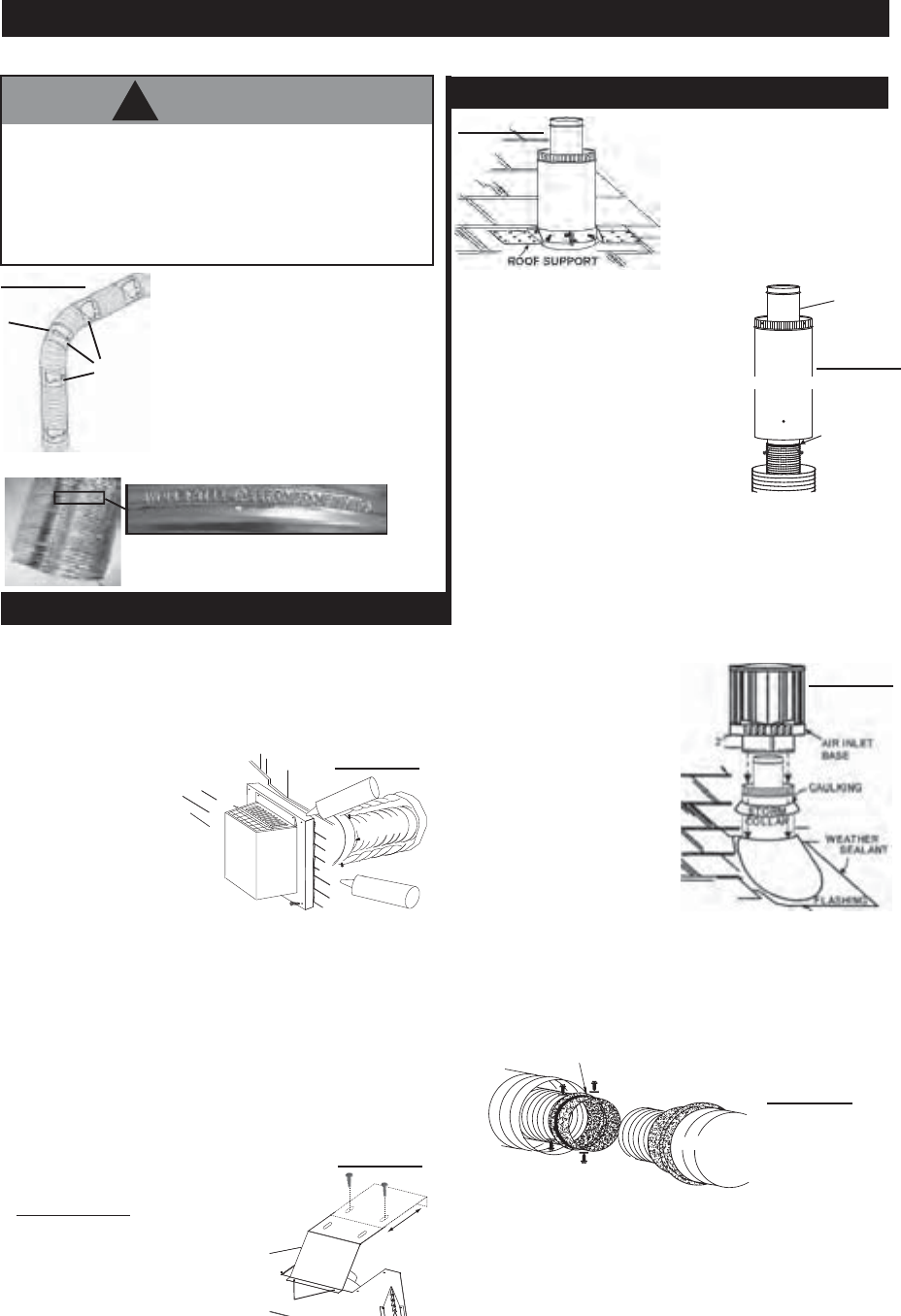
21
W415-0661 / C / 02.20.08
A
T
T
E
N
T
IO
N
-
C
H
A
U
D
CAUTIO
N
- HOT
2” OVERLAP
HI-TEMP
SEALANT
CAULKING
#10 X 2”
SCREWS
EXHAUST
AIR INTAKE VENT PIPE
FIGURE 54
The air terminal mounting
plate may be recessed into
the exterior wall or siding
by 1½", the depth of the
return fl ange.
USING FLEXIBLE VENT COMPONENTS
HORIZONTAL AIR TERMINAL INSTALLATION
THE BGD36CF(G) USES: 4" EXHAUST / 7" AIR INTAKE VENT PIPE WITH A MINIMUM 6" BEND RADIUS
THE BGD42CF USES: 5" EXHAUST / 8" AIR INTAKE VENT PIPE WITH A MINIMUM 8" BEND RADIUS
Use only approved fl exible liner kits marked:
"Wolf Steel Approved Venting" as identifi ed by
the stamp only on the 7" outer vent pipe.
ELBOW
SPACER
1. Stretch the exhaust vent pipe to the required length taking into
account the additional length needed for the fi nished wall surface.
Slip the vent pipe a minimum of 2" over the inner sleeve of the air
terminal and secure with 3 #8 screws. Apply a heavy bead of the
high temperature sealant W573-0002 (not supplied).
2. Using the air intake vent pipe, slide over the outer combustion
air sleeve of the air terminal and secure with 3 #8 screws. Seal as
before.
6. If more fl exible vent pipe needs to be used to reach the fi replace,
coupler them together as illustrated in Figure 59. The vent system
must be supported approximately every 3 feet for both vertical and
horizontal runs. Use noncombustible
strapping to maintain the minimum 1"
clearance to combustibles.
7. BGD42CF ONLY:
The vent heat shield
must be installed only when terminating
horizontally with no vertical rise. Remove
the two screws nearest the vent collars
on the top of the fi replace. Align the vent
heat shield (supplied) and secure. Adjust
the vent heat shield to touch the fi restop
spacer.
AIR INTAKE
VENT PIPE
EXHAUST
AIR INTAKE
VENT PIPE
COUPLER
COUPLER
#8 X 1/2”
SELF DRILLING
SCREWS & WASHERS
HI-TEMP
SEALER
FIGURE 59
VENT
HEAT
SHIELD
SCREWS
ADJUST
TO FIT
FIGURE 55
4. Apply a heavy bead of high temperature sealant W573-0007 (not
supplied) to the outside of the 4" inner collar of the fi replace approxi-
mately 1" from the end. Slide the fl exible vent pipe a minimum of 2"
over the fi replace vent collar and secure with 3 #8 screws.
5. Using the air intake vent pipe, slide over the fi replace combustion
air collar and secure with 3 #8 screws. Seal with high temperature
sealant W573-0002 (not supplied).
3. Insert the fl exible vent pipe
through the fi restop maintaining
the required clearance to combus-
tibles. Holding the air terminal (let-
tering in an upright, readable position),
secure to the exterior wall and make weather tight by sealing with
caulking (not supplied).
1. Fasten the roof support to the
roof using the screws provided.
The roof support is optional. In
this case the venting is to be
adequately supported using either
an alternate method suitable to the
authority having jurisdiction or the
optional roof support.
2. Stretch the exhaust vent pipe
to the
required length, slip it a minimum of 2" over
the inner sleeve of the air terminal con-
nector and secure with 3 #8 screws. Seal
using a heavy bead of the high temperature
sealant W573-0002 (not supplied).
3. Repeat using air intake vent pipe.
4. Thread the air terminal pipe assembly
down through the roof. The air terminal must
be located vertically and plumb. Attach the
air terminal assembly to the roof support,
ensuring that a minimum 16" of air terminal
will penetrate the roof when fastened.
DO NOT CLAMP THE FLEXIBLE VENT
PIPE.
VERTICAL AIR TERMINAL INSTALLATION
EXHAUST
VENT PIPE
AIR INTAKE
VENT PIPE
INNER
PIPE
HIGH
TEMPERATURE
SEALANT
AIR
TERMINAL
CONNECTOR
FIGURE 56
FIGURE 57
5. Remove nails from the shingles, above and to the sides of the
chimney. Place the fl ashing over the air terminal and slide it under-
neath the sides and upper edge of the shingles. Ensure that the air
terminal is properly centred within the fl ashing, giving a 3/4" margin
all around. Fasten to the roof. Do not nail through the lower portion
of the fl ashing. Make weather-tight by sealing with caulking. Where
possible, cover the sides and top edges of the fl ashing with roofi ng
material.
6. Aligning the seams of the
terminal and air terminal connec-
tor, place the terminal over the
air terminal connector making
sure the inner pipe goes into the
hole in the terminal. Secure with
screws provided.
7. Apply a heavy bead of
weatherproof caulking 2" above
the fl ashing. Note: Maintain a
minimum of 2" space between the
air inlet base and the storm collar.
Install the storm collar around the
air terminal and slide down to the
caulking. Tighten to ensure that a weather-tight seal between the air
terminal and the collar is achieved.
8. If more vent pipe needs to be used to reach the fi replace, couple
them together as illustrated. The vent system must be supported
approximately every 3 feet for both vertical and horizontal runs. Use
noncombustible strapping to maintain a clearance to combustibles
of 1".
FIGURE 58
For safe and proper operation of the
fi replace, follow the venting instruc-
tions exactly. All inner exhaust and
outer intake vent pipe joints may be
sealed using either high temperature
sealant W573-0002 or high tempera-
ture Mill Pac W573-0007 with the ex-
ception of the fi replace exhaust fl ue
collar which must be sealed using
Mill Pac (not supplied).
FIGURE 53
!
WARNING
Do not allow the inside liner to bunch up on horizontal or vertical
runs and elbows. Keep it pulled tight. A 1 1/4" air gap between
the inner and outer fl exible vent pipe all around is required for
safe operation. A spacer is required at the start, middle and end
of each elbow to ensure this gap is maintained. See Figure 53.
Spacers are attached to the inner fl ex liner at predetermined
intervals to maintain a 1 1/4" air gap to the outer fl ex liner. These
spacers must not be removed.

22
W415-0661 / C / 02.20.08
1. Move the fi replace into position. Measure the vent length required
between terminal and fi replace taking into account the additional length
needed for the fi nished wall surface and any 1¼" overlaps between
venting components.
2. Apply high temperature sealant W573-0007 (not supplied) to
the outer edge of the exhaust vent pipe of the fi replace. Attach
the fi rst vent component and secure using 3 self tapping screws.
Repeat using air intake vent pipe and seal using high temperature
sealant W573-0002 (not supplied).
3. Holding the air terminal (lettering in an upright, readable posi-
tion), insert into both vent pipes with a twisting motion to ensure
that both the terminal sleeves engage into the vent pipes and
sealant. Secure
the terminal to the
exterior wall and
make weather tight by
sealing with caulking
(not supplied).
The air terminal mounting
plate may be recessed into
the exterior wall or siding by
1½", the depth of the return
fl ange.
USING RIGID VENT COMPONENTS
HORIZONTAL AIR TERMINAL INSTALLATION
A
T
T
EN
T
I
O
N
-
C
H
A
UD
CA
U
T
I
O
N
-
HO
T
EXHAUS
T
AIR INTAKE
VENT PIPE
2” OVERLAP
HI-TEMP
SEALANT
CAULKING
#10 X 2”
SCREWS
FIGURE 60
EXTENDED HORIZONTAL AND CORNER
AIR TERMINAL INSTALLATION
1. Follow the instructions for "Horizontal Air Terminal Installations",
items 1 to 3.
2. Continue adding components alternating inner and outer venting.
Ensure that all exhaust vent-
ing and elbows have suffi cient
vent spacers attached and each
component is securely fastened to
the one prior. Attach the exhaust
telescopic sleeve to the vent run.
Repeat using a air intake vent pipe
telescopic sleeve. Secure and seal
as before. To facilitate completion,
attach exhaust and air intake vent
pipe couplers to the air terminal.
3. Install the air terminal. See
item 3 of the Horizontal Air
Terminal Installation. Extend the
exhaust telescopic sleeve; connect to the air terminal assembly.
Fasten with self tapping screws and seal. Repeat using the air
intake vent pipe telescopic sleeve.
BGD36CF SHOWN
FIGURE 61
EXHAUST
VENT PIPE
AIR INTAKE
VENT PIPE
INNER
VENT PIPE
HIGH
TEMPERATURE
SEALANT
AIR
TERMINAL
CONNECTOR
VERTICAL VENTING INSTALLATION
FIGURE 62
FIGURE 63
4. Apply high temperature sealant to the
outer edge of the of the outside pipe of
the air terminal connector. Slip a coupler
over the air intake collar and secure as
before. Trim the air intake coupler even
with the exhaust coupler end.
5. Thread the air terminal connector /
pipe assembly down through the roof
support and attach, ensuring that the
air terminal will penetrate the roof a
minimum 16" when fastened. If the attic
space is tight, we recommend threading
the Wolf Steel vent pipe collar or equiva-
lent loosely onto the air terminal assembly as it is passed
through the attic. The air terminal must be located vertically and
plumb.
6. Remove nails from the shingles, above and to the sides of
the chimney. Place the fl ashing over the air terminal and slide it
underneath the sides and upper edge of the shingles. Ensure that
the air terminal is properly centered within the fl ashing, giving a
3/4" margin all around. Fasten to the roof. Do NOT nail through the
lower portion of the fl ashing. Make weather-tight by sealing with
caulking. Where possible, cover the sides and top edges of the
fl ashing with roofi ng material.
7. Align the seams of the terminal and air terminal connector,
place the terminal over the air terminal connector making sure the
inner pipe goes into the hole in the terminal. Secure with screws
provided.
8. Apply a heavy bead of weatherproof caulking 2" above the
fl ashing. Note: Maintain a minimum of 2" space between the air
inlet base and the storm collar. Install the storm collar around the
air terminal and slide down to the caulking. Tighten to ensure that
a weather-tight seal between the air terminal and the collar is
achieved.
9. Continue adding rigid venting sections, sealing and securing
as above. Attach an exhaust telescopic sleeve to the last section
of rigid piping. Secure with screws and seal. Repeat using an air
intake telescopic sleeve.
10. REAR VENT APPLICATION: (BGD36CF(G) ONLY: Before
attaching elbows to the collars on the back of the fi replace,
1½" will need to be trimmed off the exhaust pipe collar.)
Run a bead of high temperature sealant
W573-0007 (not supplied) around the
outside of the exhaust collar. Attach
the exhaust elbow to the exhaust
collar and secure with 3 screws. Run
a bead of high temperature sealant
W573-0002 (not supplied) around
the outside of the air intake collar.
Attach the air intake elbow to
the air intake collar and secure
with 3 screws. Pull the exhaust
telescopic sleeve a minimum 2"
onto the elbow. Secure with 3 screws. Repeat with the air intake
telescopic sleeve.
TOP VENT APPLICATION: Run a bead of high temperature seal-
ant W573-0007 (not supplied) around the outside of the exhaust
on the fi replace. Pull the exhaust telescopic sleeve a minimum of
2" onto the collar. Secure with 3 screws. Repeat with the air intake
telescopic sleeve.
11. In the attic, slide the vent pipe collar down to cover up the open
end of the vent pipe shield and tighten. This will prevent any ma-
terials, such as insulation, from fi lling up the 1" air space around
the pipe.
For safe and proper operation of the fi replace, follow the venting
instructions exactly.
All inner exhaust and outer intake vent pipe joints may be
sealed using either high temperature sealant W573-0002 or
high temperature Mill Pac W573-0007 with the exception of the
fi replace exhaust fl ue collar which must be sealed using Mill
Pac (not supplied).
1. Move the fi replace into position.
2. Fasten the roof support to the roof using the screws provided.
FIGURE 56. The roof support is optional. In this case the venting is
to be adequately supported using either an alternate method suit-
able to the authority having jurisdiction or the optional roof support.
3. Apply high temperature sealant W573-0002 (not supplied) to
the outer edge of the inner end of the air terminal connector. Slip a
coupler a minimum of 2" over the exhaust collar and secure using
3 screws.
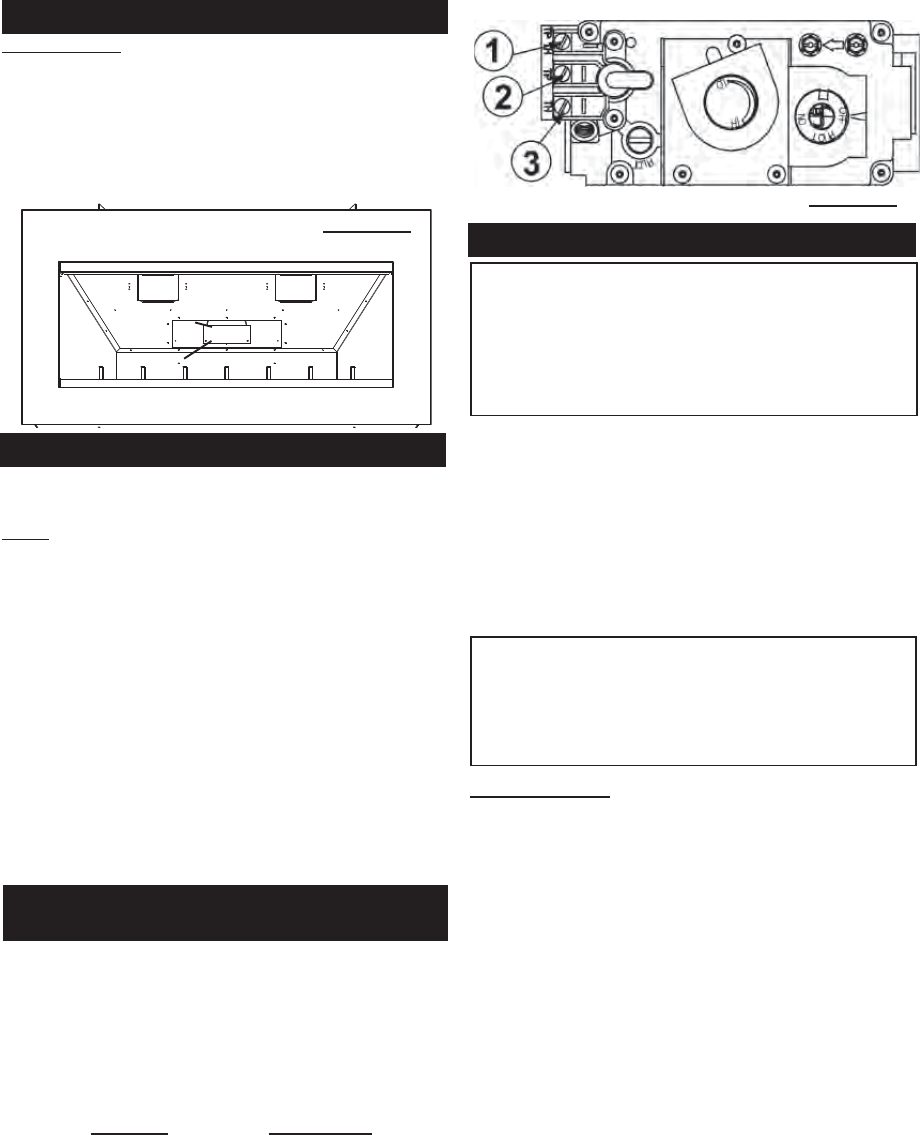
23
W415-0661 / C / 02.20.08
RESTRICTING VERTICAL VENTS
FIGURE 65
BGD42CF ONLY: Vertical terminations may display a very active
fl ame. As this appearance is not desirable, the vent exit must be
restricted using restrictor plate, W500-0205. This reduces the
velocity of the exhaust gases, slowing down the fl ame pattern and
creating a more traditional appearance. The plate has a series of
holes to allow for adjustment.
Remove the two screws on either side of the exhaust collar inside
the fi rebox. Install the plate as shown. Install the plate on the desired
set of holes then replace the screws.
Proceed once the vent installation is complete.
NOTE: All gas connections must be contained within the fi re-
place when complete.
1. Move the fi replace into position and secure to the fl oor through
the 1/4" holes located at either side of the base.
2. The fi replace is designed to accept 3/8" gas supply line. The
fi replace is equipped with a 3/8" manual shut-off valve.
3. Connect the gas supply in accordance to local codes. In the
absence thereof, install according to the National Installation Code.
4. When fl exing any gas line, support the gas valve so that the
lines are not bent or kinked.
5. Check for gas leaks by brushing on a soap and water solu-
tion.
DO NOT USE OPEN FLAME.
Purge all gas lines with the glass door of the stove removed.
Assure that a continuous gas fl ow is at the burner before re-
installing the door.
TOP OF THE
FIREBOX
FLUE COLLAR
RESTRICTOR PLATE
FIGURE 64
GAS INSTALLATION
This appliance may be installed as an OEM (Original Equipment
Manufacturer) Installation in a manufactured home or mobile
home and must be installed in accordance with the manufacturer's
instructions and the Manufactured Home Construction and Safety
Standard, Title 24 CFR, Part 3280, in the United States or the Mobile
Home Standard, CAN/CSA Z240 MH Series, in Canada. This ap-
pliance is only for use with the type(s) of gas indicated on the rating
plate. A conversion kit is supplied with the mobile home appliance.
This Mobile/Manufactured Home listed appliance comes factory
equipped with means to secure the unit.
The fi replace is equipped with two 1/4" diameter holes located in the
front left and right corners of the base. For mobile home installations,
the fi replace must be fastened in place. Use #10 screws, inserted
through the holes in the base to secure.
Always turn off the pilot and the fuel supply at the source, prior to
moving the mobile home.
After moving the mobile home and prior to lighting the fi replace,
permanently ensure that the logs are positioned correctly.
This appliance may be installed in an aftermarket permanently
located, manufactured (mobile) home, where not prohibited
by local codes.
This appliance is only to be used with the type of gas indicated
on the rating plate. This appliance is not convertible for use
with other gasses, unless a certifi ed kit is used.
CONVERSION KITS
The mobile home appliance is fi eld convertible between Natural Gas
(NG) and Propane (LP).
To convert from one gas to another consult your Napoleon® dealer/
distributor.
MOBILE HOME INSTALLATION
For remote wall switch and decorative light installations for the BGD-
36CFG see section "BGD36CFG SWITCH/WIRING DIAGRAM".
For ease of accessibility, an optional remote wall switch may be
installed in a convenient location. A 20ft length of millivolt wire is
connected to the gas valve for the wall swtich. However, if a greater
length is required route 2-strand (solid core) millivolt wire through the
electrical hole located at the bottom left side of the unit. The recom-
mended maximum lead length depends on wire size:
OPTIONAL WALL SWITCH
INSTALLATION EXCLUDING BGD36CFG
Do not connect either the wall switch, thermostat or gas valve
directly to 110 volt electricity.
WIRE SIZE MAX. LENGTH
14 gauge 100 feet
16 gauge 60 feet
18 gauge 40 feet
Attach the two leads to terminals 1 and 3 located on the gas valve.

24
W415-0661 / C / 02.20.08
FRAMING
BGD42CF
BGD36CF(G)
FIGURE 67
FIGURE 68
It is not necessary to install a hearth extension with this fi replace sys-
tem. Objects placed in front of the fi replace should be kept a minimum
of 48" away from the front face.
When roughing in the fi replace, raise the fi replace to accommodate
for the thickness of the fi nished fl oor materials, i.e. tile, carpeting,
hard wood, which if not planned for will interfere with the opening of
the lower access door and the installation of many decorative fl ashing
accessories.
Note: In order to avoid the possibility of exposed insulation or vapor
barrier coming in contact with the fi replace body, it is recommended
that the walls of the fi replace enclosure be “fi nished” (ie: drywall/
sheetrock), as you would fi nish any other outside wall of a home.
This will ensure that clearance to combustibles is maintained within
the cavity.
Combustible materials may be installed fl ush with the front of the fi re-
place but must not cover any of the black face-areas of the fi replace.
Non-combustible material (brick, stone or ceramic tile) may protrude
in these areas but must not restrict glass door removal.
INSTALLING STANDOFFS
Both the BGD36CF(G) and BGD42CF are supplied with two standoffs.
For convenience, the standoffs have been shipped fl at and located on
the top at the front. Before framing ensure the standoffs are bent up and
screwed into place ensuring a height of 4.5".
BGD36 ILLUSTRATION
FIGURE 66
HORIZONTAL VENT SECTIONS: - A minimum clearance of 1" at the
bottom and sides of the vent and 2" at the top on all horizontal runs to
combustibles is required. Use fi restop spacer W010-1774 (supplied).
VERTICAL VENT SECTIONS: - A minimum of 1" all around the vent pipe
on all vertical runs to combustibles is required except for clearances in
fi replace enclosures
*. See "MINIMUM ENCLOSURE CLEARANCES"
section. Use fi restop spacer W500-0096 (not supplied).
MINIMUM CLEARANCE TO COMBUSTIBLE CONSTRUCTION FROM
FIREPLACE AND VENT SURFACES:
Non-Combustible framing:
Top 0" to stand-offs if using optional
clean face surround
Combustible framing:
Sides, back, and bottom of the unit 0" to stand-offs
Top 3 1/2" to stand-offs if using
optional clean face surround
Non-combustible fi nishing:
Top 6 1/2" if using optional clean
face surround
Combustible fi replace fi nishing:
Sides, bottom and top 0" to fi replace edge
Enclosure top 8 1/4" to top of fi replace
Recessed depth 17 1/4"
Sides and bottom of the vent pipe 1"
Top of vent pipe 2"
Ceiling 72" from bottom of unit
MINIMUM CLEARANCE TO COMBUSTIBLE CONSTRUCTION FROM
FIREPLACE AND VENT SURFACES:
Combustible framing:
Top, sides, back and bottom of the unit 0" to stand-offs
Non-combustible fi nishing:
Top 6 1/2" to fi replace edge
Combustible fi replace fi nishing:
Sides and bottom 0" to fi replace edge
Enclosure top 13 1/2" to top of fi replace
Recessed depth 25"
Top, sides and bottom of vent pipe 2"
Ceiling 72" from bottom of unit
BGD42CF
HORIZONTAL VENT SECTIONS: A minimum clearance of 2" all around
the vent pipe on all horizontal runs to combustibles is required. Use fi restop
spacer W010-1778 (supplied).
VERTICAL VENT SECTIONS: A minimum of 1" all around the vent pipe
on all vertical runs to combustibles is required. Use fi restop spacer W500-
0028 (not supplied).
BGD36CF(G)
NOTE: The information and dimensions in this section represent the
minimum clearances to combustible material.
It is best to frame your fi replace after it is positioned and the vent sys-
tem is installed. Use 2x4's and frame to local building codes.
BGD36CF(G) ONLY: A steel header is required if using optional clean
face surround.
* Vertical vent sections in fi replace enclosures require a minimum of
1 1/2" all around the vent pipe.
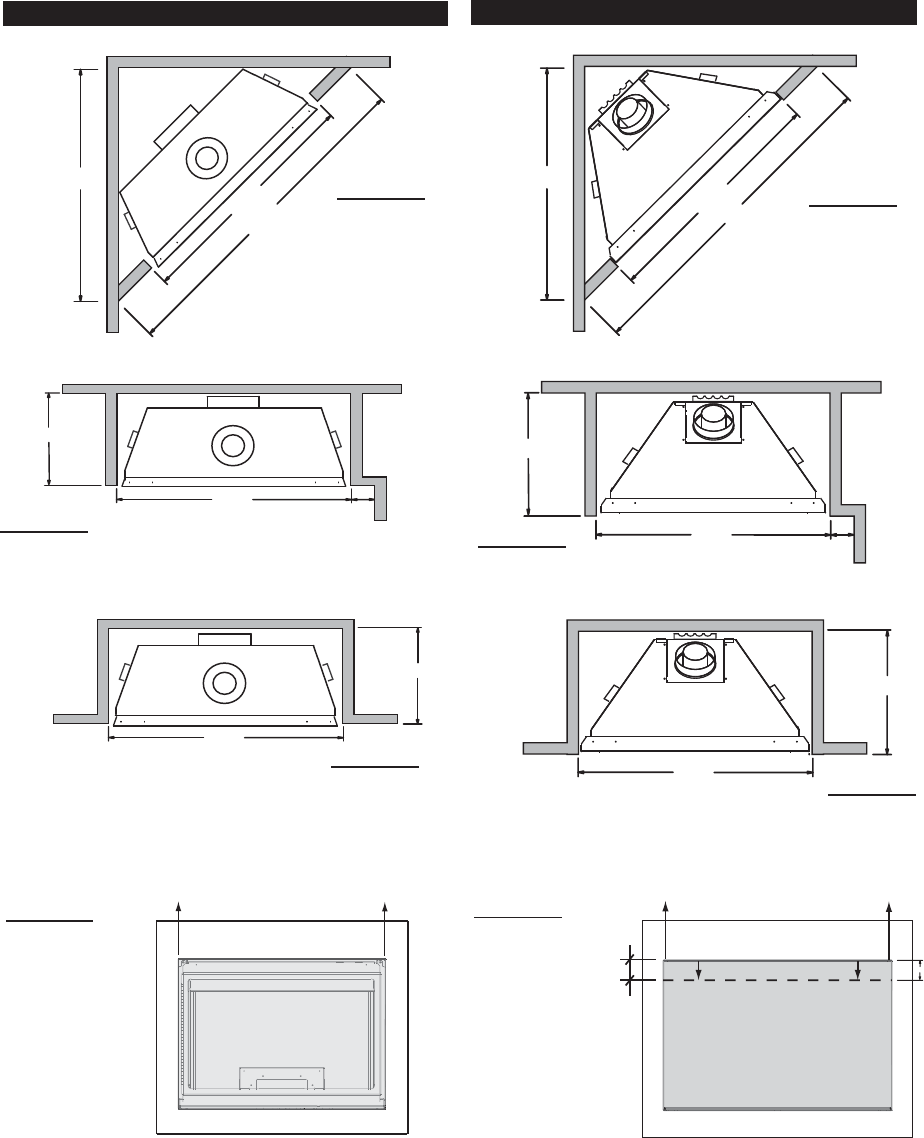
25
W415-0661 / C / 02.20.08
INSIDE
CHASE
40
1
/
2
"
6"
17
1
/
4
"
45"
46
1
/
2
"
64"
41
3
/
8
"
40
1
/2
"
59”
BGD36CF(G)
BGD42CF
46
1
/
2
"
25
1
/
4
"
OUTSIDE
CHASE
40
1
/2"
17
1
/
4
"
OUTSIDE
CHASE
Non-combustible materials such as brick and tile can be extended over the black face of the unit.
THIS AREA MUST
REMAIN EXPOSED TO
ALLOW FOR PROPER
DOOR OPERATION.
12” TO COMBUSTIBLE MANTLE
THIS AREA MUST
REMAIN EXPOSED TO
ALLOW FOR PROPER
DOOR REMOVAL.
12” TO COMBUSTIBLE MANTLE
The finishing
material can be
installed below
the top opening a
maximum of 1 1/2”.
Enough clearance to
the door latches must
be maintained to
allow for proper door
installation / removal.
1 - 1
1
/2
"
FIGURE 69
FIGURE 70
FIGURE 71
FIGURE 72
FIGURE 73
FIGURE 74
FIGURE 75
IMPORTANT:
Encroaching in this
area with fi nishing
material will inter-
fere with the open-
ing of the door.
INSIDE
CHASE
46
1
/
2
"
6"
25
1
/
4
"
FIGURE 76
Warning: Non-combustible Finishing Materials Required
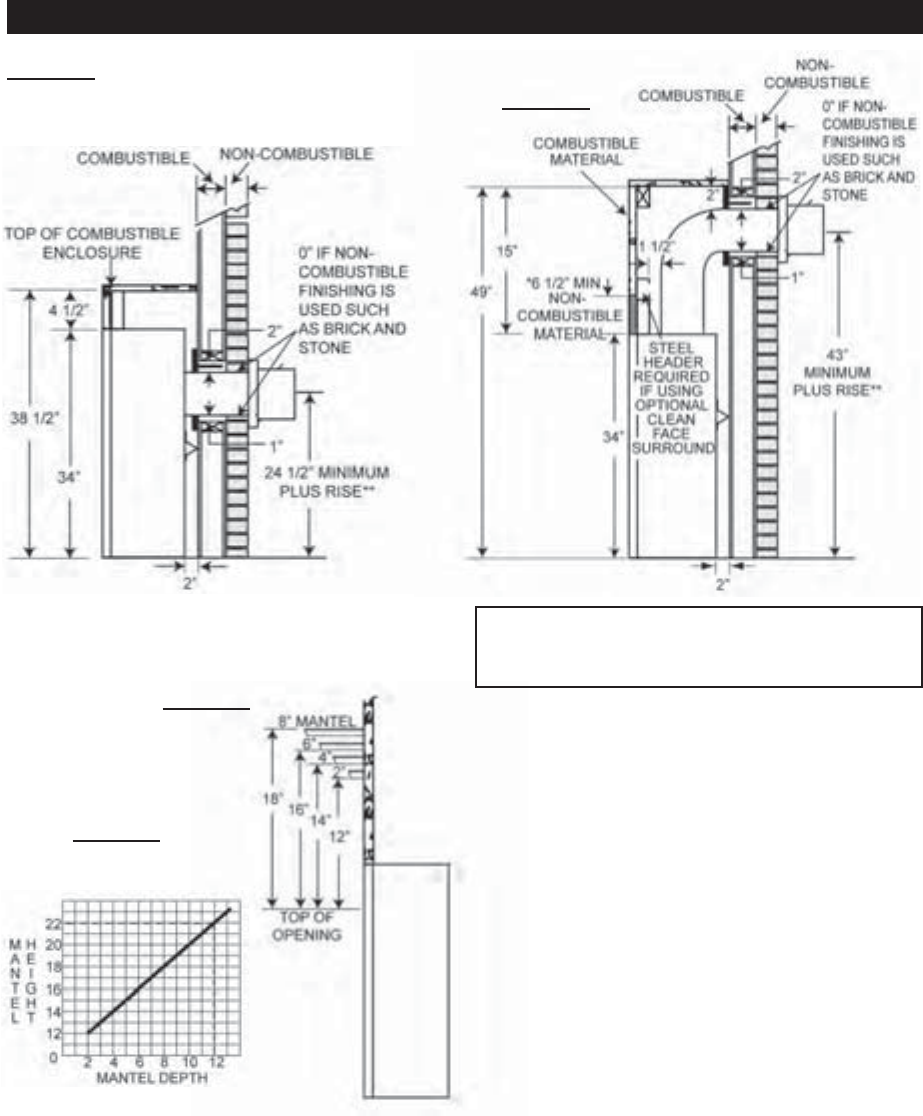
26
W415-0661 / C / 02.20.08
BGD36CF(G) MINIMUM MANTEL AND ENCLOSURE CLEARANCES
Combustible mantel clearance can vary according to the mantel depth. Use the graph to help evaluate the clearance needed.
FIGURE 77
FIGURE 80
The fi replace requires a minimum enclosure height of 38 1/2“
(REAR VENT) 49" (TOP VENT). For temperature requirements,
the enclosure space around and above the fi replace must be left
unobstructed.
** See Venting Section
FIGURE 79
FIGURE 78
* If this unit is installed fl ush to the fi nishing material and optional
clean face surround is to be installed then a minimum of 6 1/2"
of cement board or non-combustible equivalent must be used on
the top only of the front face. See Figure 80.
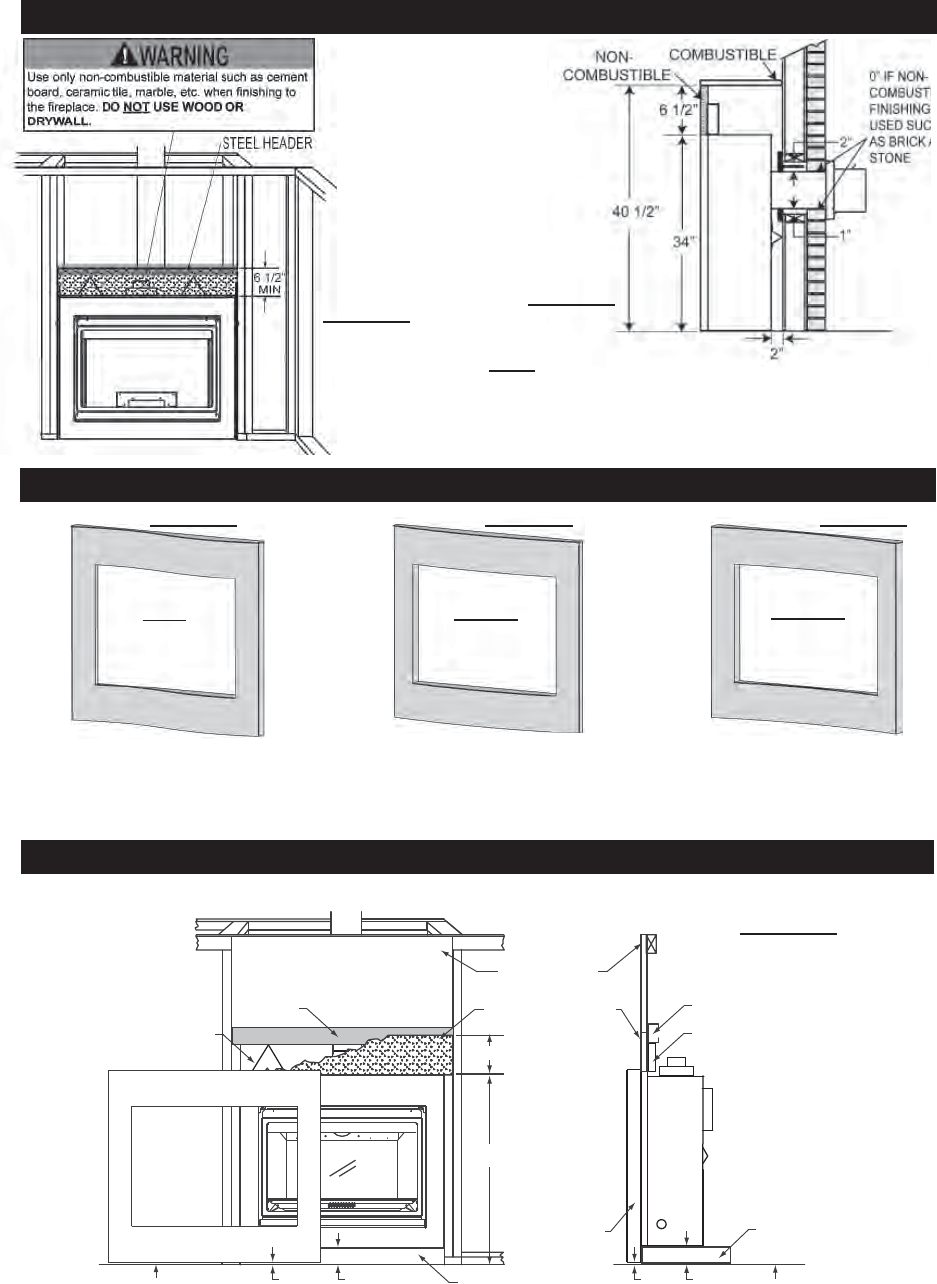
27
W415-0661 / C / 02.20.08
Installation requires a minimum of 6 1/2" non-combustible facing material at the top of the fi replace. Refer to either Figure 86a or Figure
86b (depending on your installation) to ensure your fi replace has been installed with the proper requirements for this kit.
Whether installing to a fi nished fl oor or a hearth, a 3/8" clearance must be maintained at the bottom of the clean face surround kit. To obtain
this clearance a fi replace riser is required.
When installing to a fi nished fl oor the fi replace riser must create a minimum clearance of 3 3/8" from the fi nished fl oor to the bottom of the
fi replace.
WAVE
S36WN (BROWN)
S36WP (PEWTER)
CONCAVE
S36CCN (BROWN)
S36CCP (PEWTER)
CONVEX
S36CVN (BROWN)
S36CVP (PEWTER)
**
OPTIONAL CLEAN FACE SURROUND INSTALLATION BGD36CF(G) ONLY
FIGURE 85FIGURE 83 FIGURE 84
FIGURE 81
FINISHED FLOOR INSTALLATION
NOTE:
** Installation requires a minimum 6 1/2" of non-combustible
facing above the top of the fi replace.
FINISHED
FLOOR
3
/8”
CLEARANCE
3
3
/8”
CLEANFACE SURROUND
STAND-OFF
6
1
/2” MINIMUM
37
3
/8”
FINISHED
FLOOR
NON-COMBUSTIBLE
MATERIAL
COMBUSTIBLE
MATERIAL
FIREPLACE
RISER
3
/8”
CLEARANCE
3
3
/8”
FIREPLACE
RISER
STAND-OFF
CLEAN FACE
SURROUND
KIT
CLEAN FACE SURROUND KIT
STEEL
HEADER
STEEL
HEADER
FIGURE 82
FIGURE 86a
CLEAN FACE SURROUND MINIMUM ENCLOSURE CLEARANCES
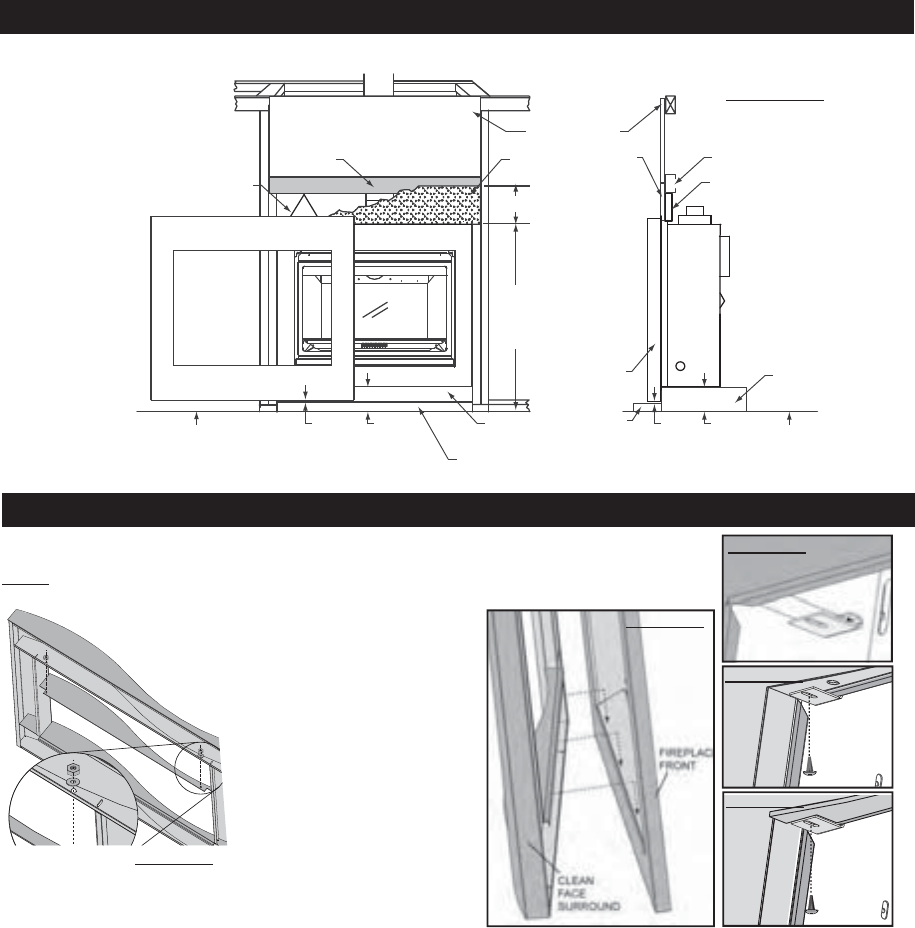
28
W415-0661 / C / 02.20.08
NOTE: THE OPTIONAL CLEAN FACE TRIM KIT MUST BE
INSTALLED BEFORE PROCEEDING.
1. From the rear side of the clean face surround,
insert the weld studs on the top window plate
assembly upward through the holes on the
underside of the top section of the clean
face surround. (FIGURE 87)
2. Using a socket wrench,
secure using the nuts and
washers provided. Depending
on your surround, space may
be tight. (FIGURE 87)
FIGURE 87
FIGURE 88
FIGURE 89
FIGURE 90
FIGURE 91
3. First secure the clean face surround to the fi replace front by
hooking the ledge that runs horizontally on the rear surface of the
clean face surround over the bottom edge of the fi replace front
opening. (FIGURE 89)
4. With the clean face surround against the fi replace front, hook
the surround clips in behind the top lip of the fi replace front opening
(FIGURE 89) and secure using the screws provided through the
slot in the surround clip and into the pre-drilled hole in the clean
face surround. (FIGURE 89) If the optional clean face trim kit was
installed, the surround clip fi ts into the cut out and is secured in the
same fashion. (FIGURE 90)
The “wave” clean face surround kit is shown in all
illustrations.
HEARTH INSTALLATION
FINISHED
FLOOR
3
/8”
CLEARANCE
CLEANFACE SURROUND
STAND-OFF
6
1
/2” MINIMUM
FINISHED
FLOOR
NON-COMBUSTIBLE
MATERIAL
COMBUSTIBLE
MATERIAL
FIREPLACE
RISER
3
/8”
CLEARANCE
3
3
/8”
PLUS
HEARTH
HEIGHT
FIREPLACE
RISER
STAND-OFF
CLEAN FACE SURROUND KIT
CLEAN FACE
SURROUND
KIT
HEARTH
HEARTH
3
3
/8”
PLUS
HEARTH
HEIGHT
37
3
/8”
PLUS
HEARTH
HEIGHT
STEEL
HEADER
STEEL
HEADER
When installing to a hearth the fi replace riser must create a minimum clearance of 3 3/8" PLUS the height of the hearth from the fi nished
fl oor to the bottom of the fi replace.
FIGURE 86b
OPTIONAL CLEAN FACE TRIM KIT INSTALLATION
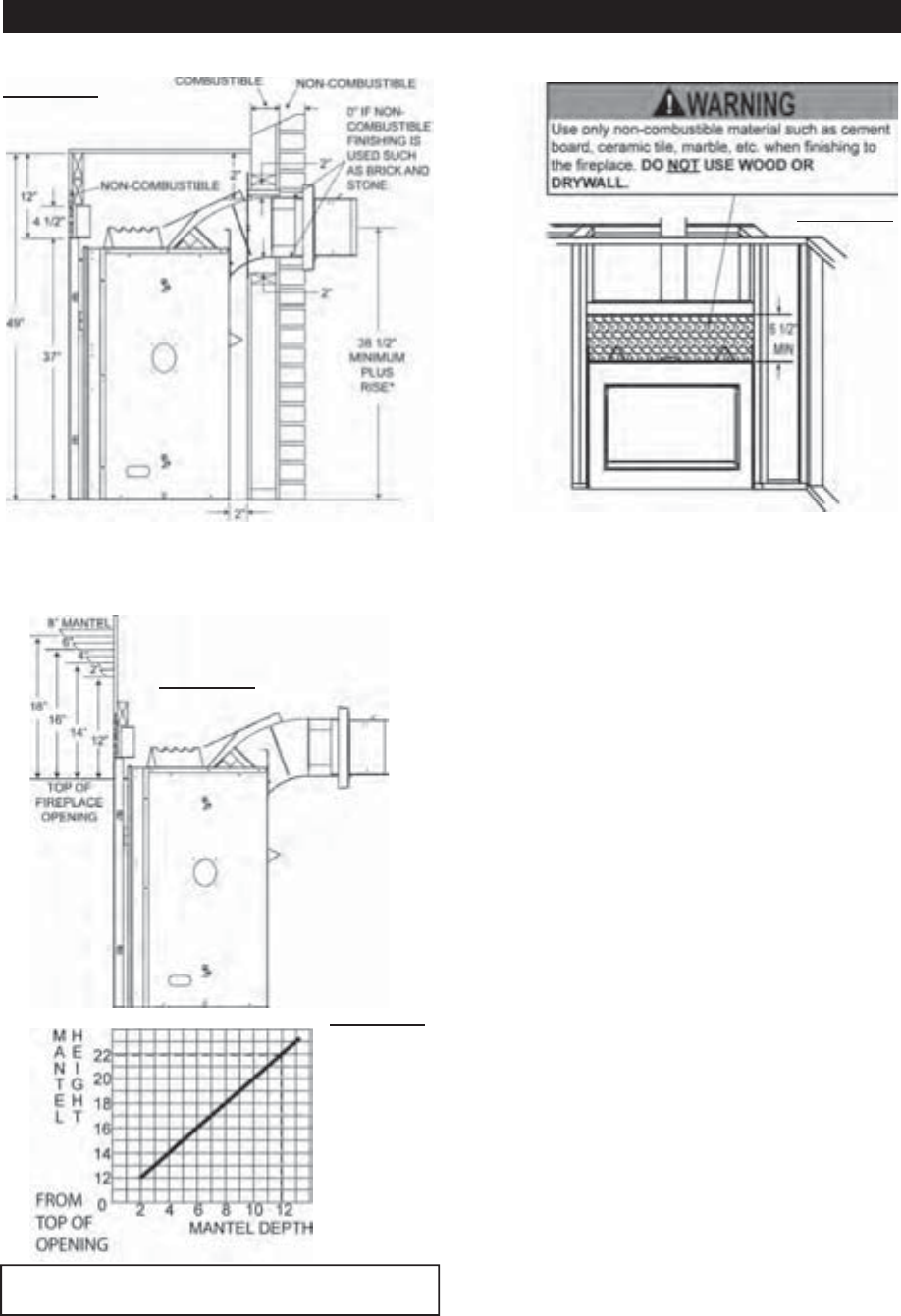
29
W415-0661 / C / 02.20.08
Combustible mantel clearance can vary according to the mantel depth. Figure 92. Use the graph to help evaluate the
clearance needed. These same requirements apply to any combustibles protruding on either side of the fi replace.
BGD42CF MINIMUM MANTEL AND ENCLOSURE CLEARANCES
This fi replace requires a minimum of 6 1/2" of cement board or
non-combustible equivalent above the top of the fi replace.
FIGURE 92b
FIGURE 92a
The fi replace requires a minimum enclosure height of 49“. For
temperature requirements, the enclosure space around and above
the fi replace must be left unobstructed.
* See Venting Section
FIGURE 92d
FIGURE 92c
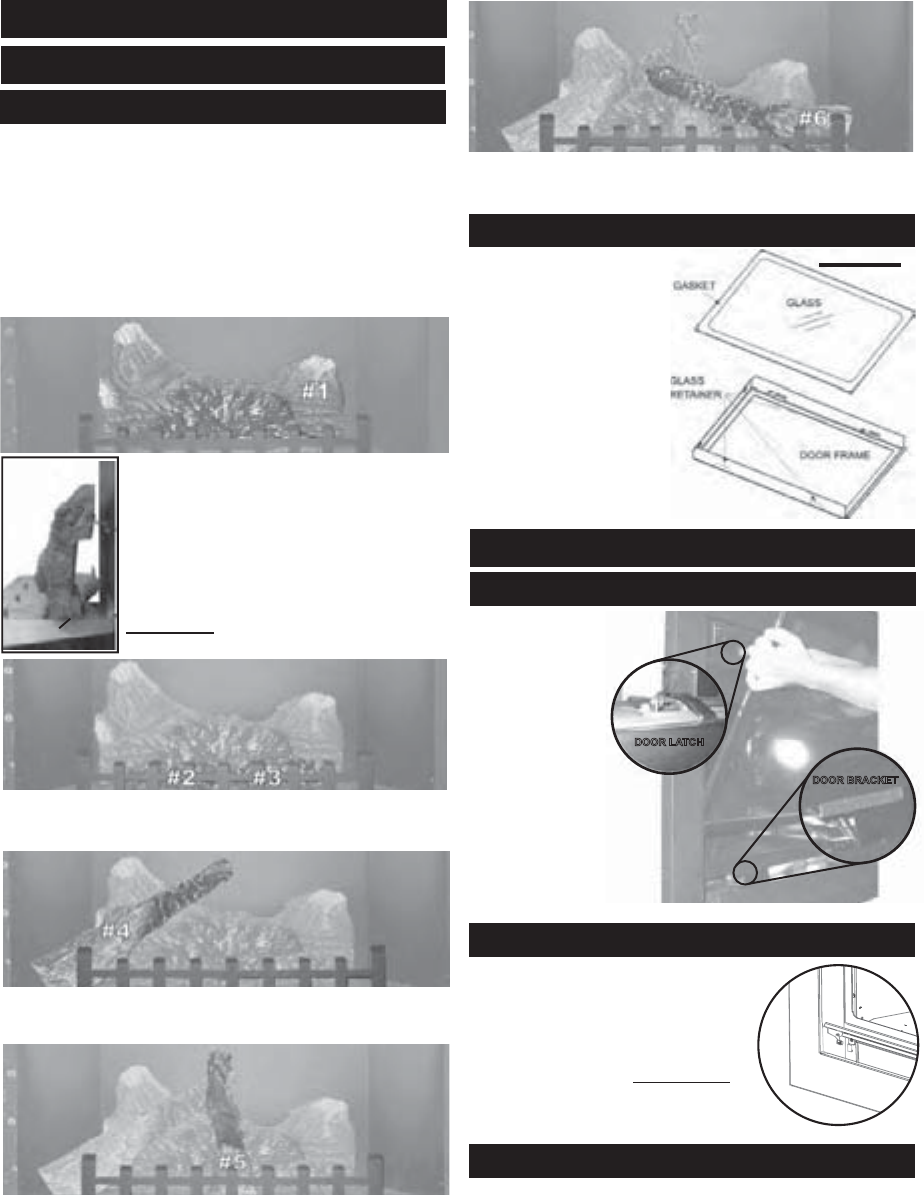
30
W415-0661 / C / 02.20.08
DOOR LATCH
DOOR BRACKET
FIGURE 100
FIGURE 100
FINISHING
3. Place the bottom of the left crossover log (#4) against the left
fi rebox side and pulled forward to the grate.
The top of the log should rest in the pocket on the back log.
PHAZER
TM
logs and glowing embers exclusive to Napoleon® Fire-
places, provide a unique and realistic glowing effect that is different
in every installation. Take the time to carefully position the glowing
embers for a maximum glowing effect.
Log colours may vary. During the initial use of the fi replace, Log
colours may vary. During the initial use of the fi
replace the colours
will become more uniform as colour pigments burn in during the heat
activated curing process.
LOG PLACEMENT
TAB
SIDEVIEW
FIGURE 93
FIGURE 93
FIGURE 94
FIGURE 95
FIGURE 95
FIGURE 96
FIGURE 96
FIGURE 97
FIGURE 97
2. Move the two small logs (#2 & #3) into position, lining up the
studs located on the burner with the holes on the bottom of the
logs. Ensure that the small logs sit fl at on the burner.
BGD36CF FINISHING
1. Place the back log (#1) onto the log support
tray and in front of the tabs. The tabs maintain
an air space between the log and fi rebox back
to facilitate combustion air fl ow. Ensure that the
back of the log rests against the brackets on the
back wall of the fi rebox.
FIGURE 98
FIGURE 98
5. Place the bottom of the right crossover log (#6) against the right
fi rebox side and pulled forward to the grate. The top of the log
should rest in the pocket provided on the center log (#5).
BGD42CF FINISHING
DOOR INSTALLATION / REMOVAL
Open the Valve Access
Door. While holding the
door securely, release
the 4 latches along
the top of the door.
Tilt the door forward
and lift off of the
two brackets at the
bottom of the door.
When replacing the
door, rest the door on the
brackets ensuring that lip
of the brackets rest in the
groove in the bottom edge
of the door. Push the door
backward into place and
secure with the 4 latches.
4. Position the base end of the center log (#5) against the middle
grate post with the other end of the log resting in the pocket of the
left crossover log.
REMOVING THE VALVE ACCESS DOOR
1. The valve access door rotates on the
pins attached to the side frame. Lift the
valve access door off the pins to operate
the main glass door.
FIGURE 101
GLASS/DOOR REPLACEMENT
Only available as an assembly complete with frame W010-0770.
Glass not available seperately.
BGD36CF(G) GLASS/DOOR REPLACEMENT
FIGURE99
1. Place the door frame face down care-
ful not to scratch the paint.
2. Center the gasketed glass
inside the door frame with the
thick side of the gasket fac-
ing up.
3. Bend the glass retainers lo-
cated along the edge of the door
frame over the gasket holding
the glass in place. Careful not to
break the glass.
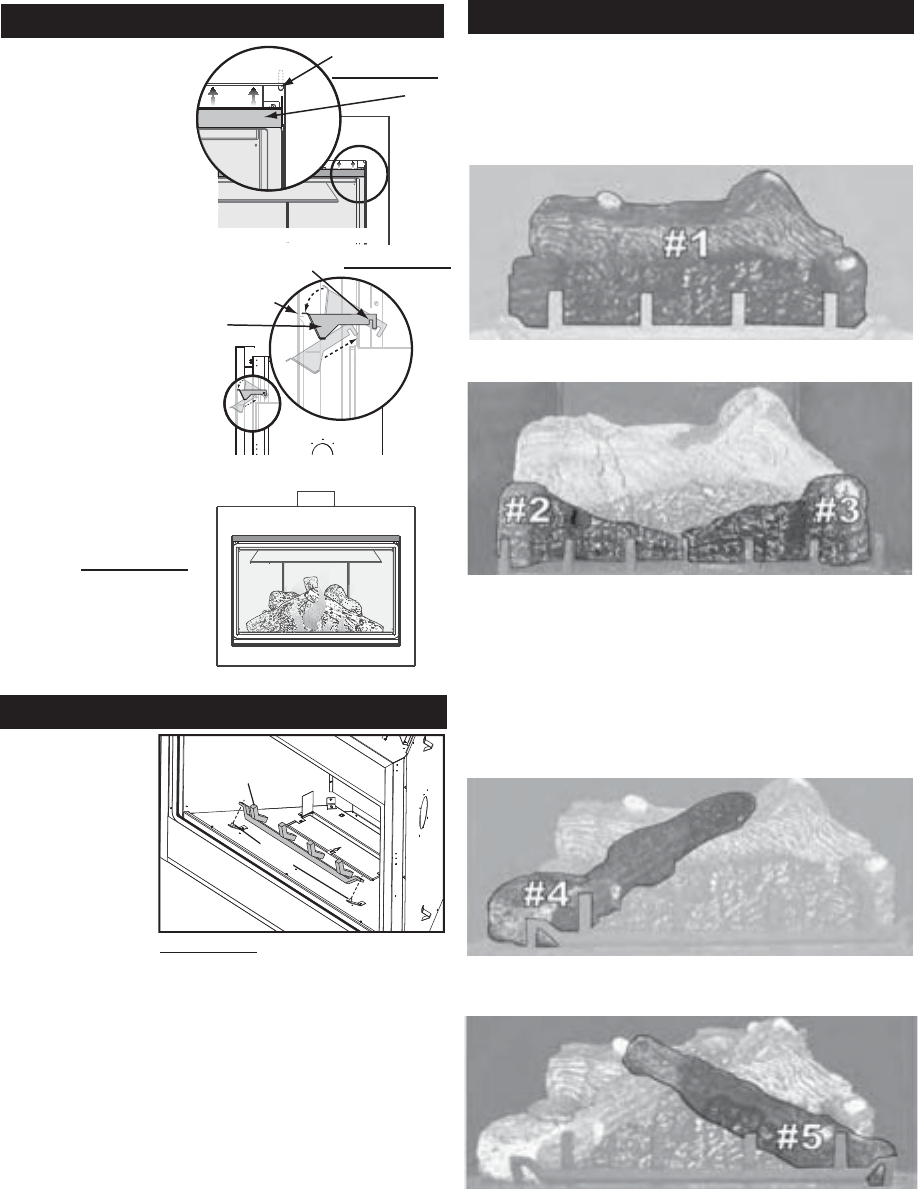
31
W415-0661 / C / 02.20.08
GRATE INSTALLATION
The grate for this
fi replace has been
removed for shipping
purposes.
The grate must be in-
stalled before the logs
are installed.
Remove the packag-
ing from the grate and
install onto the two pins
as illustrated.
GRATE
PINS
FIGURE 103
DOOR TRIM
The BGD42CF comes
complete with top door
trim
(W715-0729).
1. Guide the arms of the
trim into the slots that are
slightly hidden under the
facing through the open-
ing between the top of the
door and the bottom edge
of the facing as illustrated
in the front view.
2. Slide the arm into the slot
far enough to allow the front
edge of the trim to go in
behind the facing.
3. Let the bracket come
forward towards the back of
the facing and allow the trim
to rest on the inside lip, this
position will allow the notch
on the arm of the trim to
fall into place on the edge
of the slot.
NOTCH
INSIDE LIP
S
E
E
-
T
H
R
U
W
I
N
D
O
W
BGD42CF SIDE VIEW
BGD42CF WITH TOP DOOR TRIM INSTALLED
SLOT
TRIM
FACING
DOOR
BGD42CF FRONT VIEW
FIGURE 102a
FIGURE 102c
FIGURE 102b
LOG PLACEMENT
FIGURE 104
FIGURE 104
PHAZER
TM
logs and glowing embers, exclusive to Napoleon®
Fireplaces, provide a unique and realistic glowing effect that is
different in every installation. Take the time to carefully position the
glowing embers for a maximum glowing effect. Log colours may
vary. During the initial use of the fi replace, the colours will become
more uniform as colour pigments burn in during the heat activated
curing process.
1. Place the cutout in the bottom of log #1 behind the pilot assembly.
Rest the log against the back wall of the fi rebox.
FIGURE 105
FIGURE 105
2. Move the two small logs (#2 & #3) into position, lining up the studs
located on the burner with the holes on the bottom of the logs.
3. Tear the glowing embers into pieces and place along the front
row of ports covering all of the burner area in front of the small
logs (#2 & #3). Care should be taken to shred the embers into thin,
small irregular pieces as only the exposed edges of the fi bre hairs
will glow. The ember material will only glow when exposed to direct
fl ame; however, care should be taken to not block the burner ports.
Blocked burner ports can cause an incorrect fl ame pattern, carbon
deposits and delayed ignition. PHAZERtm logs glow when exposed
to direct fl ame.
4. Place the bottom of the left crossover log (#4) onto the stud on
the left side of the log support. The top of the log should rest in the
pocket on the back log.
FIGURE 106
FIGURE 106
FIGURE 107
FIGURE 107
5. Place the bottom of the right crossover log (#5) onto the stud on
the right side of the log support. The top of the log should rest in
the pocket on the left crossover log (#4).
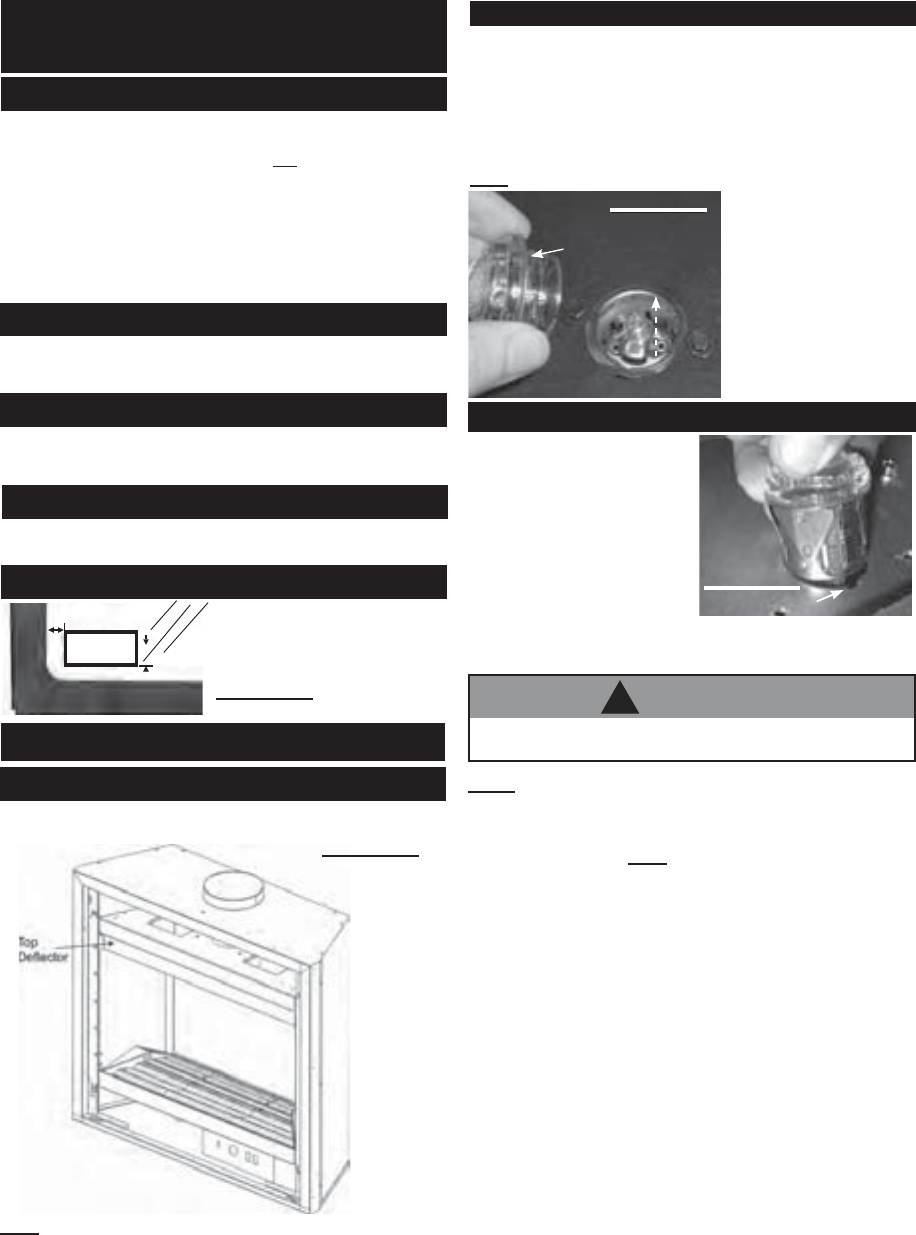
32
W415-0661 / C / 02.20.08
Remove the backing of the logo
supplied and place on the glass
viewing door, as indicated.
GLOWING EMBERS
LOGO PLACEMENT
½"
½"
LOGO
Tear the embers into pieces and place along the front row of ports
covering all of the burner area in front of the small logs (#2 & #3). Care
should be taken to shred the embers into thin, small irregular pieces
as only the exposed edges of the fi bre hairs will glow. The ember
material will only glow when exposed to direct fl ame; however,
care should be taken to not block the burner ports.
Blocked burner ports can cause an incorrect fl ame pattern, carbon
deposits and delayed ignition. PHAZER
TM
logs glow when exposed
to direct fl ame. Use only certifi ed "glowing embers" and PHAZER
TM
logs available from your Napoleon® dealer.
Randomly place the charcoal embers along the front and sides of
the log support tray in a realistic manner. Fine dust found in the
bottom of the bag should not be used.
Sprinkle vermiculite around the charcoal embers.
Note: Both charcoal embers and vermiculite are not to be placed
on the burner.
CHARCOAL EMBERS
VERMICULITE
COMMON FINISHING
BGD36CF / BGD42CF
BGD36CFG BULB REPLACEMENT
The BGD36CFG comes equipped with our “Night Light™”.
If in the event the lamp or lens needs to be replaced, follow these
instructions.
1. Turn off all electrical supply.
2. Remove the glass and glass ember tray from the fi rebox.
3. Unscrew the lens cover making sure the gasket stays
in place.
Note: Do not handle the lamp (bulb) with bare fi ngers, protect with
a clean dry cloth.
4. The lamp will pull straight
out of the socket. Replace with
Wolf Steel Ltd. parts only
(W387-0006), as lamp and
lens are special "high
temperature" products.
5. Replace lens cover.
6. Replace glass and ember
tray.
1. Remove the glass and glass
ember tray.
2. Remove the burner base from
the fi rebox.
3. Compress the retainer fins
and lift out the lens assembly,
disconnect the wires.
4. Replace lens assembly by
aligning key hole and snap into
place, re-connect wires.
5. Re-install burner base ensuring
a good fi rebox seal.
6. Re-install glass ember tray and glass.
The front of the fi replace becomes very hot during operation.
Let the fi replace cool completely before conducting service.
NOTE: When removing the glass ember tray make sure the glass
embers are away from the center of the screen, exposing the burner,
before lifting glass ember tray out.
When replacing burner, absolutely no glass embers can be in cup
surrounding the orifi ce. HINT: If glass falls into cup and surrounds
the orifi ce, insert a clean bag into a vacuum cleaner and vacuum
out glass embers or replacement glass embers can be ordered from
Wolf Steel Ltd.
BGD36CFG LENS ASSEMBLY REPLACEMENT
FIGURE 110
Gasket
KEY HOLE
FIGURE 111
BGD36CFG FINISHING
GLASS BURNER INSTALLATION
Spread the clear glass embers (W300-0102) onto the glass ember
tray evenly covering the burner tube (follow natural shape of tray).
FIGURE 109
Note: The distribution of clear glass embers over the burner tube
will infl uence the fl ame height.
FIGURE 108
!
WARNING
CHARCOAL LUMPS (BGD42CF ONLY)
Place the lumps between the logs in a realistic manner taking care
not to block any of the burner ports.
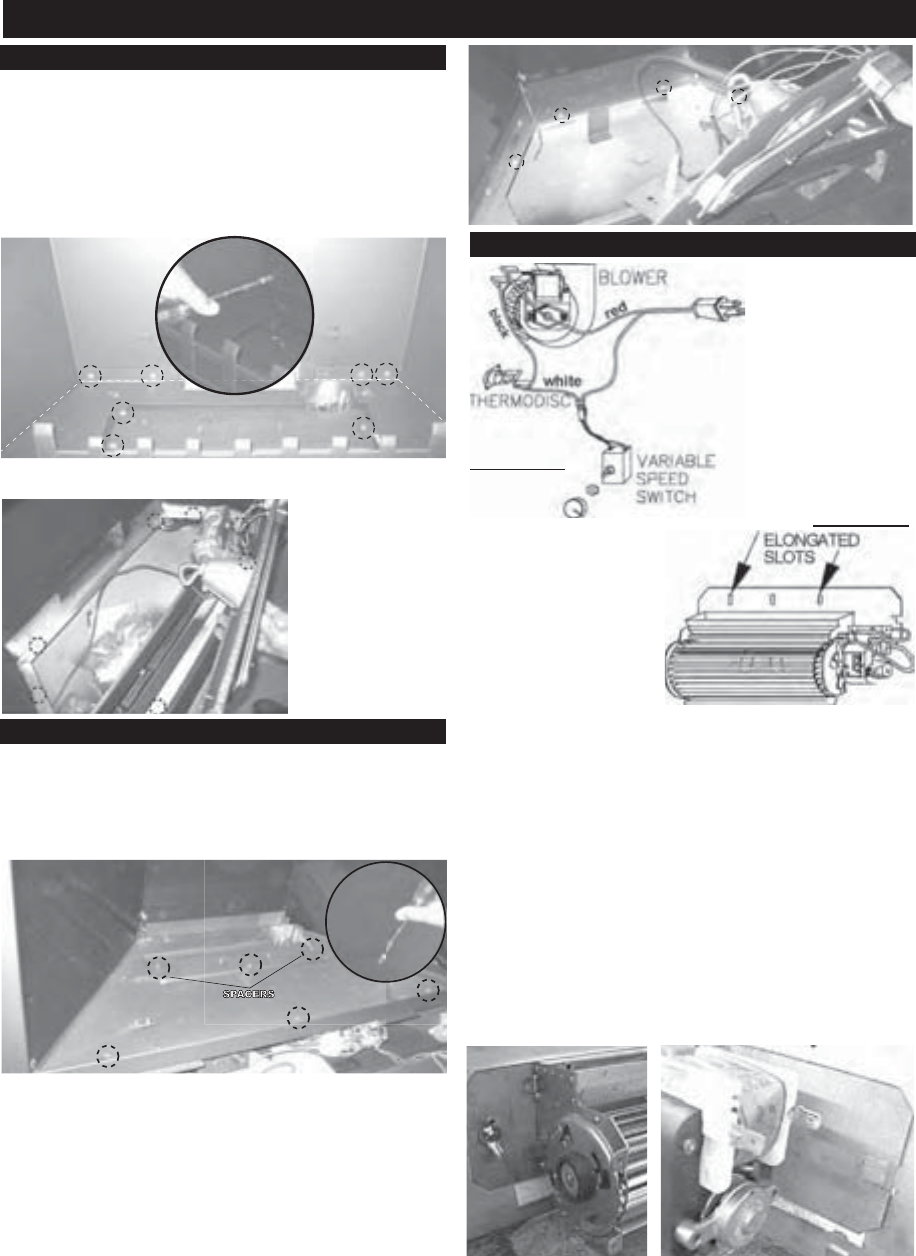
33
W415-0661 / C / 02.20.08
FIGURE 116
FIGURE 117
A
A
B
B
FIGURE 118a
FIGURE 118a
C
C
FIGURE 118b
FIGURE 118b
INSTALLING THE BLOWER
INSTALLATION TO BE
DONE BY A QUALI-
FIED INSTALLER and
must be electrically con-
nected and grounded in
accordance with local
codes. In the absence
of local codes, use
the current CSA C22.1
C
ANADIAN ELECTRICAL
CODE in Canada or the
ANSI/NFPA 70
NATIONAL
ELECTRICAL CODE in the
United States
If the fireplace was not
previously equipped with
a blower: route a grounded
2-wire, 60hz power cable
to the receptacle / junction
box. At this point, it must
be strain relieved and in-
sulated.
Because the blower is
thermally activated, when
turned on, it will automatically start approximately 10 minutes
after lighting the fi replace and will run for approximately 30-45
minutes after the fi replace has been turned off. Use of the fan
increases the output of heat.
The three slots on the blower mounting bracket allow ease of adjust-
ment when attaching the blower. For a quiet running blower, do not
allow the assembly to sit on the fi rebox base.
Slide the vibration reducing pad (A) into the clip (C) and up against
the threaded stud (B) at the other end. The blower must be able to
be positioned entirely onto the pad.
To ease installation of the blower, remove the hinge screen and valve
control door (lower louvres) from the base of the fi replace.
Tilt the blower onto its side. Slide it past the controls and into the clip
(C). Secure to the threaded stud using the lock washer and wing nut
provided. Ensure that the blower does not touch the fi replace base
or the fi rebox.
5. Remove the 8 perimeter screws as illustrated in Fig. 112a and
lift out the burner base. (The gas line fl ex-connector should pro-
vide suffi cient move-
ment to permit shifting
the burner assembly
to the side).
6. Reverse procedure
to re-assemble.
OPTIONAL BLOWER INSTALLATION
BGD36CF(G) ACCESSING THE BLOWER
1. Remove the valve access door.
2. Open the main door.
3. Carefully remove the logs.
3a. (BGD36CFG) Carefully remove the glass and glass ember
tray.
4. Remove the 7 screws illustrated in Fig. 112a and lift out the log
support.
4a. (BGD36CFG) Remove the top defl ector and porcelain panels
from the fi rebox. (See Figure 109).
FIGURE 112a
FIGURE 112a
FIGURE 112b
FIGURE 112b
BGD42CF ACCESSING THE BLOWER
1. Remove the main door using the instructions on Pg #29.
2. Carefully remove the logs.
3. Remove the grate by lifting it off of the two securing pins.
4. Remove the 6 screws illustrated in Fig. 112b and lift out the
log support. Be careful not to lose the spacers for the screws
indicated.
5. Remove the 7 perimeter screws as illustrated in Fig. 113 and lift
out the burner base. (The gas line fl ex-connector should provide
suffi cient movement to permit shifting the burner assembly to the
side).
6. Reverse procedure to re-assemble.
SPACERS
FIGURE 113
FIGURE 113
FIGURE 114
FIGURE 114
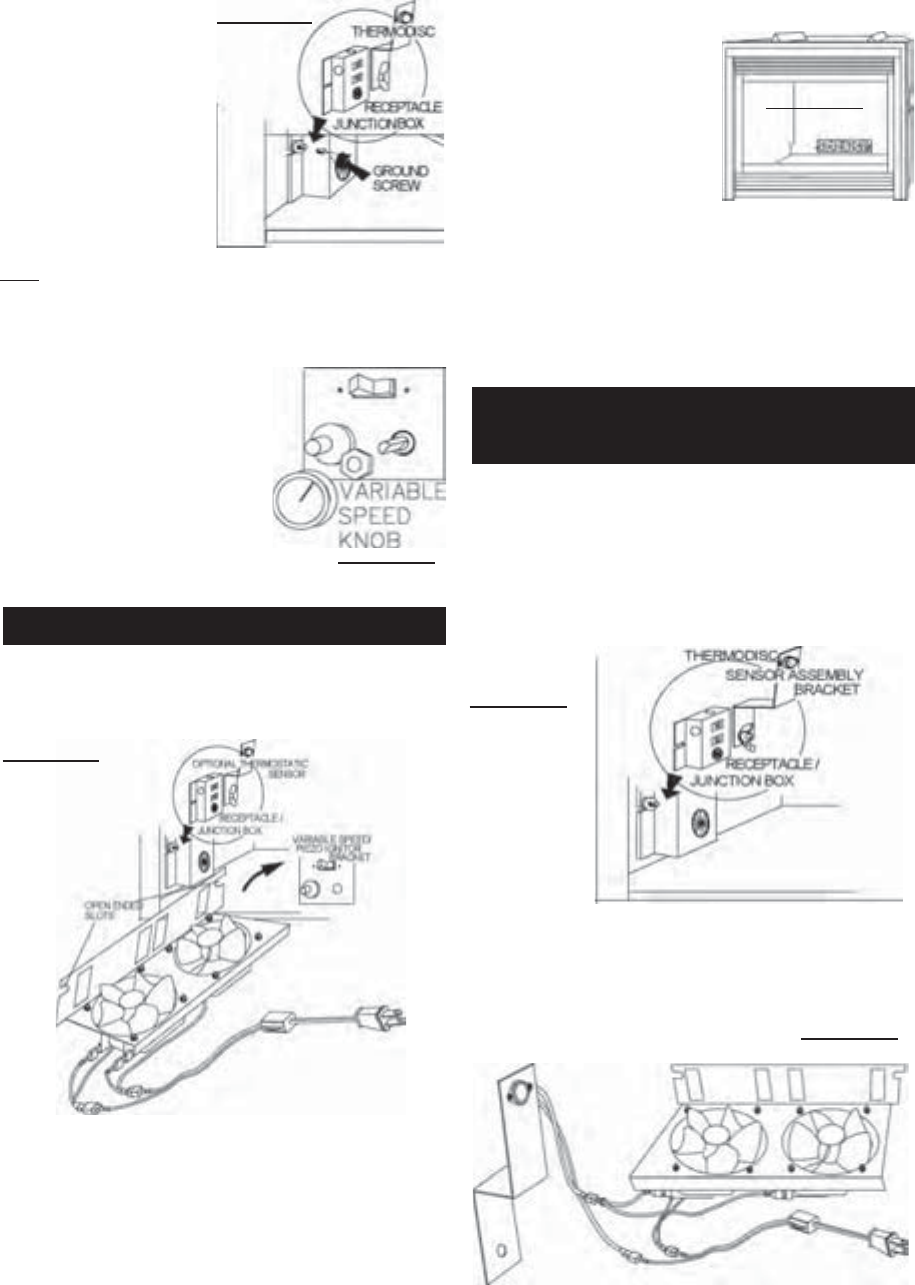
34
W415-0661 / C / 02.20.08
FIGURE 119
Drywall dust will penetrate into the
blower bearings, causing irrepara-
ble damage. Care must be taken to
prevent drywall dust from coming
into contact with the blower or its
compartment. Any damage resulting
from this condition is not covered by
the warranty policy.
FIGURE 120
Attach the connectors from
the black and white wires to
the thermodisc and secure the
thermodisc bracket to the secur-
ing stud at the bottom left of the
unit using a lock washer and wing
nut. Ensure that the thermodisc
touches the fi rebox wall.
Attach the connectors from
the black and red wires to the
blower.
Attach and secure the vari-
able speed switch using the
nut provided. Plug the har-
ness cord into the receptacle.
Note: To improve access to the variable speed control, we recom-
mend bending the mounting bracket forward by approximately 10°.
The wire harness provided in this kit is a universal harness.
When installed, ensure that any excess wire is contained, pre-
venting it from making contact with moving or hot objects.
To safely install the fan, turn off the electricity fi rst.
If the fi replace was not previously equipped with a fan: route a
grounded 2-wire, 60hz power cable to
the junction box. At this point, it must
be strain relieved and insulated.
The wire harness provided in this
kit is a universal harness. When in-
stalled, ensure that any excess wire is
contained, preventing it from making
contact with moving or hot objects.
To ease installation of the fan, remove
the hinge screen and valve control door (lower louvres) from the
base of the fi replace.
Position the vibration reducing pad into the clip and onto the threaded
stud at the other end, piercing a hole into the pad. The fan assembly
must be able to be positioned entirely onto the pad.
Slide the fan assembly past the controls and into the clip. Secure
using the lock washer and nut provided.
Plug the harness cord into the receptacle.
Attach and secure the sensor assembly bracket to the securing stud
located next to the receptacle/junction box at the bottom left of the
unit using the lock washer and wing nut. Ensure that the thermodisc
touches the fi rebox wall.
Plug the power cord back into the receptacle.
When installed, ensure that any excess wire is contained, preventing
it from making contact with moving or hot objects.
ELECTRICAL INSTALLATION TO BE DONE BY A QUALIFIED IN-
STALLER and must be connected and grounded in accordance with
local codes. In the absence of local codes, use the current CSA C22.1
C
ANADIAN ELECTRICAL CODE in Canada or the ANSI/NFPA 70 NATIONAL
ELECTRICAL CODE in the United States.
This optional kit is meant to be used only in conjunction with the
GD65 Fan Kit, shown above, which may be ordered from your Wolf
Steel / Napoleon® dealer.
With the thermostatic sensor option, the fan, when turned on, be-
comes thermally activated, and will automatically run approximately
15-30 minutes after the fi replace has been lit and for approximately
30-45 minutes after the fi replace has been turned off.
Use of the fan increases the output of heat.
Unplug the power cord from the receptacle. Connect all wires as
shown.
OPTIONAL FAN INSTALLATION
GD36 THERMOSTATIC
SENSOR CONTROL
FIGURE 121
FIGURE 123
FIGURE 122
FIGURE 124
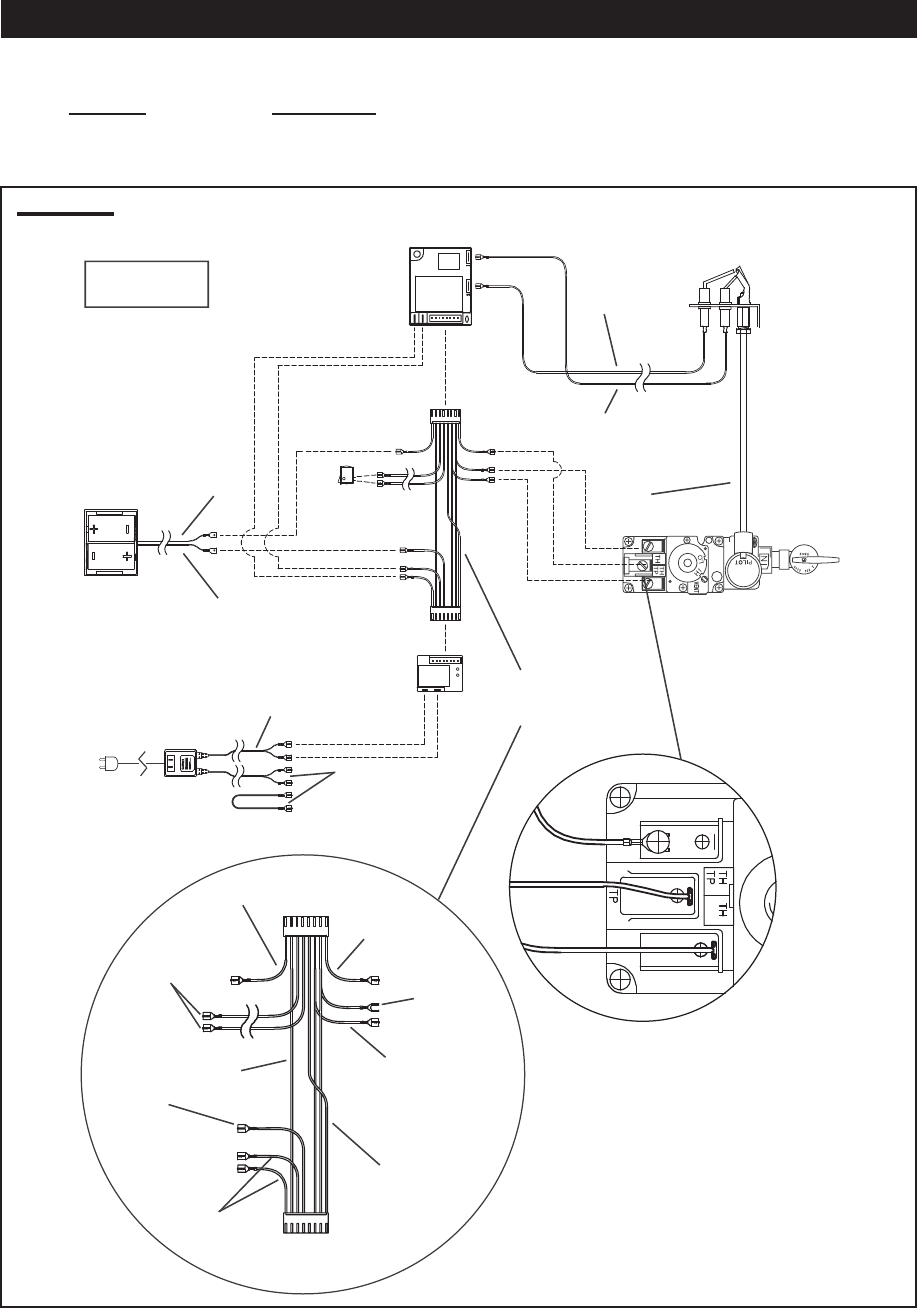
35
W415-0661 / C / 02.20.08
BGD36CFG BURNER SWITCH / WIRING DIAGRAM
A wall switch must be installed in a convenient location for the burn-
er operation.
The recommended maximum lead length depends on wire size:
WIRE SIZE MAX. LENGTH
14 gauge 100 feet
16 gauge 60 feet
18 gauge 40 feet
A 20’ length of millivolt wire is connected to the gas valve for the
burner wall switch. However if a greater length is required route
2-strand (solid core) wire through the electrical hole located at the
bottom left side of the unit.
FIGURE 125
BATTERY
HOLDER
GAS VALVE
PILOT
ASSEMBLY
IGNITION
MODULE
PILOT
GAS LINE
Orange
(I)
[through
independent
conduit]
Yellow
(S)
[through
Gas line
conduit]
AC ADAPTOR
BATTERY
RELAY
Red (3 Volt)
Red
Black
WIRE
HARNESS
NOTE: WIRE TAGS
ARE BRACKETED
Brown
(SWI)
Black
(-)
Red
(+)
Green x2
(TH)
Orange x2
(THTP)
Black
Yellow
Blue
Black
(TP)
MODULE
PLUG
RELAY
PLUG
Black
Green
Orange
BLACK (12 Volt)
TO LIGHT & LIGHT
TM
SWITCH
(20’ REMOTE SWITCH
WIRE SUPPLIED)
MAIN BURNER SWITCH
(20’ REMOTE SWITCH
WIRE SUPPLIED)
*
Main Burner Switch
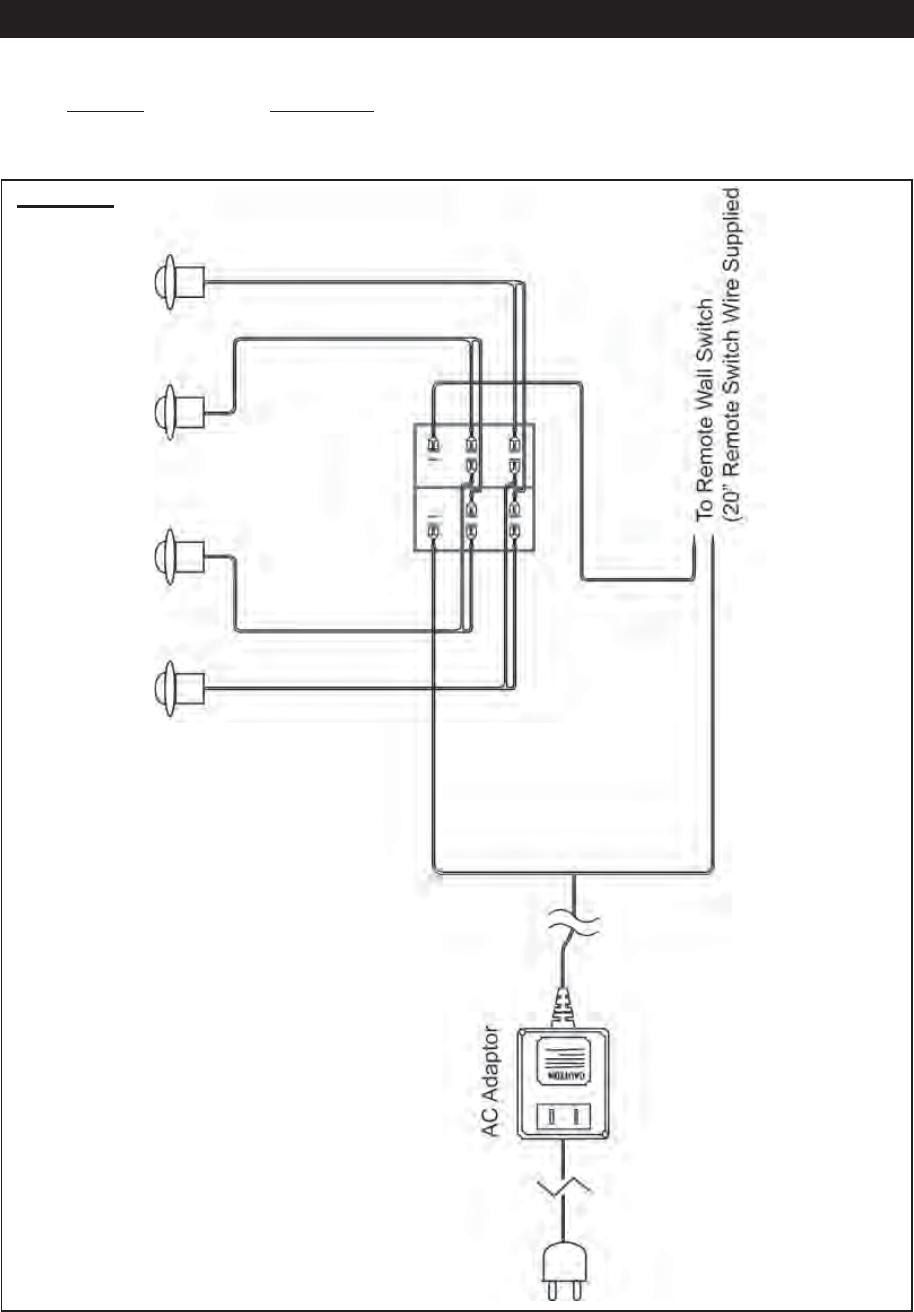
36
W415-0661 / C / 02.20.08
BGD36CFG LIGHT SWITCH / WIRING DIAGRAM
FIGURE 126
A wall switch must be installed in a convenient location for the light
operation.
The recommended maximum lead length depends on wire size:
WIRE SIZE MAX. LENGTH
14 gauge 100 feet
16 gauge 60 feet
18 gauge 40 feet
A 20’ length of millivolt wire is connected to the gas valve for the
light wall switch. However if a greater length is required route 2-
strand (solid core) wire through the electrical hole located at the
bottom left side of the unit.
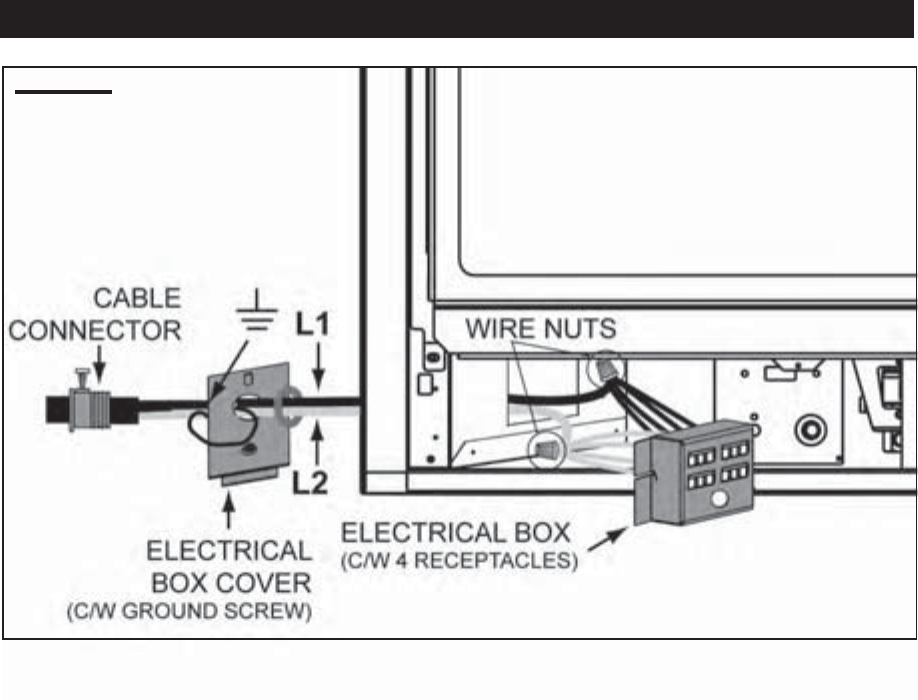
37
W415-0661 / C / 02.20.08
RECEPTACLE WIRING DIAGRAM
FIGURE 127
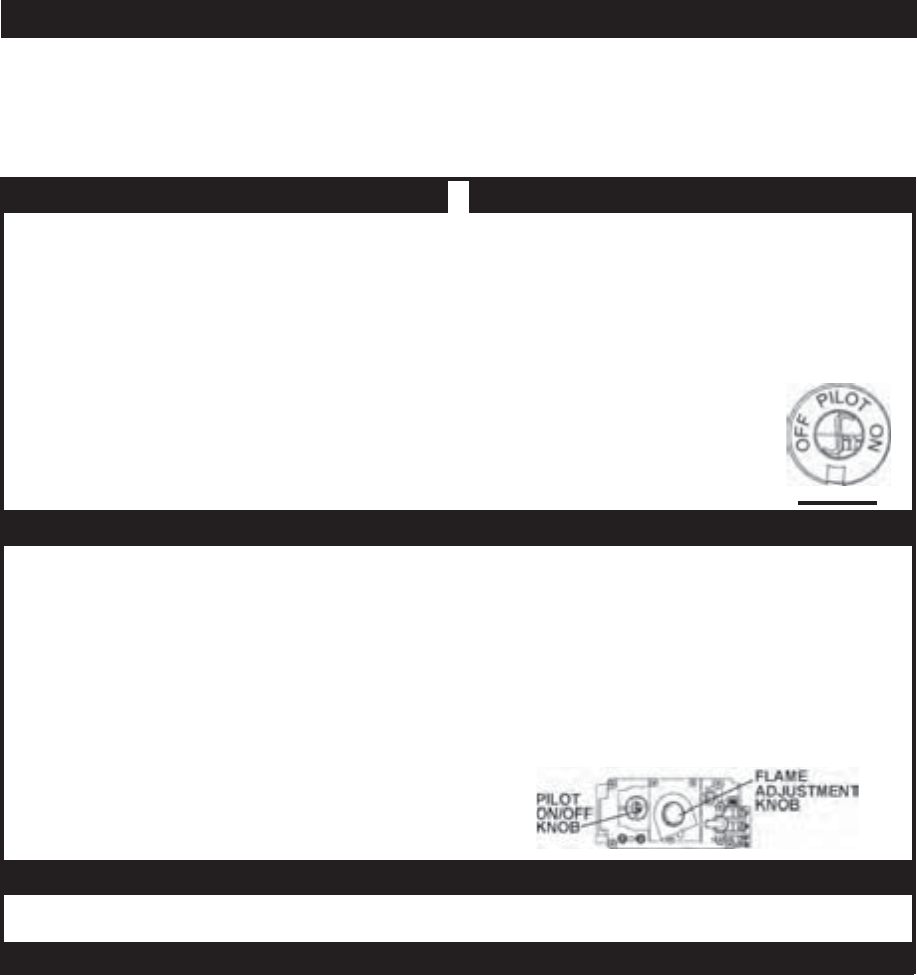
38
W415-0661 / C / 02.20.08
After extended periods of non-operation such as following a
vacation or a warm weather season, the fi replace may emit a
slight odour for a few hours. This is caused by dust particles in
the heat exchanger burning off. In both cases, open a window
to suffi ciently ventilate the room.
Purge all gas lines with the glass door of the fi replace removed
or opened. Assure that a continuous gas fl ow is at the burner
before installing the door.
When lit for the fi rst time, the fi replace will emit a slight odour
for a few hours. This is a normal temporary condition caused
by the "burn-in" of internal paints and lubricants used in the
manufacturing process and will not occur again.
• Turn off all gas to the fi replace.
• Open windows.
• Do not try to light any appliance.
• Do not touch any electric switch; do not use any phone in your
building.
• Immediately call your gas supplier from a neighbour's phone.
Follow the gas supplier's instructions.
• If you cannot reach your gas supplier, call the fi re depart-
ment.
GAS KNOB
A. This fi replace is equipped with a pilot which must be lit by hand
while following these instructions exactly.
B. Before operating smell all around the fi replace area for gas and
next to the fl oor because some gas is heavier than air and will
settle on the fl oor.
C. Use only your hand to turn the gas control knob. Never use
tools. If the knob will not turn by hand, do not try to repair it. Call
a qualifi ed service technician. Force or attempted repair may
result in a fi re or explosion.
D. Do not use this fi replace if any part has been under water. Im-
mediately call a qualifi ed service technician to inspect the fi replace
and replace any part of the control system and any gas control
which has been under water.
WARNING: The gas valve has an interlock device which will not
allow the pilot burner to be lit until the thermocouple has cooled.
Allow approximately 60 seconds for the thermocouple to cool.
When lighting and re-lighting, the gas knob cannot be turned from
pilot to off unless the knob is depressed slightly.
1. Stop! Read the above safety information on this label.
2. Turn off all electric power to the fi replace.
3. Turn the gas knob clockwise to off.
4. Wait fi ve (5) minutes to clear out any gas. If you smell gas includ-
ing near the fl oor. Stop! Follow "B" in the above safety information
on this label. If you don't smell gas go the next step.
5. Turn gas knob counter-clockwise to pilot.
6. Depress slightly and hold gas knob while lighting the pilot with
the push button igniter. Keep knob depressed for one minute, then
release. If pilot does not continue to burn, repeat steps 3 through
5.
7. With pilot lit, depress and turn gas knob counter-clock-wise to
on.
8. If equipped with remote on-off switch/thermostat, main burner
may not come on when you turn valve to on. Remote switch must
be in the on position to ignite burner.
9. Turn on all electric power to the fi replace.
1. Turn off all electric power to the fi replace if service is to be
performed.
2. Push in gas control knob slightly and turn clockwise to off. Do
not force.
OPERATION BGD36CF & BGD42CF
FOR YOUR SAFETY READ BEFORE LIGHTING: WHAT TO DO IF YOU SMELL GAS:
LIGHTING INSTRUCTIONS
TO TURN OFF GAS
TURN THE CONTROL VALVE TO THE OFF POSITION WHEN HEATER IS NOT IN USE.
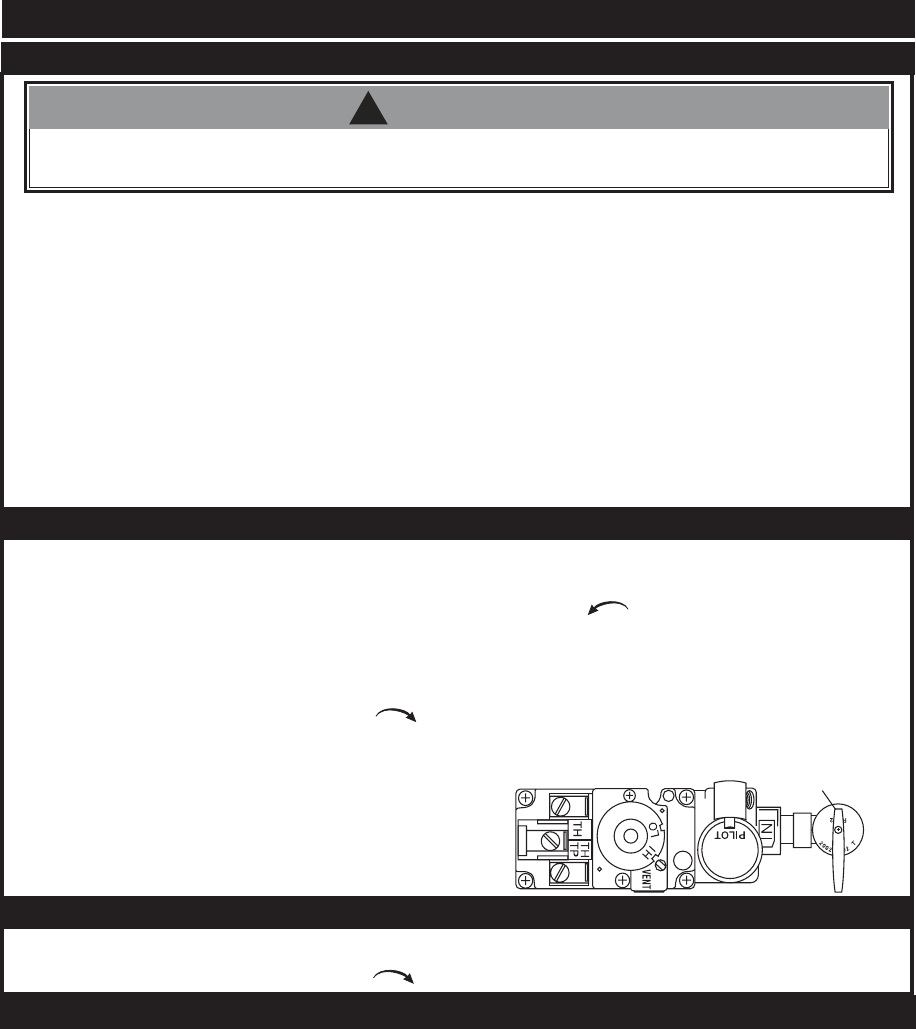
39
W415-0661 / C / 02.20.08
1. STOP! READ THE ABOVE SAFETY INFORMATION ON
THIS LABEL.
2. TURN REMOTE WALL SWITCH TO OFF POSITION.
3. TURN OFF ALL ELECTRIC POWER TO THE FIREPLACE
AND REMOVE BATTERIES.
4. THIS FIREPLACE IS EQUIPPED WITH AN IGNITION
DEVICE WHICH AUTOMATICALLY LIGHTS THE PILOT. DO
NOT TRY TO LIGHT THE PILOT BY HAND.
5. TURN MANUAL SHUTOFF VALVE CLOCKWISE TO
OFF.
6. OPEN THE GLASS DOOR.
7. WAIT FIVE (5) MINUTES TO CLEAR OUT ANY GAS. IF
YOU SMELL GAS INCLUDING NEAR THE FLOOR, STOP!
FOLLOW "B" IN THE ABOVE SAFETY INFORMATION ON
THIS LABEL. IF YOU DON'T SMELL GAS GO TO THE
IF YOU DO NOT FOLLOW THESE INSTRUCTIONS EXACTLY, A FIRE OR EXPLOSION MAY RESULT CAUSING
PROPERTY DAMAGE, PERSONAL INJURY OR LOSS OF LIFE.
TO TURN OFF GAS
A. THIS FIREPLACE IS EQUIPPED WITH AN IGNITION DEVICE
WHICH AUTOMATICALLY LIGHTS THE PILOT. DO NOT TRY
TO LIGHT BY HAND.
B. BEFORE OPERATING SMELL ALL AROUND THE FIREPLACE
AREA FOR GAS AND NEXT TO THE FLOOR BECAUSE SOME
GAS IS HEAVIER THAN AIR AND WILL SETTLE ON THE
FLOOR.
C. USE ONLY YOUR HAND TO TURN THE GAS CONTROL
KNOB. NEVER USE TOOLS. IF THE KNOB WILL NOT TURN
BY HAND, DO NOT TRY TO REPAIR IT. CALL A QUALIFIED
SERVICE TECHNICIAN. FORCE OR ATTEMPTED REPAIR
MAY RESULT IN A FIRE OR EXPLOSION.
D. DO NOT USE THIS FIREPLACE IF ANY PART HAS BEEN
UNDER WATER. IMMEDIATELY CALL A QUALIFIED SERVICE
TECHNICIAN TO INSPECT THE FIREPLACE AND
REPLACE ANY PART OF THE CONTROL SYSTEM AND
ANY GAS CONTROL WHICH HAS BEEN UNDER
WATER.
WHAT TO DO IF YOU SMELL GAS:
• TURN OFF ALL GAS TO THE FIREPLACE.
• OPEN WINDOWS.
• DO NOT TRY TO LIGHT ANY APPLIANCE.
• DO NOT TOUCH ANY ELECTRIC SWITCH; DO NOT
USE ANY PHONE IN YOUR BUILDING.
• IMMEDIATELY CALL YOUR GAS SUPPLIER FROM A
NEIGHBOUR'S PHONE FOLLOW THE (GAS
SUPPLIER'S) INSTRUCTIONS.
• IF YOU CANNOT REACH YOUR GAS SUPPLIER, CALL
THE FIRE DEPARTMENT.
OPERATING INSTRUCTIONS
1. TURN OFF REMOTE WALL SWITCH TO THE FIREPLACE.
2. TURN OFF ALL ELECTRICAL POWER TO THE FIREPLACE IF SERVICE IS TO BE PERFORMED.
3. TURN MANUAL SHUTOFF VALVE CLOCKWISE TO OFF. DO NOT FORCE.
NEXT STEP.
8. CLOSE THE GLASS DOOR.
9. TURN MANUAL SHUTOFF VALVE COUNTER-
CLOCKWISE TO ON.
10. TURN ON ALL ELECTRIC POWER TO THE FIREPLACE
AND RE-INSTALL BATTERIES.
11. TURN ON REMOTE WALL SWITCH TO ON POSITION.
12. IF FIREPLACE WILL NOT OPERATE, FOLLOW
INSTRUCTIONS "TO TURN OFF GAS" AND CALL YOUR
SERVICE TECHNICIAN OR GAS SUPPLIER.
FOR YOUR SAFETY READ BEFORE OPERATING
OPERATION BGD36CFG
Manual Shut-off Valve
Shown in “OFF”
position.
TURN OFF THE GAS AND ELECTRICAL POWER BEFORE
SERVICING THE FIREPLACE.
CAUTION: Label all wires prior to disconnection when servicing
controls. Wiring errors can cause improper and dangerous operation.
Verify proper operation after servicing. This fi replace and its venting
system should be inspected before use and at least annually by a
qualifi ed service person. The fi replace area must be kept clear and
free of combustible materials, gasoline or other fl ammable vapours
and liquids. The fl ow of combustion and ventilation air must not be
obstructed.
1. In order to properly clean the burner and pilot assembly, remove
the logs to expose both assemblies.
2. Keep the control compartment, logs, burner, air shutter
opening and the area surrounding the logs clean by vacuuming or
brushing, at least once a year.
3. Check to see that all burner ports are burning. Clean out any of
the ports which may not be burning or are not burning properly.
4. Check to see that the pilot fl ame is large enough to engulf the
thermocouple and thermopile and reaches toward the burner with
the third jet.
5. Replace the cleaned logs.
6. Check to see that the main burner ignites completely on all open-
ings when the gas knob for the burner is turned on. A 5 to 10 second
total light-up period is satisfactory. If ignition takes longer, consult
your Napoleon® dealer / distributor.
7. Check that the gasketing on the sides, top and bottom of the door
is not broken or missing. Replace if necessary.
MAINTENANCE
!
WARNING
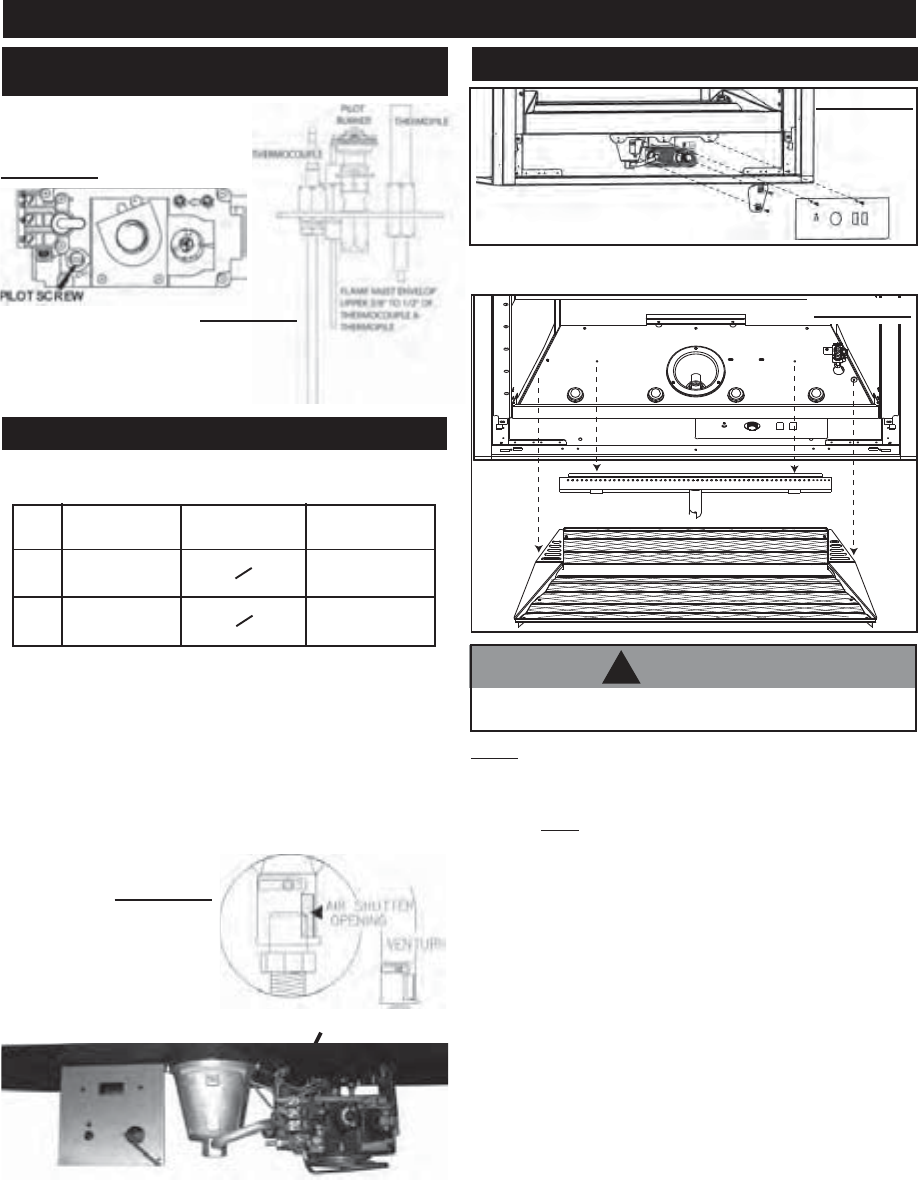
40
W415-0661 / C / 02.20.08
Both fi replace models have air shutters that have been factory set
open according to the chart below:
These settings are for (maximum) horizontal termination. Adjust-
ment may be required depending on fuel type, vent confi guration
and altitude.
Closing the air shutter will cause a more yellow fl ame, but can lead
to carboning. Opening the air shutter will cause a more blue fl ame,
but can cause fl ame lifting from the burner ports. The fl ame may not
appear yellow immediately; allow 15 to 30 minutes for the fi nal fl ame
colour to be established.
Air shutter adjustment must only be done by a qualifi ed
installer!
The alternate access is to remove the glass, glass ember tray and
burner from the fi replace and then adjust the air shutter.
The front of the fi replace becomes very hot during operation.
Let the fi replace cool completely before conducting service.
NOTE: When removing the glass ember tray make sure the glass
embers are away from the center of the screen, exposing the burner,
before lifting glass ember tray out.
When replacing burner, absolutely no glass can be in cup surrounding
the orifi ce. HINT: If glass falls into cup and surrounds the orifi ce, insert
a clean bag into a vacuum cleaner and vacuum out glass embers or
replacement glass embers can be ordered from Wolf Steel Ltd.
ADJUSTMENTS
PILOT BURNER ADJUSTMENT
EXCLUDING BGD36CFG
VENTURI ADJUSTMENT
FIGURE 128
FIGURE 129
FIGURE 130
VENTURI
FIGURE 131
FIGURE 131
FIGURE 132
FIGURE 133
BGD36CFG VENTURI ADJUSTMENT
NG
LP
BGD36CF BGD42CF
1/16"
1/4"
1/4"
7/16"
BGD36CFG
0
0
Adjust the pilot screw to provide prop-
erly sized fl ame. Turn in a clockwise
direction to reduce the gas fl ow.
To access the air shutter, remove the control panel, remove the
two screws that secure the cover to the air housing, loosen the set
screw and adjust air shutter position.
!
WARNING
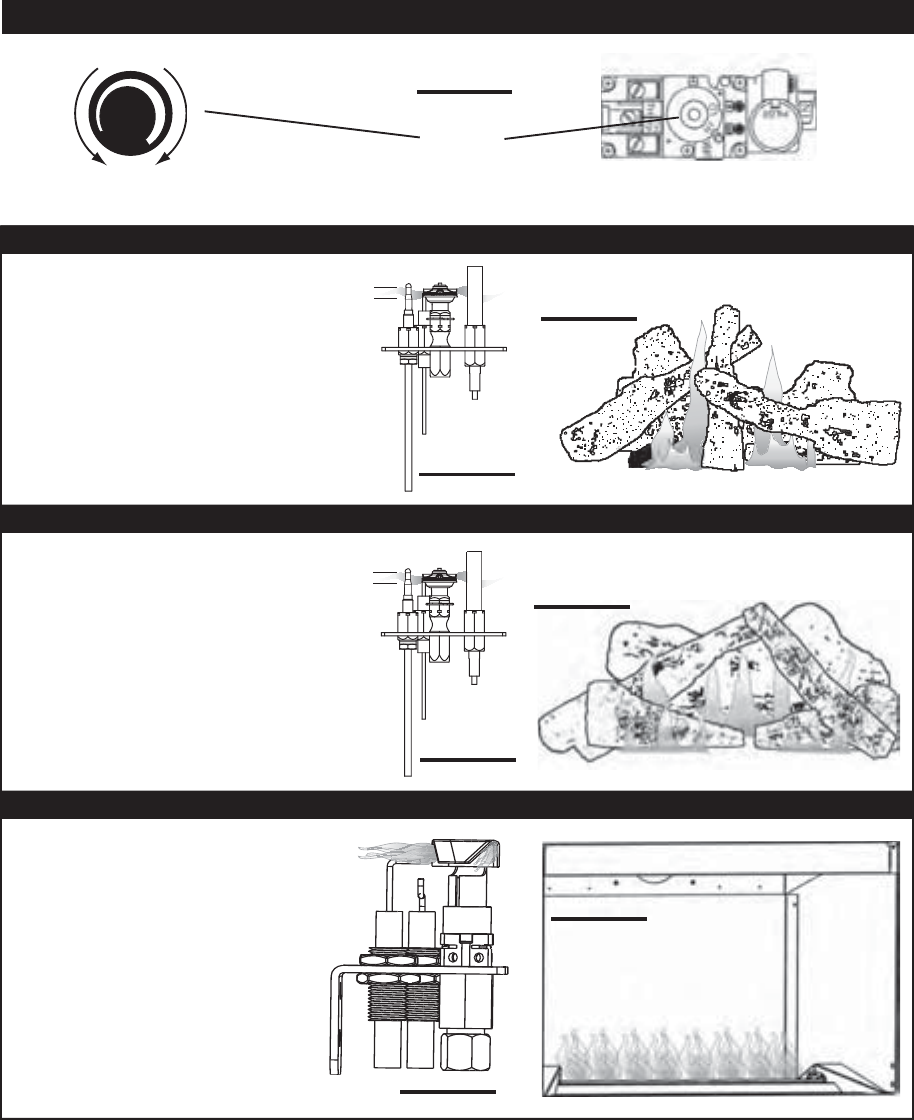
41
W415-0661 / C / 02.20.08
3/8” - 1/2”
FIGURE 139
FIGURE 137
3/8” - 1/2”
H
I
L
O
Turn clockwise to
increase fl ame height
FLAME
ADJUSTMENT KNOB
FIGURE 134
BGD36CF FLAME CHARACTERISTICS
It is important to periodically perform a visual
check of the pilot and the burner fl ames.
Compare them to the fi gures shown. If
any fl ames appear abnormal call a service
person.
FIGURE 136
FLAME ADJUSTMENT
It is important to periodically perform a visual
check of the pilot and the burner fl ames.
Compare them to the fi gures shown. If
any fl ames appear abnormal call a service
person.
FIGURE 138
It is important to periodically perform a visual
check of the pilot and the burner fl ames.
Compare them to the fi gures shown. If
any fl ames appear abnormal call a service
person.
FIGURE 140
FIGURE 135
For BGD36CF and BGD42CF
For BGD36CFG
BGD42CF FLAME CHARACTERISTICS
BGD36CFG FLAME CHARACTERISTICS

42
W415-0661 / C / 02.20.08
72* W175-0001 4" COUPLER
73* W175-0013 7" COUPLER
74* W615-0044 FIRESTOP SPACER - FLEXIBLE VENTING
75* W500-0103 TERMINAL EXTENSION PLATE
76 GD-301 HEAT GUARD
77* W010-0370 WALL SUPPORT ASSEMBLY
78* W175-0053 DURA-VENT ZERO CLEARANCE ADAPTOR
79 VS47KT VENT SLEEVE
80 W170-0063 VENT PIPE COLLAR
81 W585-0072 VENT PIPE SHIELD
82* W175-0159 CONVERSION KIT -
NG TO LP
83* W175-0164 CONVERSION KIT - LP TO NG
84* GD831KT DECORATIVE BRICK PANELS - SANDSTONE
85* CDV202-PB DOOR TRIM KIT
86* GD-565-1KT SAFETY SCREEN
87* S36WN WAVE SURROUND -
BROWN
87* S36WP WAVE SURROUND - PEWTER
87* S36CCN CONCAVE SURROUND - BROWN
87* S36CCP CONCAVE SURROUND - PEWTER
87* S36CVN CONVEX SURROUND - BROWN
87* S36CVP CONVEX SURROUND - PEWTER
88* CFT36W UPPER TRIM FOR WAVE SURROUND
88* CFT36CC UPPER TRIM FOR CONCAVE SURROUND
88* CFT36CV UPPER TRIM FOR CONVEX SURROUND
Contact your dealer for questions concerning prices and availability
of replacement parts. Normally all parts can be ordered through your
Napoleon® dealer or distributor.
When ordering replacement parts always give the following informa-
tion:
1. M
ODEL & SERIAL NUMBER OF FIREPLACE
2. INSTALLATION DATE OF FIREPLACE
3. PART NUMBER
4. DESCRIPTION OF PART
5. FINISH
6. T
OP OR REAR VENT
COMMON REPLACEMENTS
COMMON COMPONENTS:
COMMON ACCESSORIES:
BGD36CF(G) FLEXIBLE VENT KITS:
BGD36CF(G) TERMINAL KITS:
BGD36CF(G) ROOF TERMINAL KITS:
BGD36CF(G) COMPONENTS:
* IDENTIFIES ITEMS WHICH ARE NOT ILLUSTRATED. FOR FURTHER INFORMATION,
CONTACT YOUR NAPOLEON® DEALER.
# PART NO. DESCRIPTION
1 W357-0001 PIEZO IGNITER
2 W680-0004 THERMOPILE
3 W680-0005 THERMOCOUPLE**
4 W010-0800 PROPANE GAS PILOT ASSEMBLY
4 W010-0801 NATURAL GAS PILOT ASSEMBLY
5 W455-0069 NATURAL GAS PILOT INJECTOR
5 W455-0067 PROPANE GAS PILOT INJECTOR
6 W725-0025 NATURAL GAS VALVE
6 W725-0026 PROPANE GAS VALVE
7* W385-0334 NAPOLEON® LOGO
8* W750-0112 20FT OF WIRE
9* W361-0016 GLOWING EMBERS
10* W550-0001 CHARCOAL EMBERS
29* W225-0058 BLACK DOOR FRAME
30 W455-0048 #47 NATURAL GAS ORIFICE
30 W455-0047 #56 PROPANE GAS ORIFICE
31* W010-0370 WALL SUPPORT ASSEMBLY
32 W010-0539 FLUE PIPE ASSEMBLY c/w GASKET
33* W010-0538 FLUE CAP c/w GASKET
34 W010-0764 PAN BURNER
35 GL-639 LOG SET
36 W135-0183 BACK LOG (#1)
37 W135-0184 LEFT MIDDLE LOG (#2)
38 W135-0185 RIGHT MIDDLE LOG (#3)
39 W135-0186 LEFT CROSSOVER LOG (#4)
40 W135-0187 MIDDLE CROSSOVER LOG (#5)
41
W135-0188 RIGHT
CROSSOVER LOG (#6)
42 W010-0454 GLASS c/w GASKET
43 W010-0516 BLACK DOOR C/W GLASS
44 W010-1774 FIRESTOP SPACER
GD220 (5 FT)
57* W010-0397 4" FLEXIBLE VENT PIPE - (5
FT) C/W SPACERS
58* W410-0017 7" FLEXIBLE VENT PIPE - (5 FT)
GD330 (10 FT)
59* W410-0018 7" FLEXIBLE VENT PIPE - (10
FT)
60* W010-0300 4" FLEXIBLE VENT PIPE - (10
FT) C/W SPACERS
61* W010-0370 WALL SUPPORT ASSEMBLY
62 PERISCOPE - GD201
63 WALL TERMINAL KIT - GD222
64* 1/12 TO 7/12 PITCH - GD110
65* 8/12 TO 12/12 PITCH - GD111
66* FLAT ROOF - GD112
67* W490-0073 4/7 INNER/OUTER SLEEVE
68 W670-0006 4/7 TERMINAL
69 W170-0063 STORM COLLAR
70 W010-0453 ROOF SUPPORT
71 W263-0054 / ROOF FLASHING
W263-0055 /
W263-0056
11* W573-0007 10.3OZ TUBE HIGH TEMP SEALANT
12* W690-0001 MILLIVOLT THERMOSTAT
13* W690-0010B REMOTE CONTROL - Advantage
14* W660-0011B REMOTE CONTROL - A
DVANTAGE PLUS
15* GD65 FAN KIT
16 GZ550-1KT BLOWER KIT
17* B440-KT BLOWER
18* W500-0033 VARIABLE SPEED SWITCH WALL MOUNTING PLATE
19* W690-0005 THERMOSTAT, 110 VOLT for use with ga-566
20* W660-0026 PROGRAMMABLE TIMER
21 GA-566 HOT AIR KIT
22 GA-72 HOT AIR EXHAUST KIT
23 GA-70 EXTENSION KIT 5
FT
24* ANI-K ANDIRONS - BLACK
25* ANI-G ANDIRONS - GOLD PLATED
26* 270 PAINT, BLACK - 13OZ
27* W361-0014 VERMICULITE
28* GD36
THERMOSTATIC SENSOR CONTROL KIT
FOR USE WITH GD65 ONLY
BGD36CF(G) ACCESSORIES:
BGD36CF(G) REPLACEMENTS
BGD36CFG COMPONENTS:
45 W100-0102 BURNER TUBE
46* W300-0102 CLEAR GLASS EMBERS
47* W010-1835 GLASS EMBER TRAY
48* W387-0004 HIGH TEMPERATURE LIGHT ASSEMBLY
49* W387-0009 HALOGEN BULB 5W
50* W725-0032 DEXEN VALVE EI NATURAL GAS
51* W725-0049 DEXEN VALVE 3V PROPANE
52 W455-0049 PILOT INJECTOR - LP
53 W455-0071 PILOT INJECTOR - NG
54 W720-0092 PILOT TUBE
55 W100-0069 PILOT ASSEMBLY - NG
56 W100-0093 PILOT ASSEMBLY - LP
!
WARNING
**This is a fast acting thermocouple. It is an integral safety
component. Replace only with a fast acting thermocouple supplied
by Wolf Steel Ltd.
Failure to position the parts in accordance with these diagrams or
failure to use only parts specified approved with this appliance may
result in property damage or personal injury.
!
WARNING

43
W415-0661 / C / 02.20.08
BGD42CF COMPONENTS:
BGD42CF ACCESSORIES:
BGD42CF REPLACEMENTS
89 W455-0019 #43 NATURAL GAS ORIFICE
89 W455-0003 #54 PROPANE GAS ORIFICE
90 W010-0864 PAN BURNER
91 GL-641 LOG SET
92 W135-0198 BACK LOG (#1)
93 W135-0201 LEFT CROSSOVER LOG (#4)
94 W135-0203 RIGHT CROSSOVER LOG (#5)
95 W135-0199 SMALL LEFT LOG (#2)
96 W135-0200 SMALL RIGHT LOG (#3)
97 W010-1819 BLACK DOOR C/W GLASS
98 W010-1778 FIRESTOP SPACER
99* W500-0205 RESTRICTOR PLATE
100 W585-0138 VENT HEAT SHIELD, TOP PIECE
100 W655-0222 VENT HEAT SHIELD, BOTTOM PIECE
101 W185-0020 GRATE
102* W550-0002 CHARCOAL LUMPS
BGD42CF FLEXIBLE VENT KITS:
GD420 (5 FT)
103* W730-0010 5" FLEXIBLE VENT PIPE - (5.5 FT) C/W SPACERS
104* W730-0012 8" FLEXIBLE VENT PIPE - (5.5 FT)
GD430 (10 FT)
105* W730-0011 5" FLEXIBLE VENT PIPE -(11.5 FT)
106* W730-0013 8" FLEXIBLE VENT PIPE -(11.5
FT) C/W SPACERS
107* W010-0810 WALL SUPPORT ASSEMBLY
BGD42CF TERMINAL KITS:
108 PERISCOPE - GD401
109 WALL TERMINAL KIT - GD422
BGD42CF ROOF TERMINAL KITS:
110* 1/12 TO 7/12 PITCH - GD410
111* 8/12 TO 12/12 PITCH - GD411
112* FLAT ROOF - GD412
113 W490-0074 5/8 INNER/OUTER SLEEVE
114 W670-0007 5/8 TERMINAL
115 W170-0086 STORM COLLAR
116 W010-0453 ROOF SUPPORT
117 W263-0065 / ROOF FLASHING
W263-0066 /
W263-0055
118* W175-0166 5" COUPLER
119* W175-0002 8" COUPLER
120* W500-0206 TERMINAL EXTENSION PLATE
121 GD-501 HEAT GUARD
122* W585-0096 SOFFIT HEAT SHIELD
123* W010-0810 WALL SUPPORT ASSEMBLY
124* W175-0170 DURA-VENT ZERO CLEARANCE ADAPTOR
125 W170-0086 VENT PIPE COLLAR
126 W585-0092 VENT PIPE SHIELD
127* W175-0211 CONVERSION KIT -
NG TO LP
128* W175-0248 CONVERSION KIT - LP TO NG
129* S42WN WAVE SURROUND - BROWN
129* S42WP WAVE SURROUND - PEWTER
129* S42CCN CONCAVE SURROUND - BROWN
129* S42CCP CONCAVE SURROUND - PEWTER
129* S42CVN CONVEX SURROUND - BROWN
129* S42CVP CONVEX SURROUND - PEWTER
130* CFT42W UPPER TRIM FOR WAVE SURROUND
130* CFT42CC UPPER TRIM FOR CONCAVE SURROUND
130* CFT42CV UPPER TRIM FOR CONVEX SURROUND
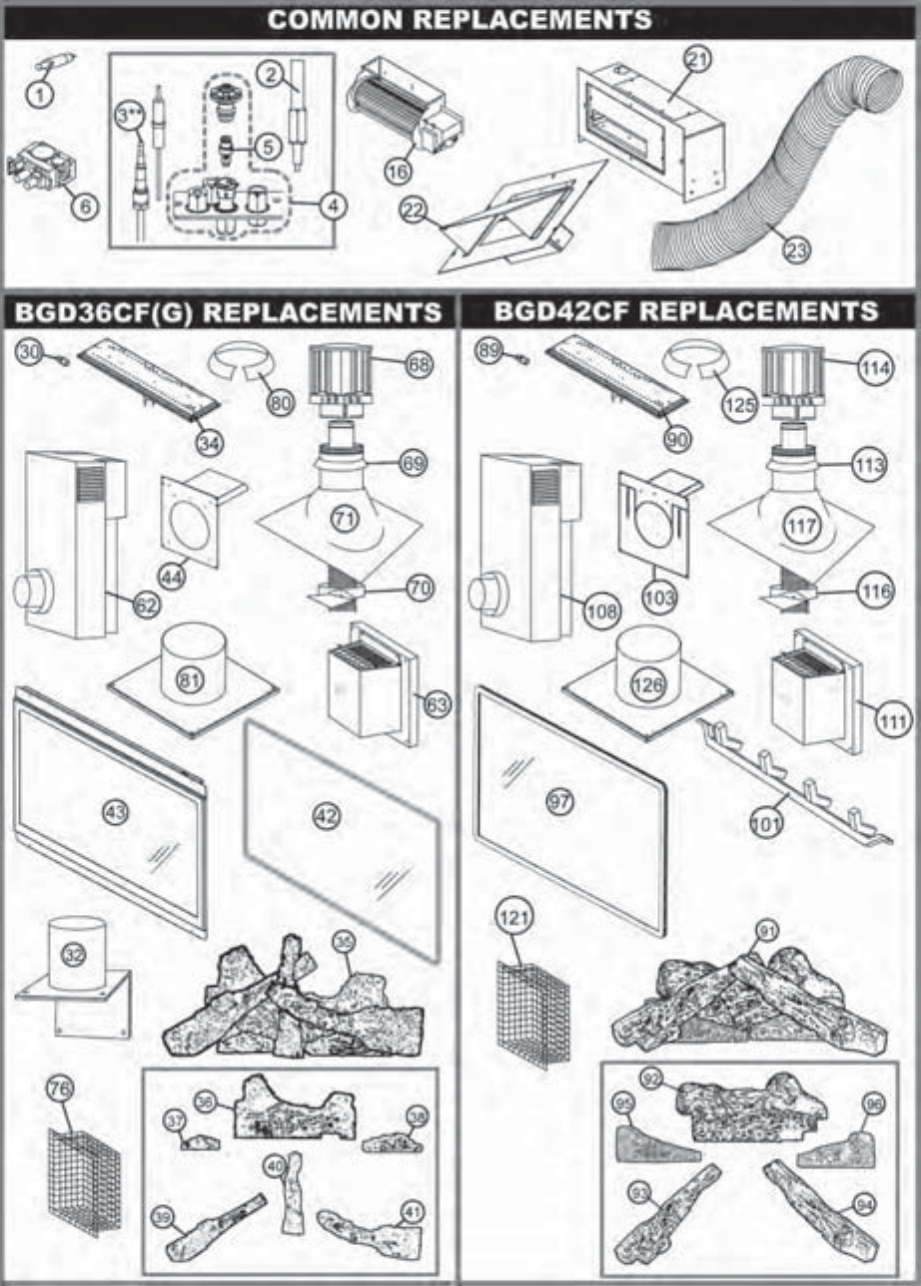
44
W415-0661 / C / 02.20.08
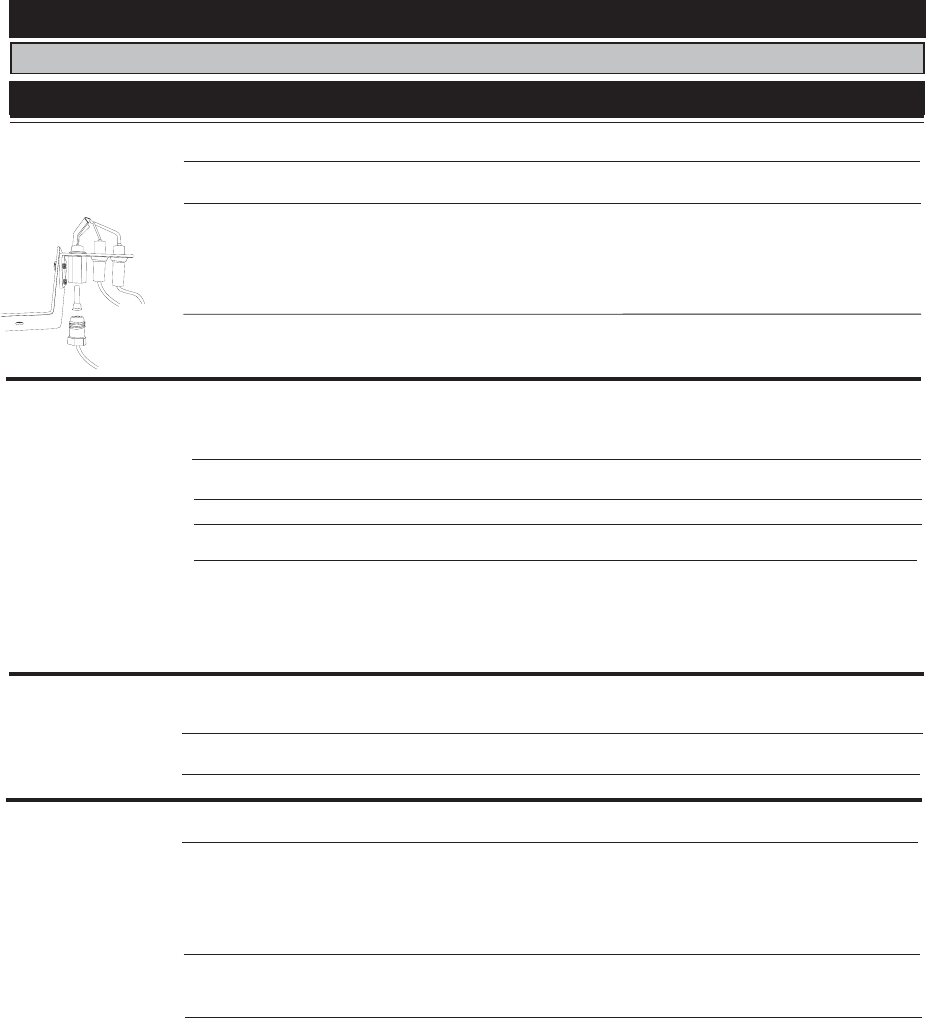
45
W415-0661 / C / 02.20.08
Pilot will not light.
V
erify the "S" wire for the sensor and the "I" wire for the ignitor are connected
to the correct terminals (not reverse) on the module and pilot assembly.
Verify no loose connections, electrical shorts in the wiring or ground out to
any metal object.
Turn the ON/OFF switch to the "OFF" position. Remove the igniter wire "I"
from the module. Place the ON/OFF switch to the "ON" position. Hold a
grounded wire about 3/16" away from the "I" terminal on the module. If no
spark the "I" terminal module must be replaced. If there is a spark the "I"
terminal is fi ne. Inspect pilot assembly for a shorted wire or cracked insulator
around the electrode.
Makes noise with no
spark at pilot burner
- Igniter Spark gap is
incorrect
- spark gap of the ignitor to the pilot should be .17" tor 1/8"
- fi ll the tank.
- Out of propane gas.
BGD36CFG TROUBLE SHOOTING GUIDE
BEFORE ATTEMPTING TO TROUBLESHOOT, PURGE YOUR UNIT AND INITIALLY LIGHT THE PILOT AND THE MAIN BURNER WITH THE GLASS DOOR REMOVED.
SYMPTOM PROBLEM TEST SOLUTION
Pilot will not light.
V
erify the transformer is installed and plugged into the module. Check volt-
age of the transformer under load at the spade connections on the module
with the ON/OFF switch in the "ON" position. Acceptable readings of a good
transformer are between 3.2 and 2.8 volts A.C.
Remove and reinstall the wiring harness that plugs into the module. Remove
and verify continuity of each wire in wiring harness.
Troubleshoot the system with the simplest ON/OFF switch
Verify the value and pilot assemblies are properly grounded to the metal
chassis of the fi replace or log set.
Turn the ON/OFF switch to the "OFF" position. Remove the igniter wire "I"
from the module. Place the ON/OFF switch to the "ON" position. Hold a
grounded wire about 3/16" away from the "I" terminal on the module. If no
spark the "I" terminal module must be replaced. If there is a spark the "I"
terminal is fi ne. Inspect pilot assembly for a shorted wire or cracked insulator
around the electrode.
Makes no noise with no
spark at pilot burner
Verify all connections. Verify the connections from the pilot assembly are tight;
also verify these connections are not grounding out to any metal.
Verify the fl ame is engulfi ng the sensor rod. This will increase the fl ame
rectifi cation. Verify correct pilot orfi ce is installed and inlet gas specifi cations
to manual. (Remember, the fl ame carries the rectifi cation current, not the
gas. If the fl ame lifts from pilot hood, the circuit is broken. A wrong orfi ce or
too high of an inlet pressure can cause the pilot fl ame to lift.) The sensor rod
may need cleaning.
Verify that the wire harness is fi rmly connected to module
Verify that the ceramic insulator around the sensor rod is not cracked, dam-
aged, or loose. Verify the connection from the sensor rod to the sensor wire.
Clean sensor rod with an emery cloth to remove any contamination that may
have accumulated on the sensor rod. Verify continuity with multimeter with
ohms set at the lowest range.
Continues to sparks
and pilot lights, but
main burner will not
light
Verify that the incoming gas line ball valve is "Open". Verify that the inlet
pressure reading is within acceptable limits, inlet pressures must not exceed
14" W.C.
Pilot sparks but will not light
- Transformer
-
A shorted or loose
Connection
- Improper switch wiring
- Faulty module
- Short or loose
connection in sensor rod
- Module is not grounded
- W
iring
- Loose connection
- Module
- Poor fl ame rectifi cation
or contaminated
sensor rod
- Poor grounding between
pilot assembly and
gas valve
- Damaged pilot or dirty
sensor rod
- Gas supply
Verify the value and pilot assemblies are properly grounded to the metal
chassis of the fi replace or log set.
- Module is not grounded
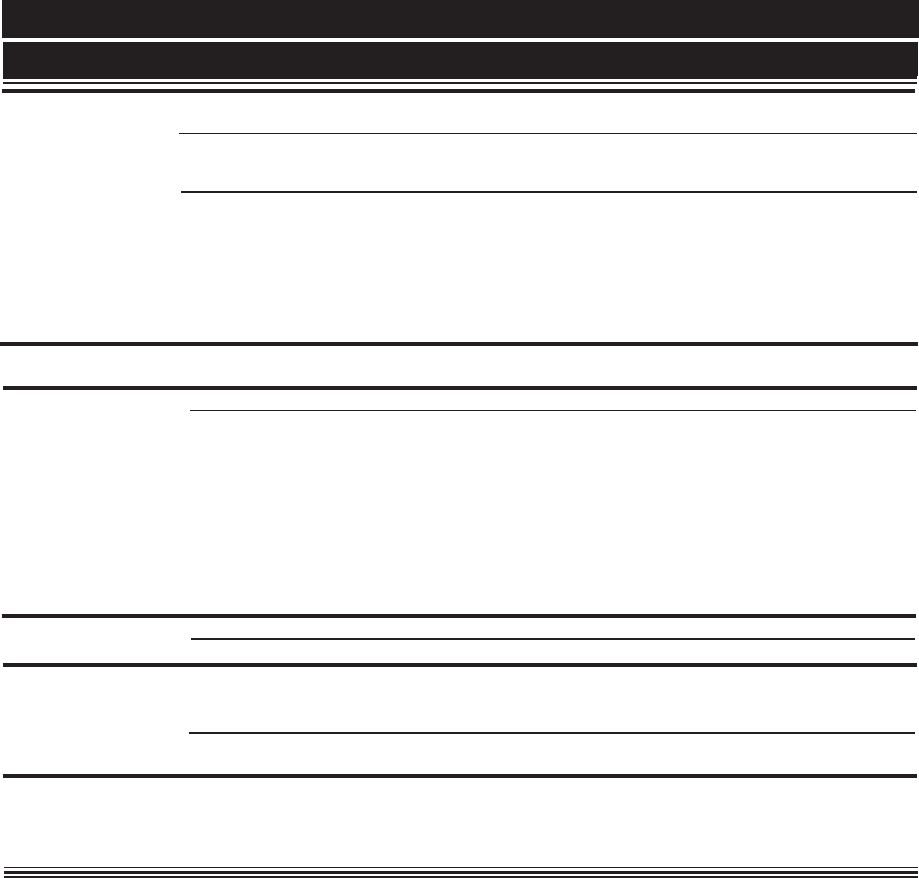
46
W415-0661 / C / 02.20.08
Flames are very aggres-
sive.
- Venting action is too great.
Tighten door clamps
Restrict vent exit with restrictor plate. See Restricting Vents.
- Door is ajar
Main burner flame is a
blue, lazy, transparent
fl ame.
- Blockage in vent. Remove blockage. In really cold conditions, ice buildup may occur on
the terminal and should be removed as required.
Refer to Figure 24 to ensure correct location of storm collars.
- Incorrect installation (vertical
termination only).
White / grey fi lm forms.
- Sulphur from fuel is being de
posited on glass, logs or
combustion chamber
surfaces.
Clean the glass with a recommended gas fi replace glass cleaner. DO
NOT CLEAN GLASS WHEN HOT.
If deposits are not cleaned off regularly, the glass may become perma-
nently marked.
- Wiring / Connection
Pilot lights
Stops sparking
/ pilot remains lit
but burner will
not turn on
Inspect all wires, ensure good tight connections. Verify that all wiring is
installed exactly as specifi ed.
SYMPTOM PROBLEM TEST SOLUTION
- Wiring harness
Inspect the wiring harness, and verify the harness is tightly connected
to the module. Verify that you have 7 wires and they are connected in
the right order.
- Module or Valve
Conduct the following test to verify if the problem is the module or valve.
To measure voltages, turn multimeter to "DC" place the red lead from
multimeter on the screw on the terminal block for the wire you are check-
ing, touch black lead to ground (valve body).
Importantly, a "Zero" volts reading does not automatically indicate a bad
module, there may be too little resistance in the valve solenoid. Check
the Green wire disconnected from valve that the voltage output from the
module should be between 2 and 3 volts
Exhaust fumes smelled in
room, headaches.
Check all seals.
- Fireplace is spilling.
Carbon is being deposited
on glass, logs or combus-
tion chamber surfaces.
- Flame is impinging on the
logs or combustion chamber.
Check that the logs are correctly positioned.
Open air shutter to increase the primary air.
Check the input rate: check the manifold pressure and orifi ce
size as specifi ed by the rating plate values.
Check that the door gasketing is not broken or missing and
that the seal is tight.
Check that both vent liners are free of holes and well sealed
at all joints.
Check that minimum rise per foot has been adhered to for
any horizontal venting.
- Air shutter has become blocked
Ensure air shutter opening is free of lint or other obstructions.
BGD36CFG TROUBLE SHOOTING GUIDE

47
W415-0661 / C / 02.20.08
Main burner goes out;
pilot stays on.
Pilot fl ame is not large enough or
not engulfi ng the thermopile
- turn up pilot fl ame.
- replace pilot assembly.
Thermopile shorting - clean thermopile connection to the valve. Reconnect.
- replace thermopile / valve.
Remote wall switch wire is too
long; too much resistance in the
system.
- shorten wire to correct length or wire gauge.
Faulty thermostat or switch.
- replace.
Main burner goes out;
pilot goes out.
Refer to "MAIN BURNER GOES OUT; PILOT STAYS ON"
Vent is blocked
Vent is re-circulating
- check for vent blockage.
- check joint seals and installation.
4" fl exible vent has become dis-
connected from fi replace.
- re-attach to fi replace.
- 7"ø cap was not replaced
Pilot will not light. - check if pilot can be lit by a match
- check that the wire is connected to the push button igniter.
- check if the push button igniter needs tightening.
- replace the wire if the wire insulation is broken or frayed.
- replace the electrode if the ceramic insulator is cracked or broken.
- replace the push button igniter.
No spark at pilot burner
- fi ll the tank.
Out of propane gas
Spark gap is incorrect
- spark gap should be 0.150" to 0.175" (5/32" to 11/64" approx.) from the electrode
tip and the pilot burner. To ensure proper electrode location, tighten securing nut
(fi nger tight plus 1/4 turn).
No gas at the pilot burner
- check that the manual valve is turned on.
- check the pilot orifi ce for blockage.
- replace the valve.
- call the gas distributor.
Pilot goes out when the
gas knob is released.
The gas valve has
an interlock device
which will not allow
the pilot burner to be
lit until the thermo-
couple has cooled.
Allow approximately
60 seconds for the
thermocouple to
cool.
System is not correctly purged.
- purge the gas line.
Out of propane gas. - fi ll the tank.
Pilot fl ame is not large enough
- turn up the pilot fl ame.
- gently twist the pilot head to improve the fl ame pattern around the thermo-
couple.
Pilot fl ame is not engulfi ng the
thermocouple.
Thermocouple shorting / faulty.
- loosen and tighten thermocouple.
- clean thermocouple and valve connection.
- replace thermocouple.
- replace valve.
Faulty valve.
- replace.
Pilot burning; no gas to
main burner; gas knob
is on 'HI'; wall switch /
thermostat is on.
Themostat or switch is defec-
tive.
- connect a jumper wire across the wall switch terminals; if main burner lights,
replace switch / thermostat.
Main burner orifi ce is plugged. - remove stoppage in orifi ce.
Faulty valve.
- replace.
Wall switch wiring is defective.
- disconnect the switch wires & connect a jumper wire across terminals 1 & 3; if
the main burner lights, check the wires for defects and / or replace wires.
BGD36CF / BGD42CF TROUBLE SHOOTING GUIDE
BEFORE ATTEMPTING TO TROUBLESHOOT, PURGE YOUR UNIT AND INITIALLY LIGHT THE PILOT AND THE MAIN BURNER WITH THE GLASS DOOR OPEN.
SYMPTOM PROBLEM TEST SOLUTION
Pilot goes out while
standing; Main
burner is in 'OFF'
position.
Gas piping is undersized. - turn on all gas appliances and see if pilot fl ame fl utters, diminishes or
extinguishes, especially when main burner ignites. Monitor appliance
supply working pressure.
- check if supply piping size is to code. Correct all undersized piping.
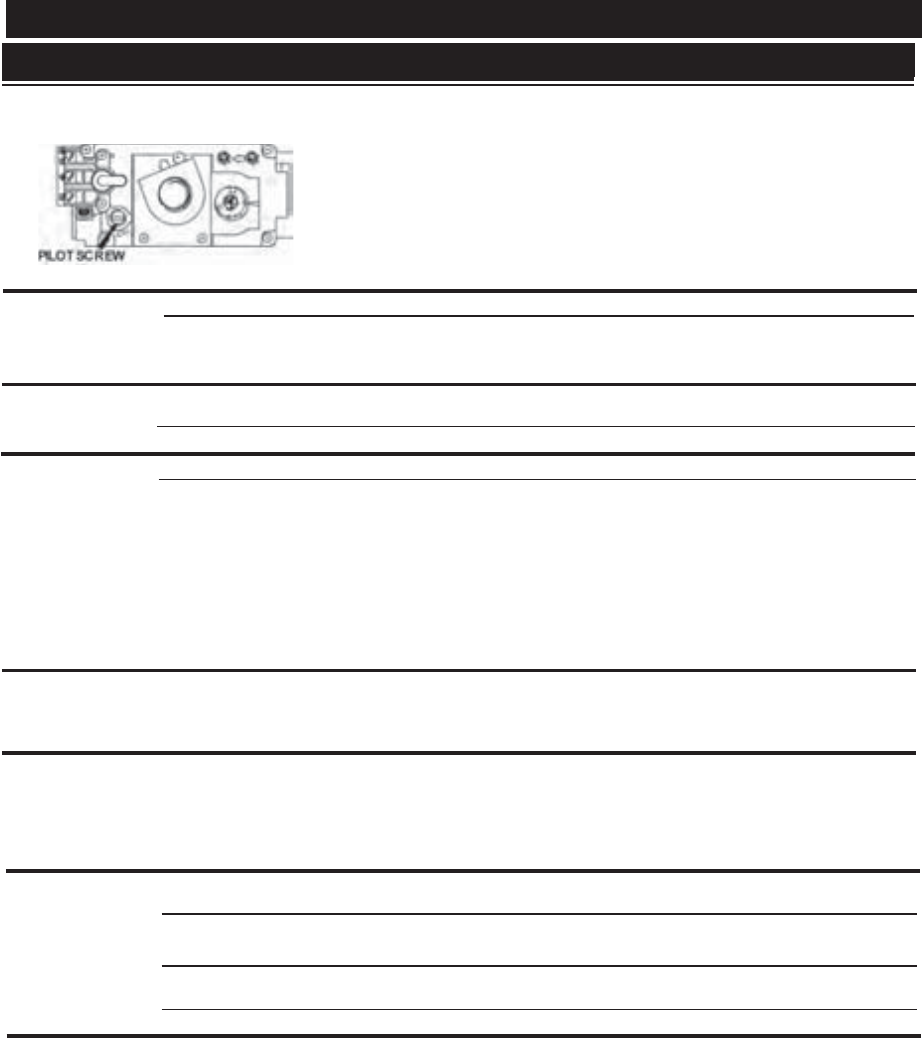
48
W415-0661 / C / 02.20.08
SYMPTOM PROBLEM TEST SOLUTION
Remote wall switch is
in "OFF" position; main
burner comes on when
gas knob is turned to
"ON" position.
Wall switch is mounted upside
down
- reverse.
Faulty valve.
- replace.
- replace.Remote wall switch is ground-
ing.
- check for ground (short); repair ground or replace wire.Remote wall switch wire is
grounding.
White / grey film
forms.
Sulphur from fuel is being depos-
ited on glass, logs or combustion
chamber surfaces.
- clean the glass with a recommended gas fi replace glass cleaner. DO NOT
CLEAN GLASS WHEN HOT.
If deposits are not cleaned off regularly, the glass may become permanently
marked.
Main burner fl ame is a
blue, lazy, transparent
fl ame.
Blockage in vent. - remove blockage. In really cold conditions, ice buildup may occur on the terminal
and should be removed as required.
- refer to Figure ## to ensure correct location of storm collars.
Incorrect installation.
Carbon is being de-
posited on glass, logs
or combustion cham-
ber surfaces.
Flame is impinging on the logs or
combustion chamber.
- check that the logs are correctly positioned.
- open air shutter to increase the primary air.
- check the input rate: check the manifold pressure and orifi ce size as specifi ed
by the rating plate values.
- check that the door gasketing is not broken or missing and that the seal is
tight.
- check that both 4"/5" and 7" vent liners are free of holes and well sealed at
all joints.
- check that minimum rise per foot has been adhered to for any horizontal vent-
ing.
Air shutter has become blocked
- ensure air shutter opening is free of lint or other obstructions.
Flames are consist-
ently too large or too
small. Carboning oc-
curs.
- check pressure readings:
Inlet pressure can be checked by turning screw (A) counter-clockwise 2 or 3
turns and then placing pressure gauge tubing over the test point. Gauge should
read 7" (minimum 4.5") water column for natural gas or 13" (11" minimum) water
column for propane. Check that main burner is operating on "HI".
Outlet pressure can be checked the same as above using screw (B). Gauge
should read 3.5" water column for natural gas or 10" water column for propane.
Check that main burner is operating on "HI".
AFTER TAKING PRESSURE READINGS, BE SURE TO TURN SCREWS CLOCK-
WISE FIRMLY TO RESEAL. DO NOT OVER TORQUE.
Leak test with a soap and water solution.
Unit is over-fi red or under-fi red.
Exhaust fumes
smelled in room,
headaches.
Fireplace is spilling. - ensure exhaust bracket gasket seal
- check door seal and relief fl ap seal.
- check for chimney blockage
- check that chimney is installed to building code.
- room is in negative pressure; increase fresh air supply.
- check 7"ø cap gasket on the fl ue pipe assembly.
- Restrict vent exit. See "RESTRICTING VERTICAL VENTS".
- VENT HEIGHT MORE THAN 15 FEET: restrict vent exit using restrictor plate
kit W500-0205
MODEL BGD42CF ONLY:
Aggressive venting action due to
vent height.
Flames are very ag-
gressive.
- tighten screws holding door in place
Door is ajar
MODEL BGD36CF(G) ONLY:
BGD36CF / BGD42CF TROUBLE SHOOTING GUIDE
